February 3. This morning we wake very early to explore and photograph at amazing Ta Prohm, where jungle tree roots still cover the ruined temples. We get there ahead of the crowds and have relatively unobstructed views. The photos below, all taken on an iPhone, include workmen maintaining the site, women who bless people (for a small contribution), some sculpture, a bit of amazing light and, of course, buildings among the tree roots. This is the most amazing of the sites we’ve seen. 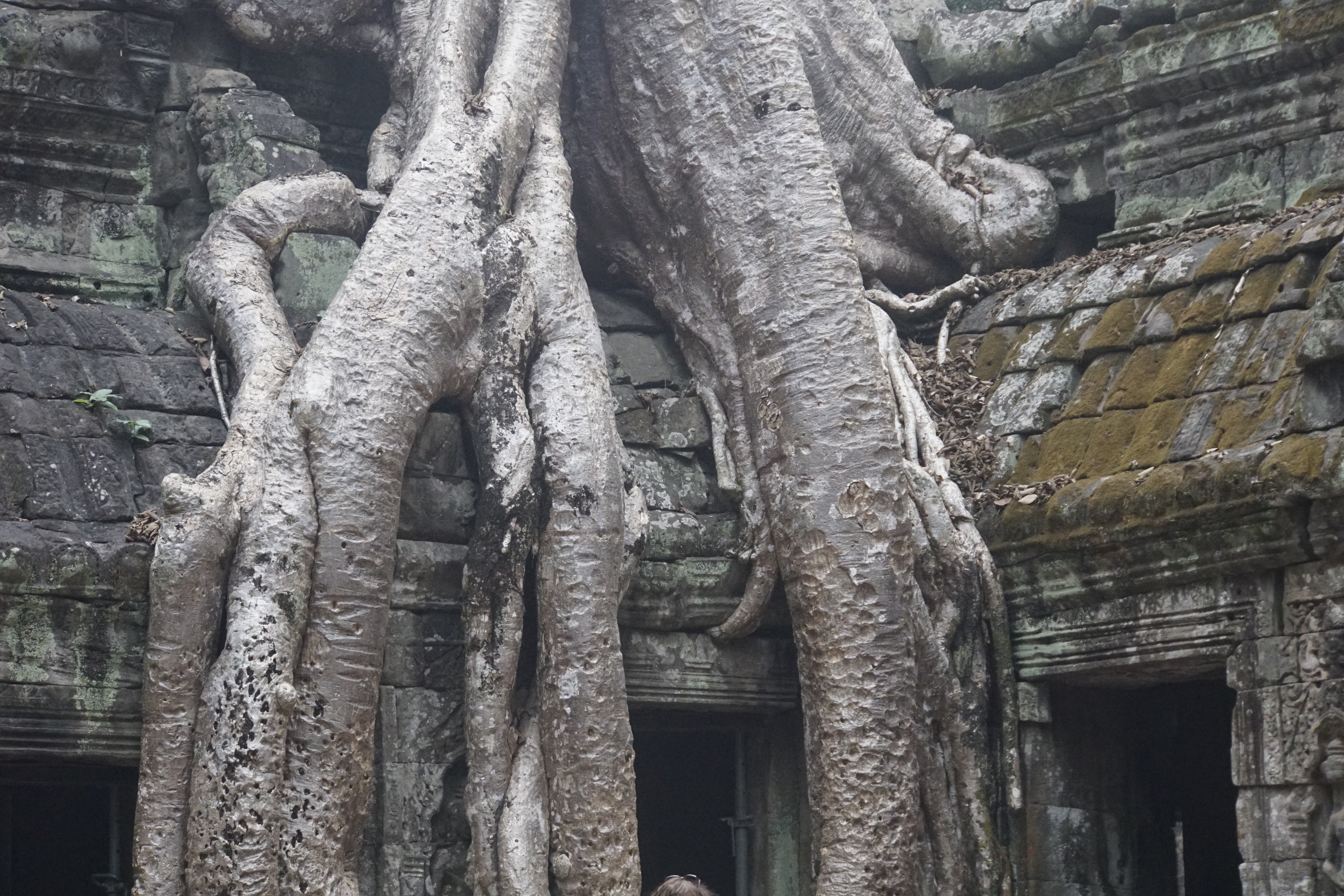 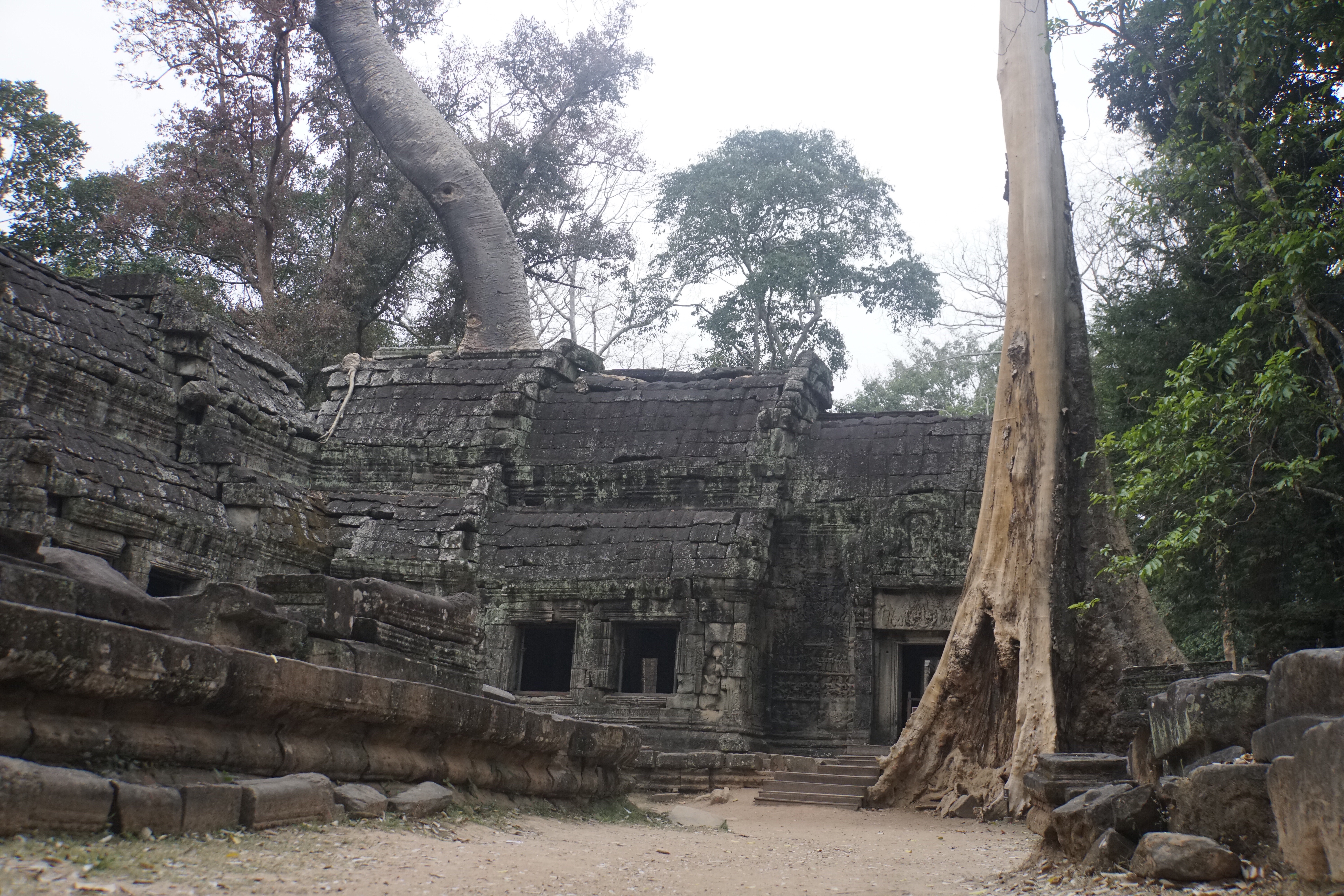 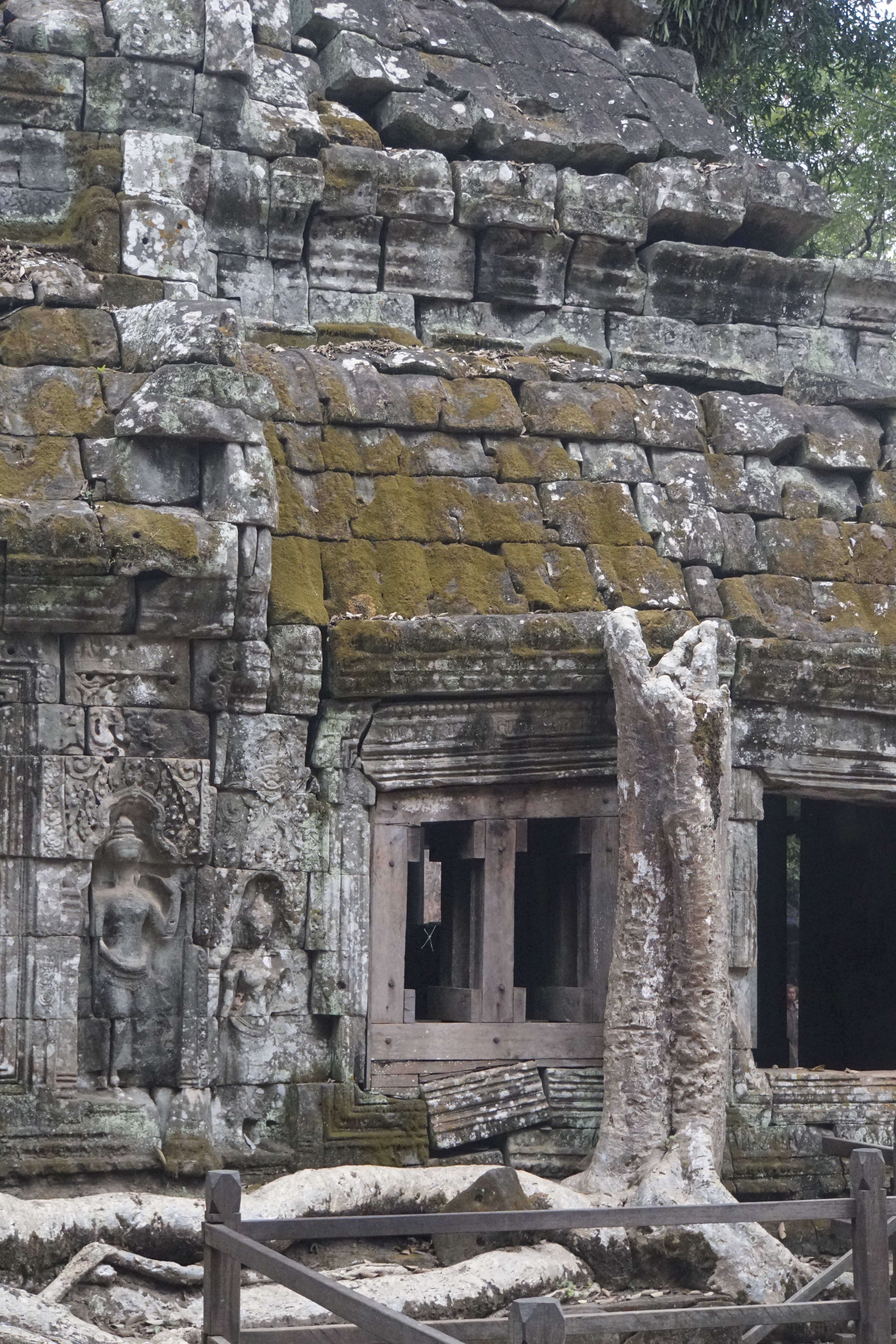 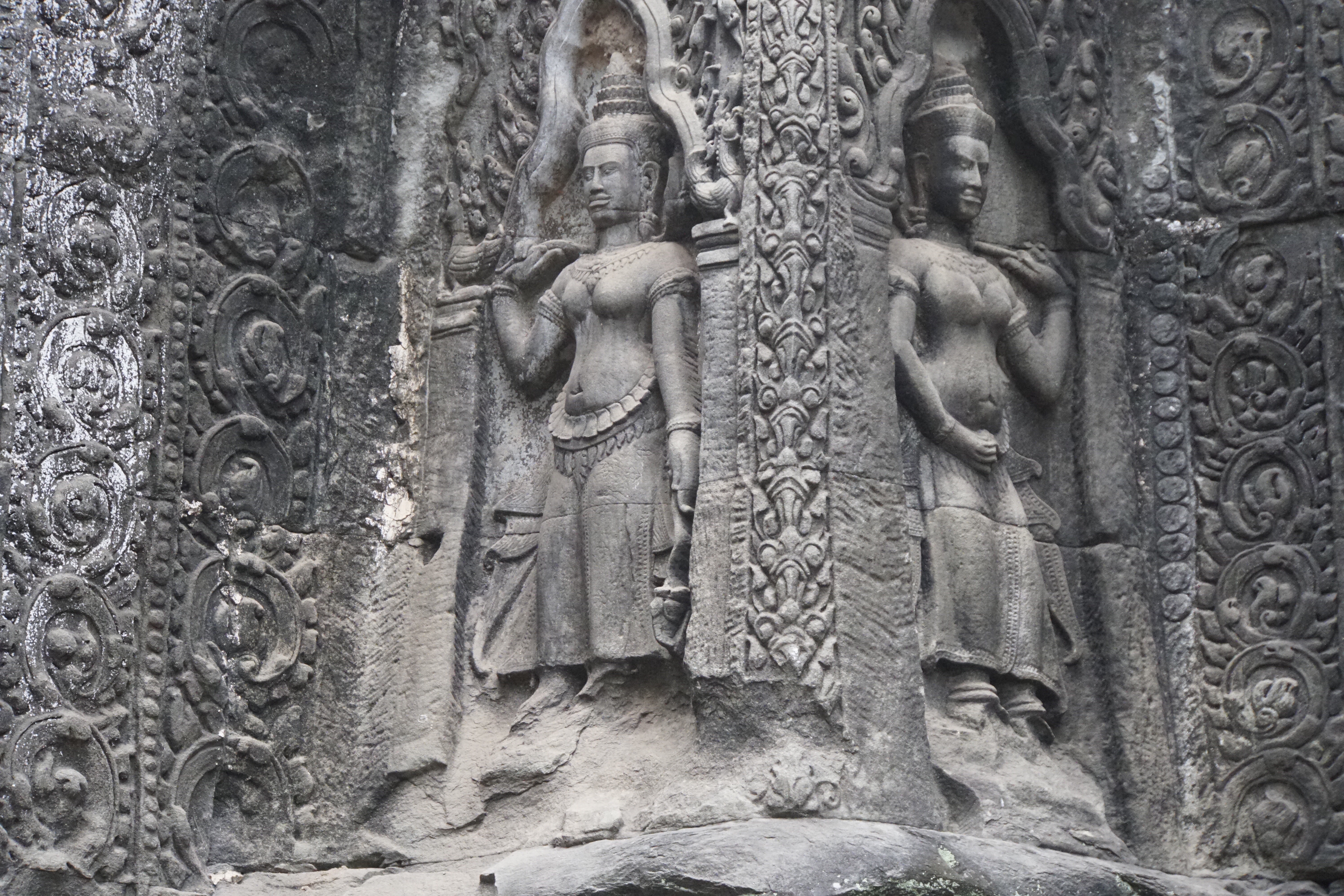 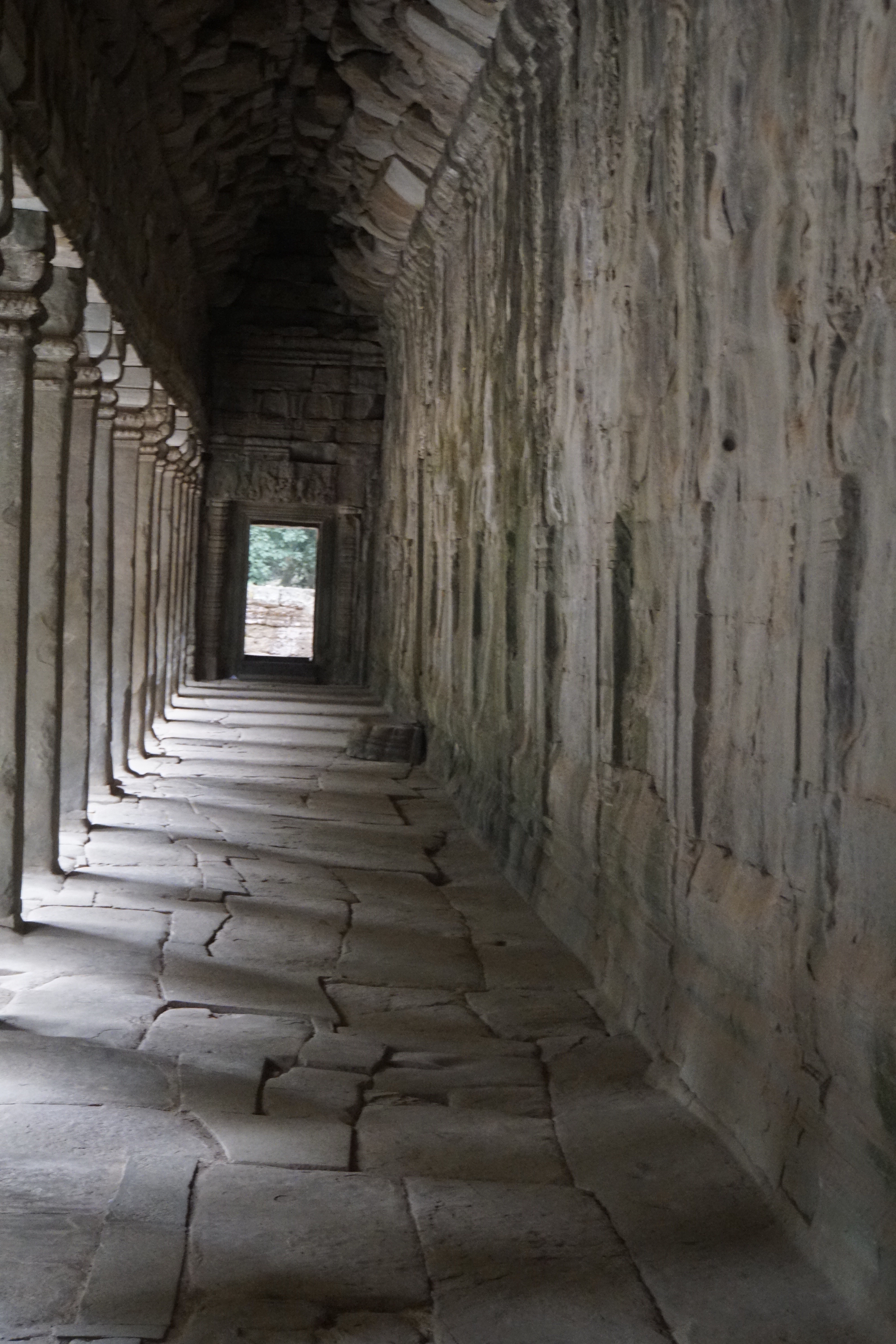 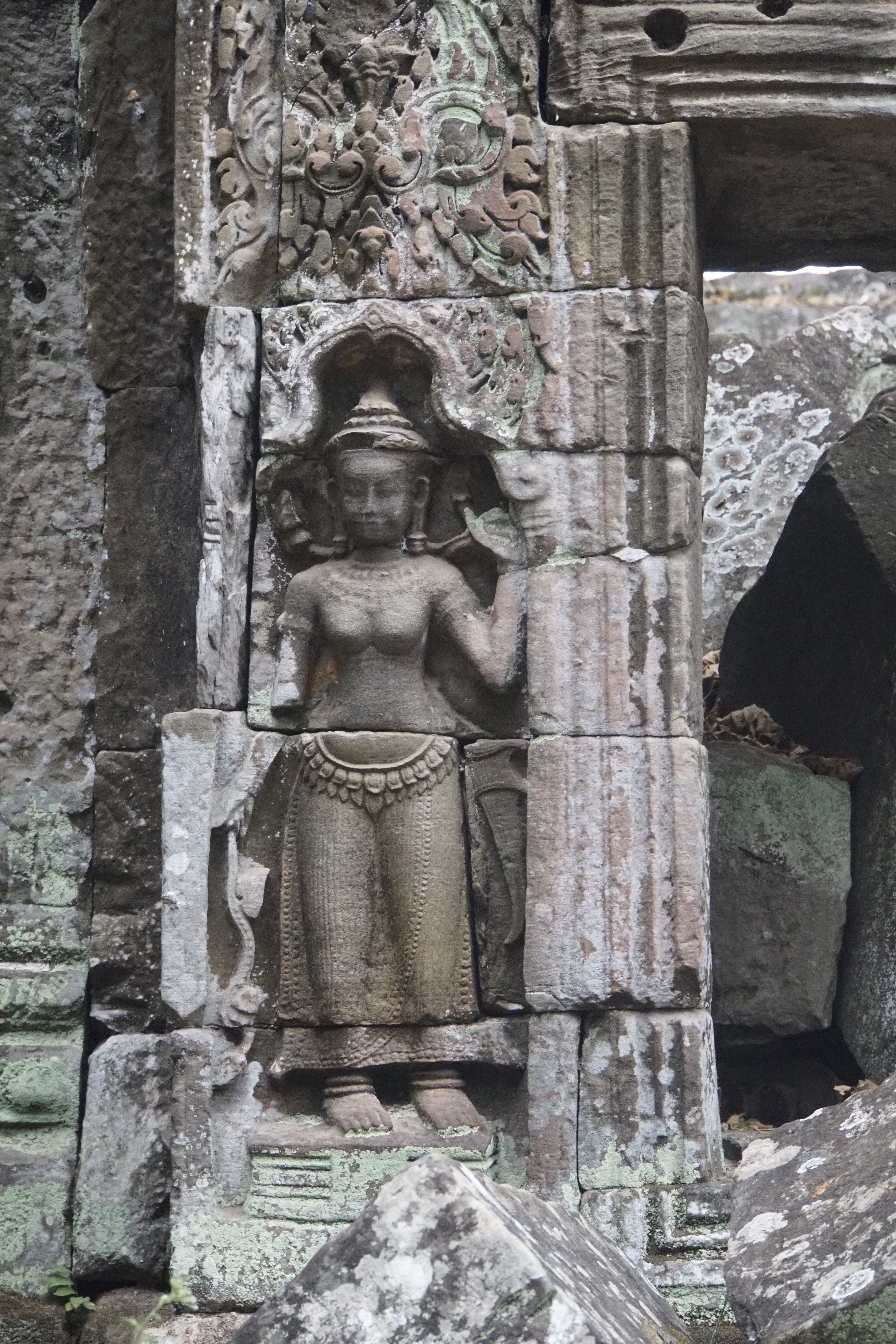
Carol and I set out in our own tuk-tuk for what Karl describes as undiscovered temple ruins. There’s a reason they are undiscovered, because our driver has to ask directions four times, and the half hour trip takes an hour and a half. An adventure, for sure, and rather fun. Pictures below include a view from our vehicle and our driver returning from one of his requests for information. 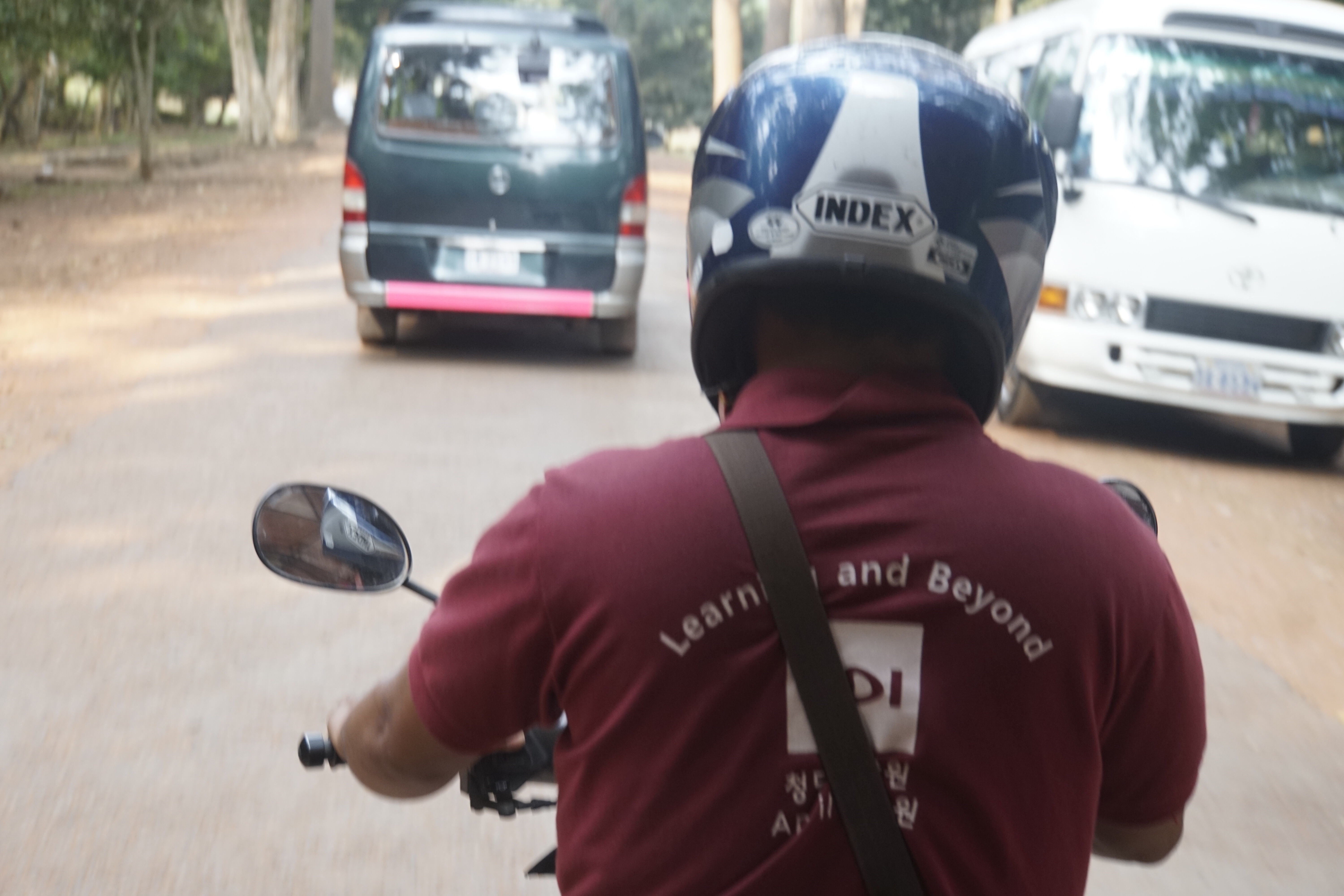 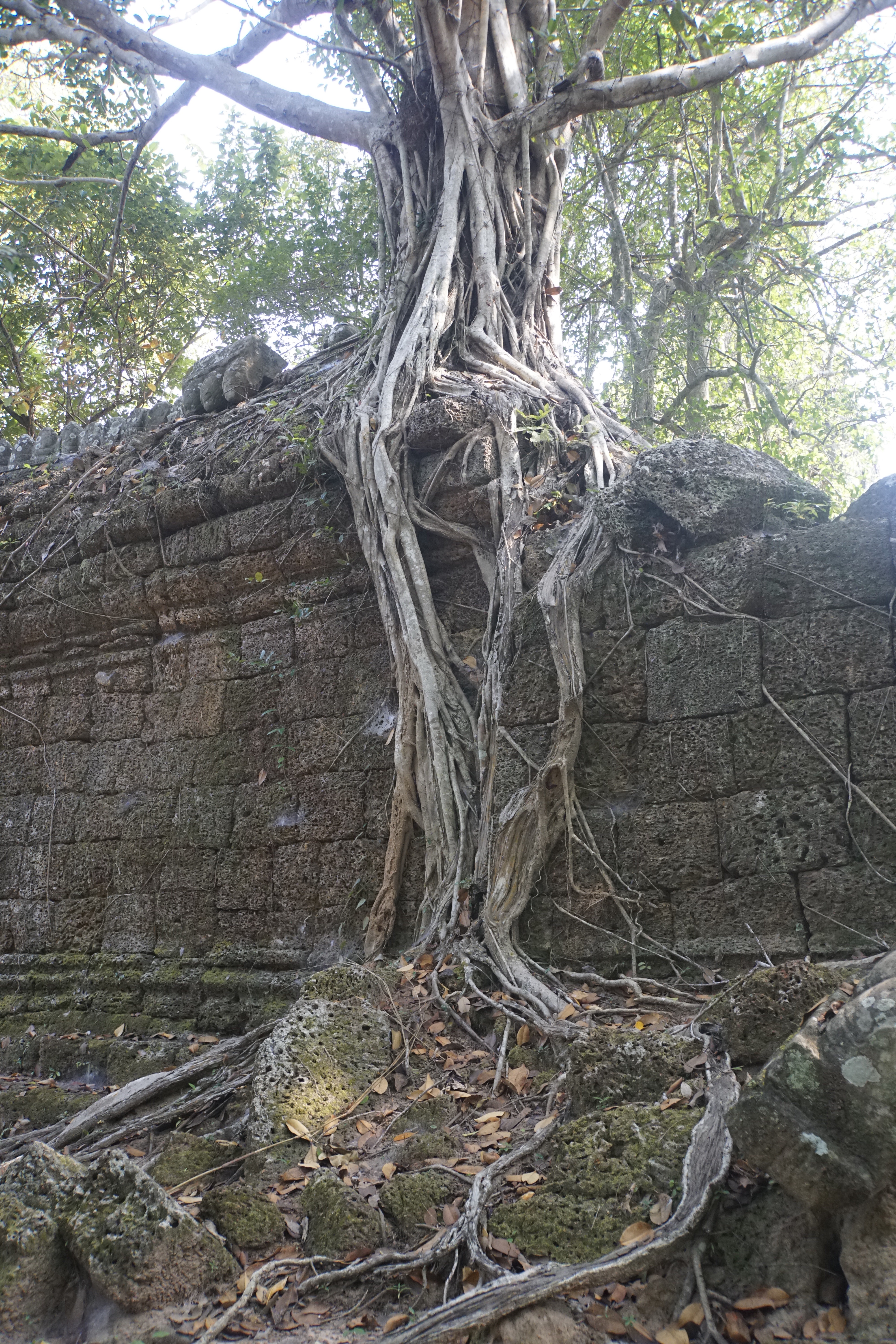 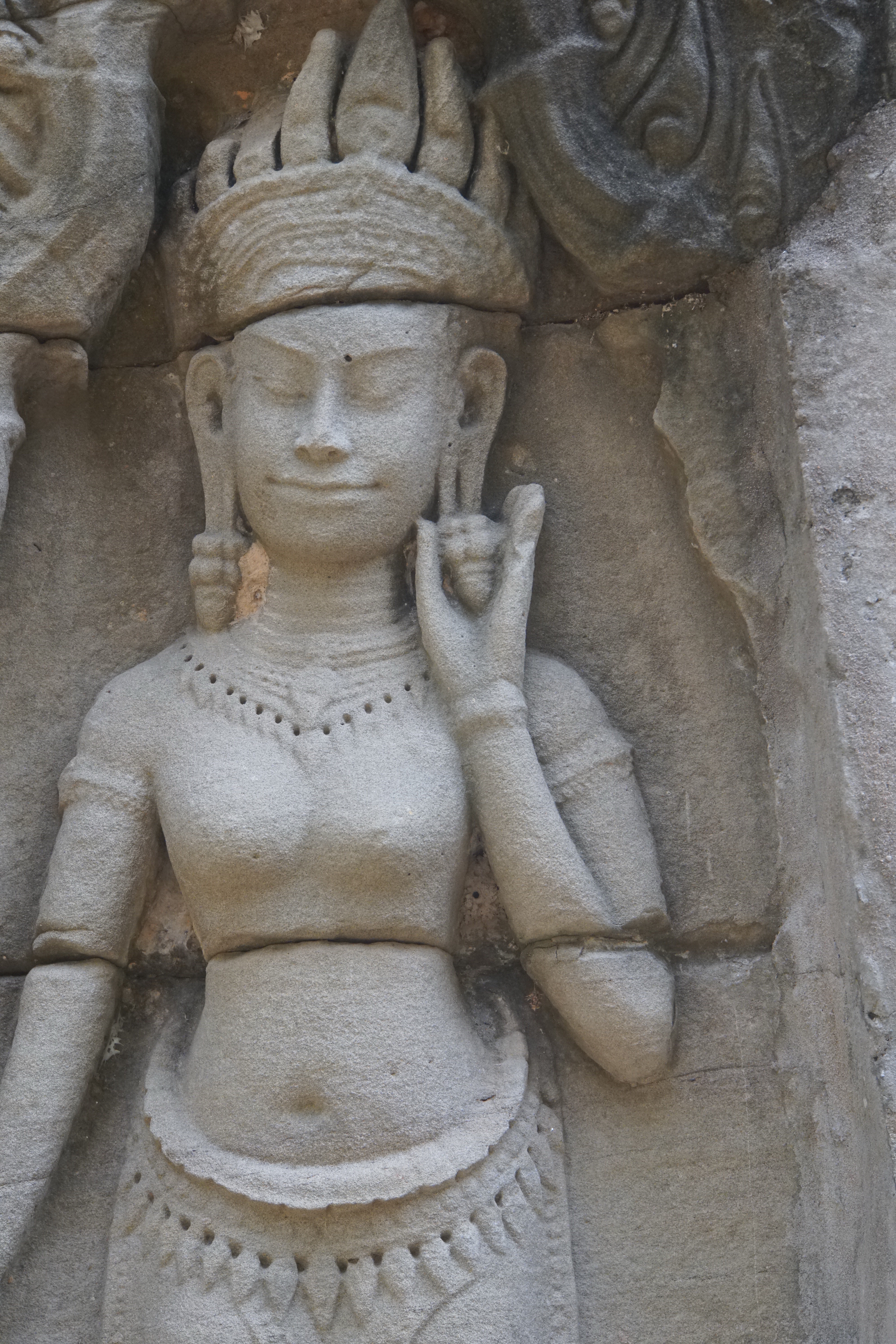 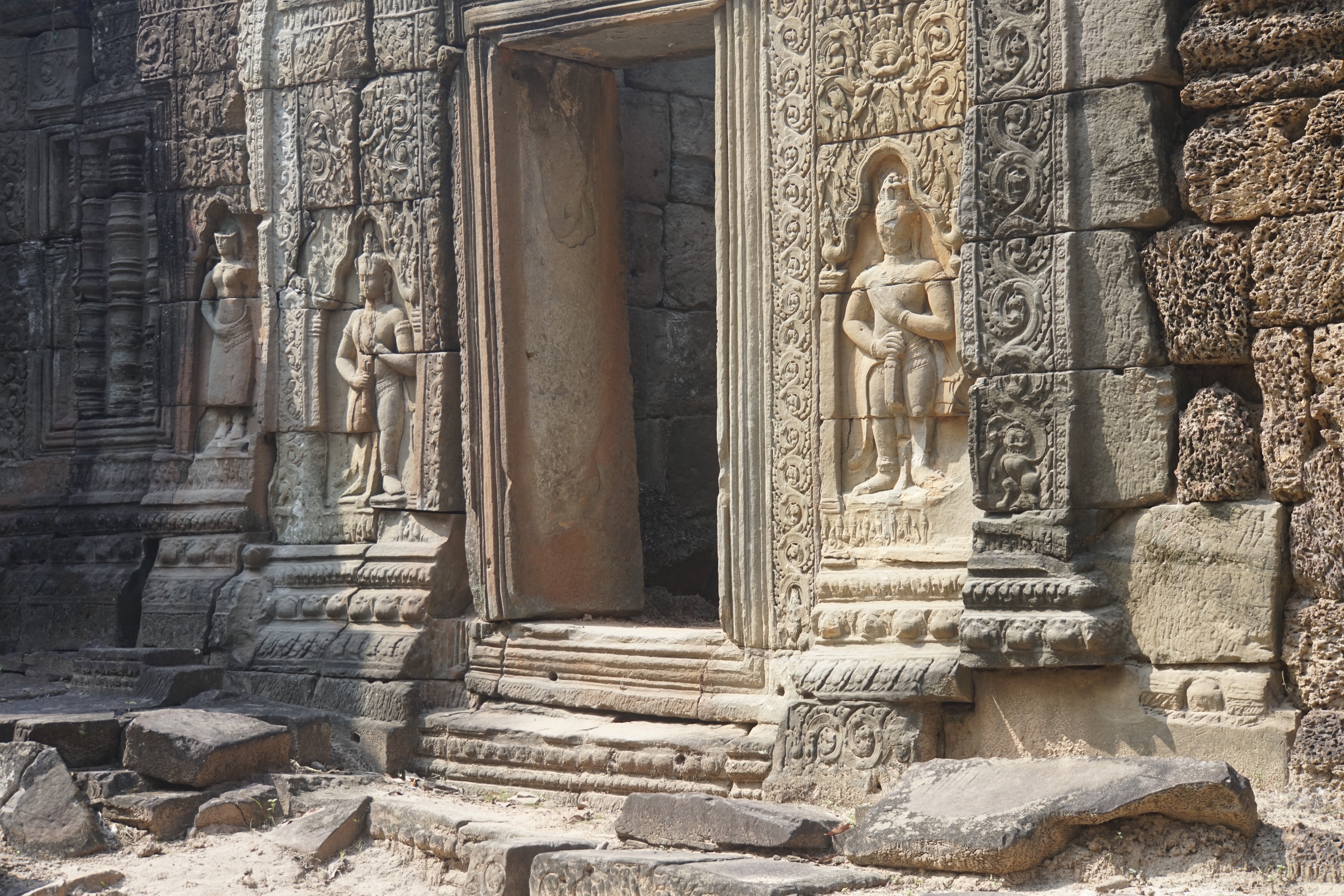
We stop for a rather good cheese and tomato panini lunch, then return to the hotel to Blog, relax, have 90-minute massages (cost: $14) and prepare for our final dinner, a very good one at the Foreign Correspondents Club. From there we go over to Karl’s house to view photos the group took, projected on his large TV. Interesting to see everyone’s work, some of which are a lot better than others. I did not show any, because I couldn’t figure out how to do it from my iPad. Carol also did not show photos, but read drafts of two poems she’d written, which people seemed to enjoy. I read the “real blog” that I traditionally write on these trips, pointing out all the strange/funny things that happened on the trip, with some license for exaggeration. The blog reading was quite well received.
Back to the hotel for preliminary packing and sleep.
February 1. Breakfast at the hotel, then tuk-tuk to Angkor Wat. As we’d been warned, our magical alone time of late yesterday is now shared with thousands of other visitors.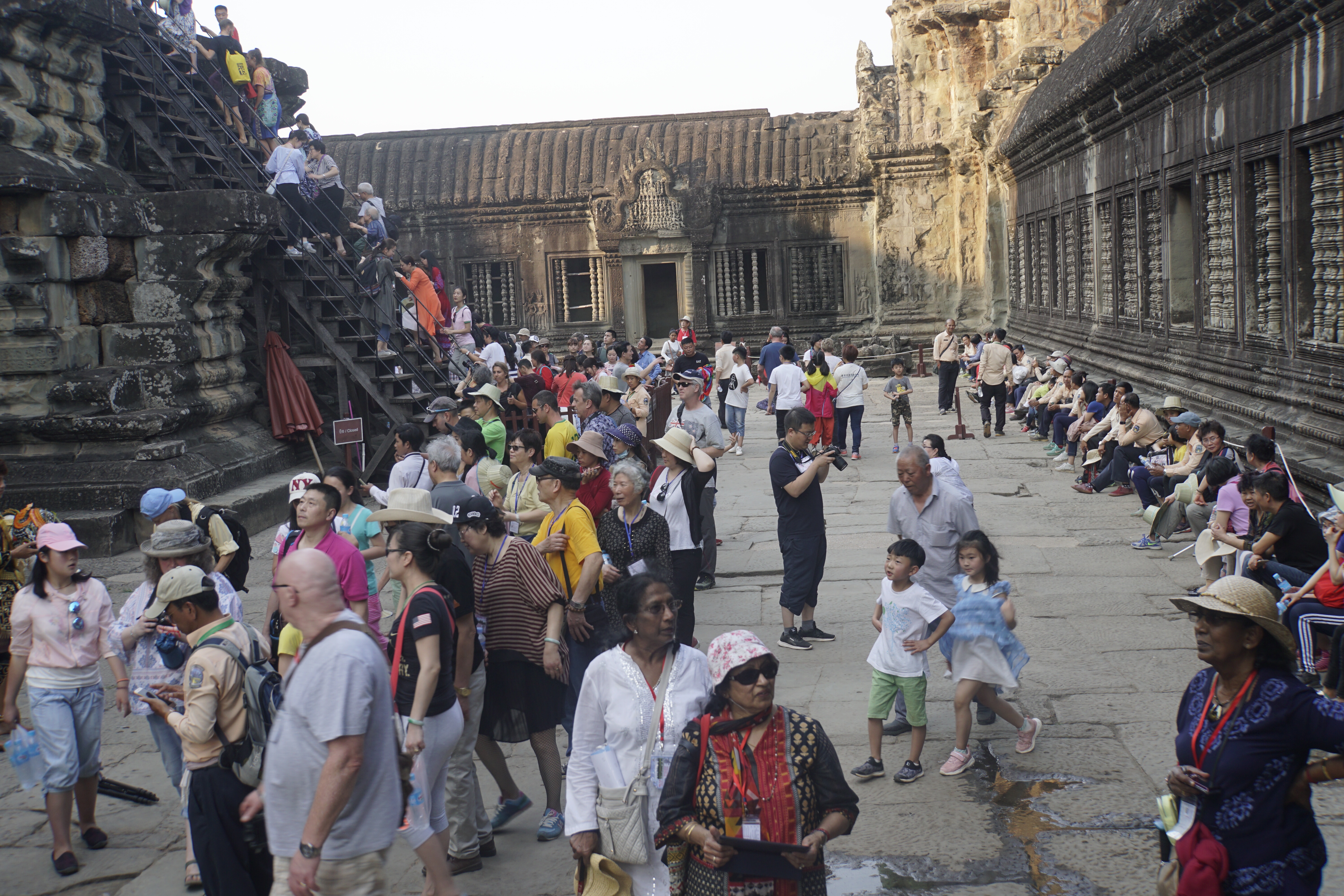
Nonetheless, this is our best day of the trip. It’s impossible to describe or capture in photos the magnitude of Angkor Wat, it’s enormous scope, the setting among trees, sometimes physically attached to trees, the monumental buildings and sculptures, the fine, subtle carvings everywhere, the play of light in passageways. Even the name, Angkor Wat, does not capture it, because Angkor Wat is just one part of the complex of area. The places we visited yesterday and until late this afternoon, were part of an area called Angkor Thom, which is many times larger than Angkor Wat. So, here’s a feeeble attempt to capture a bit of it, including a man being bathed and blessed by a monk, who chants the blessing.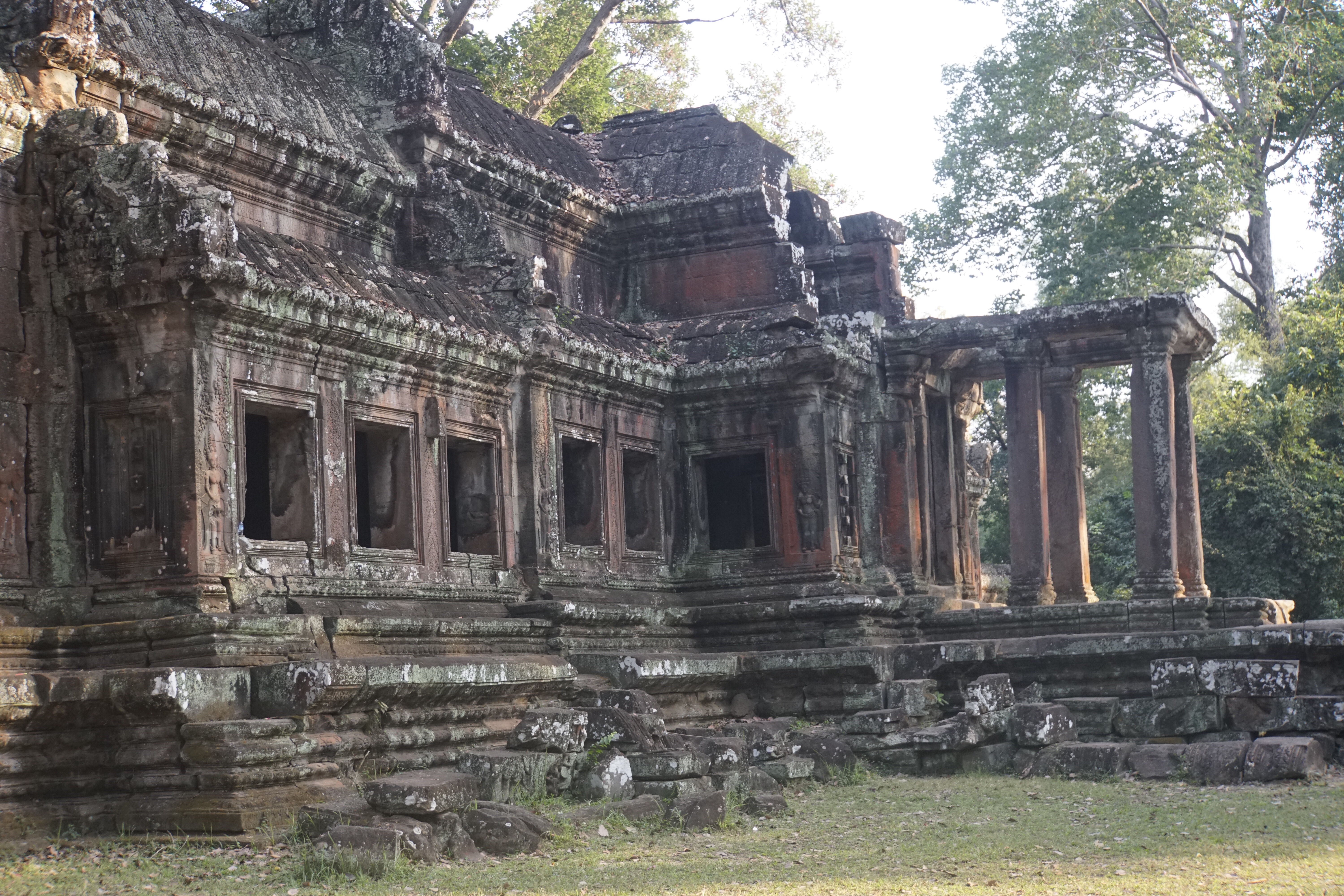 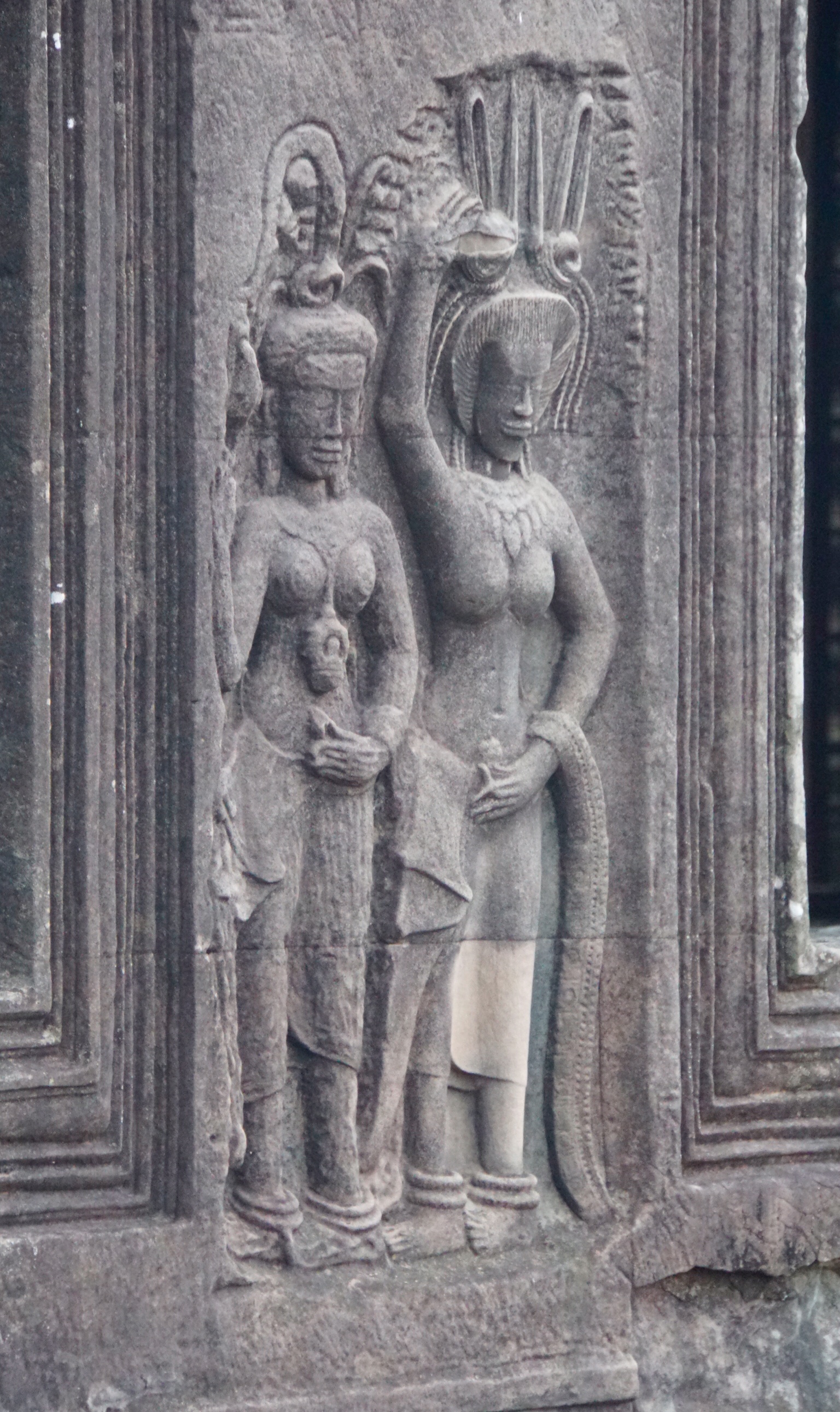 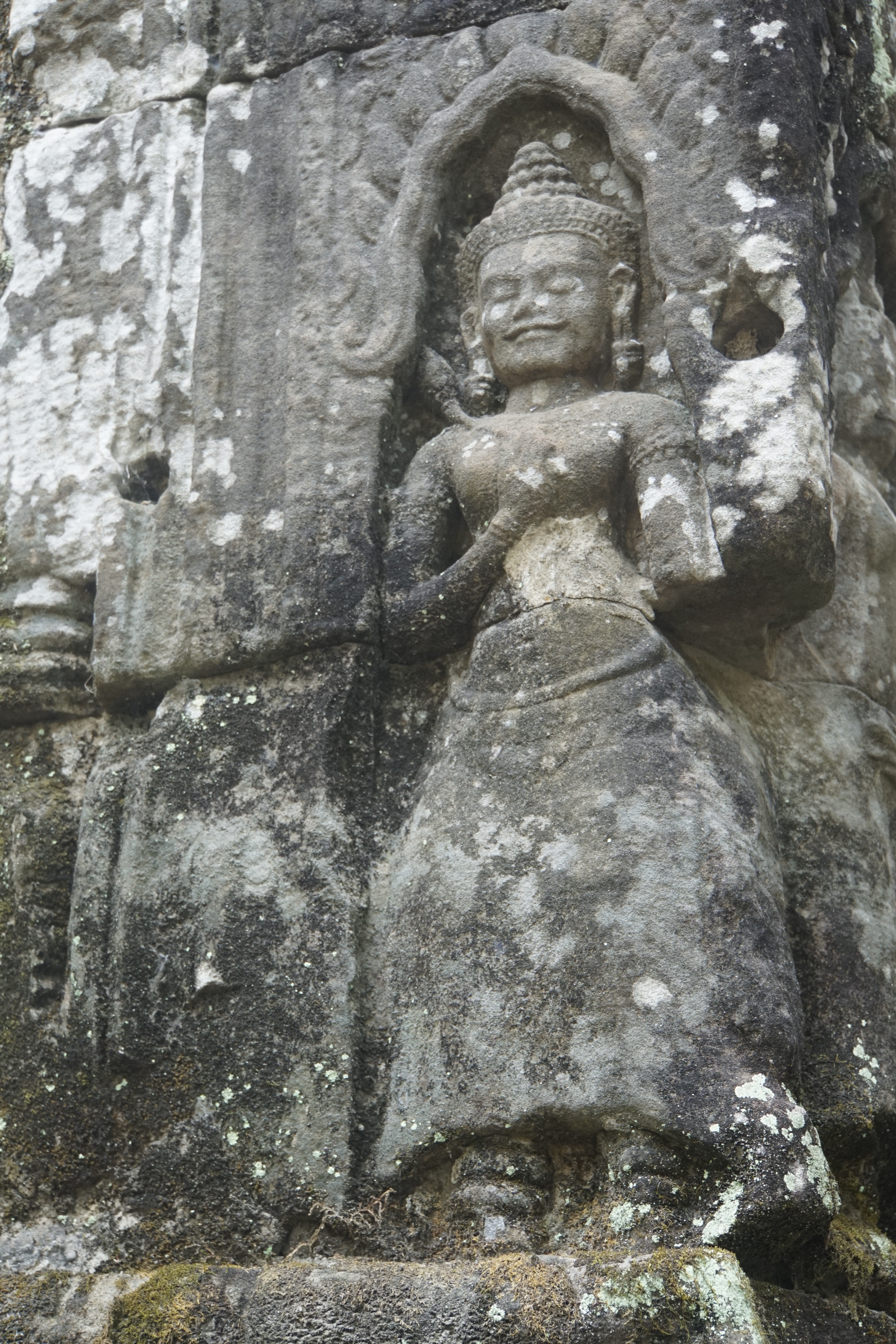 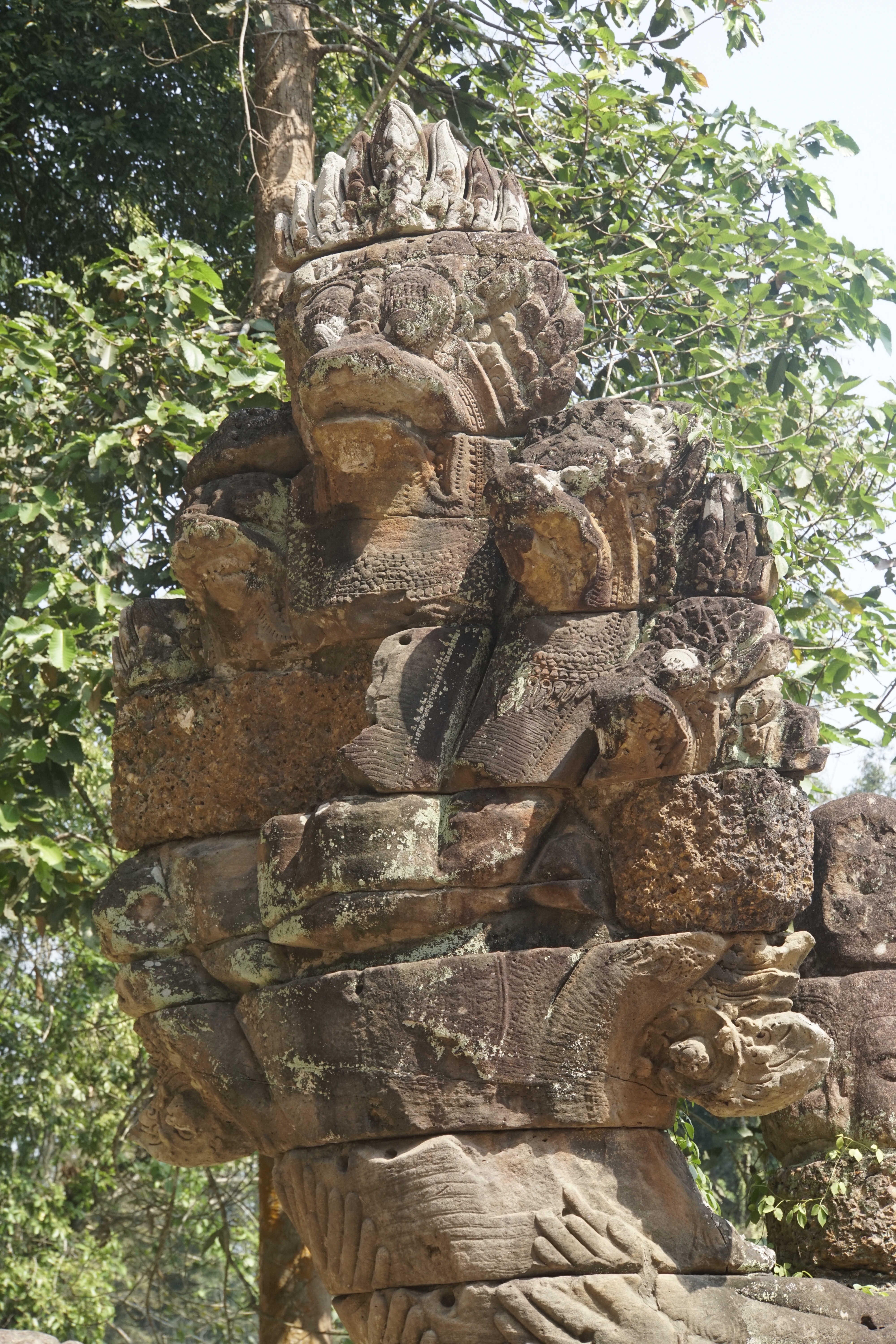 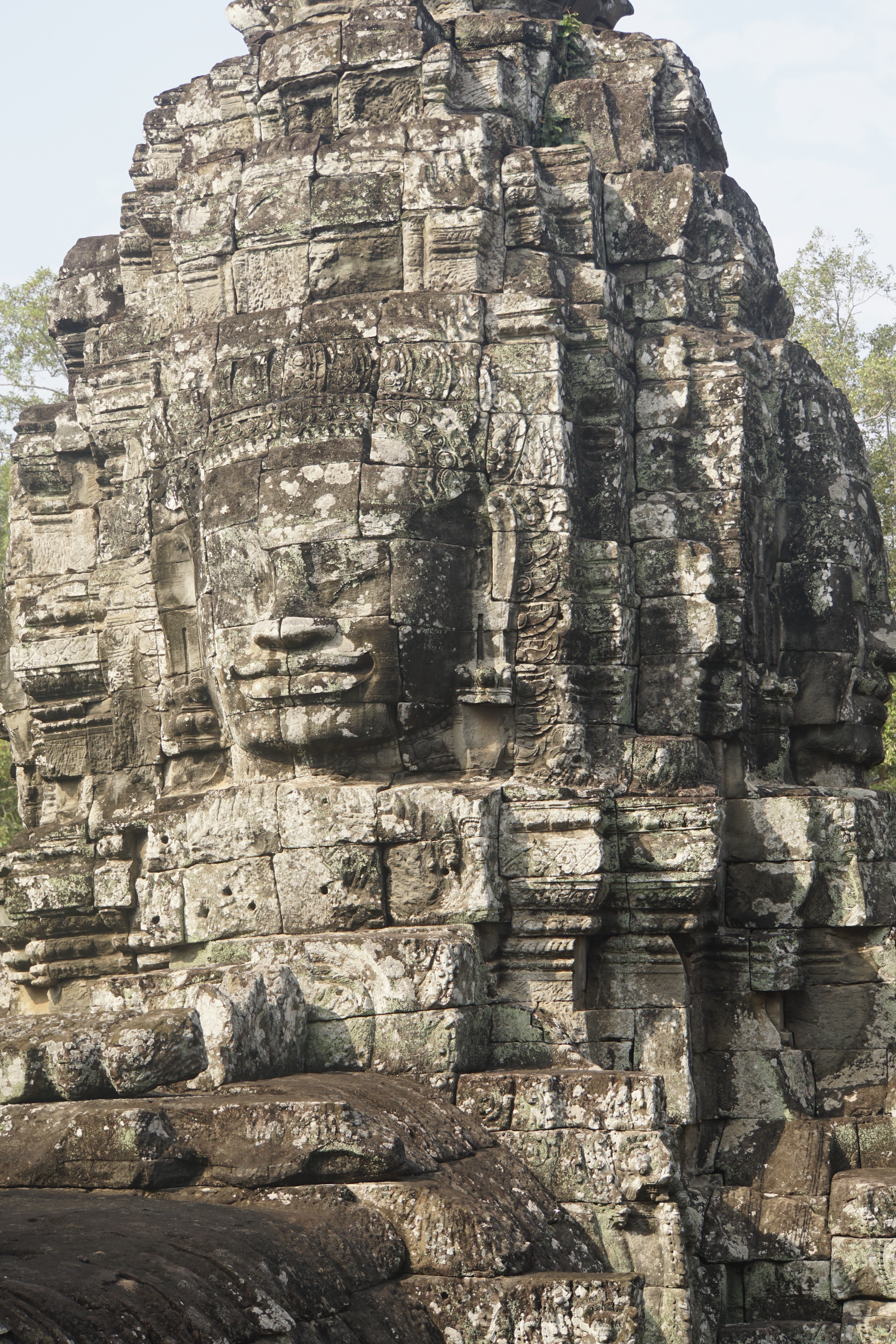  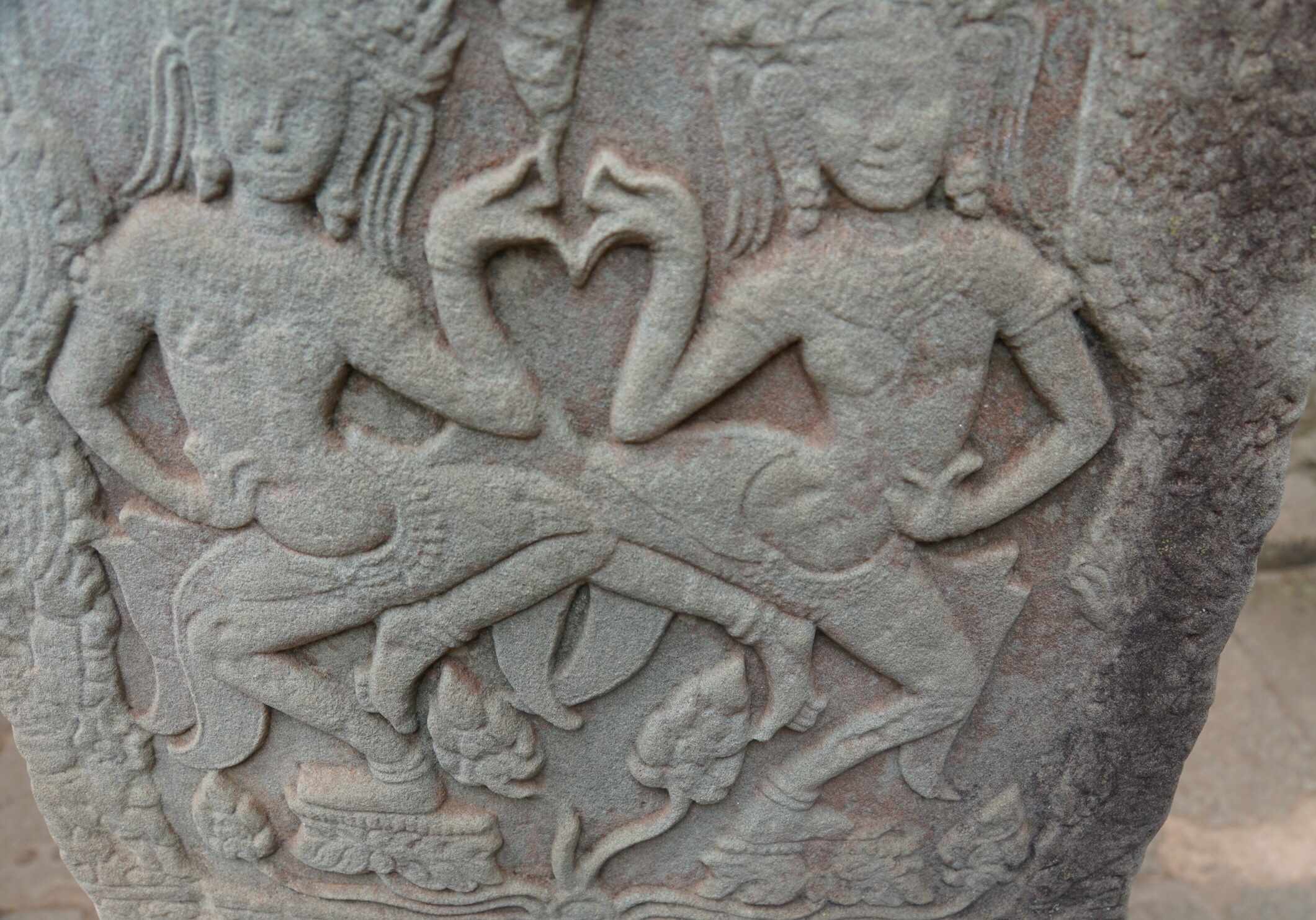 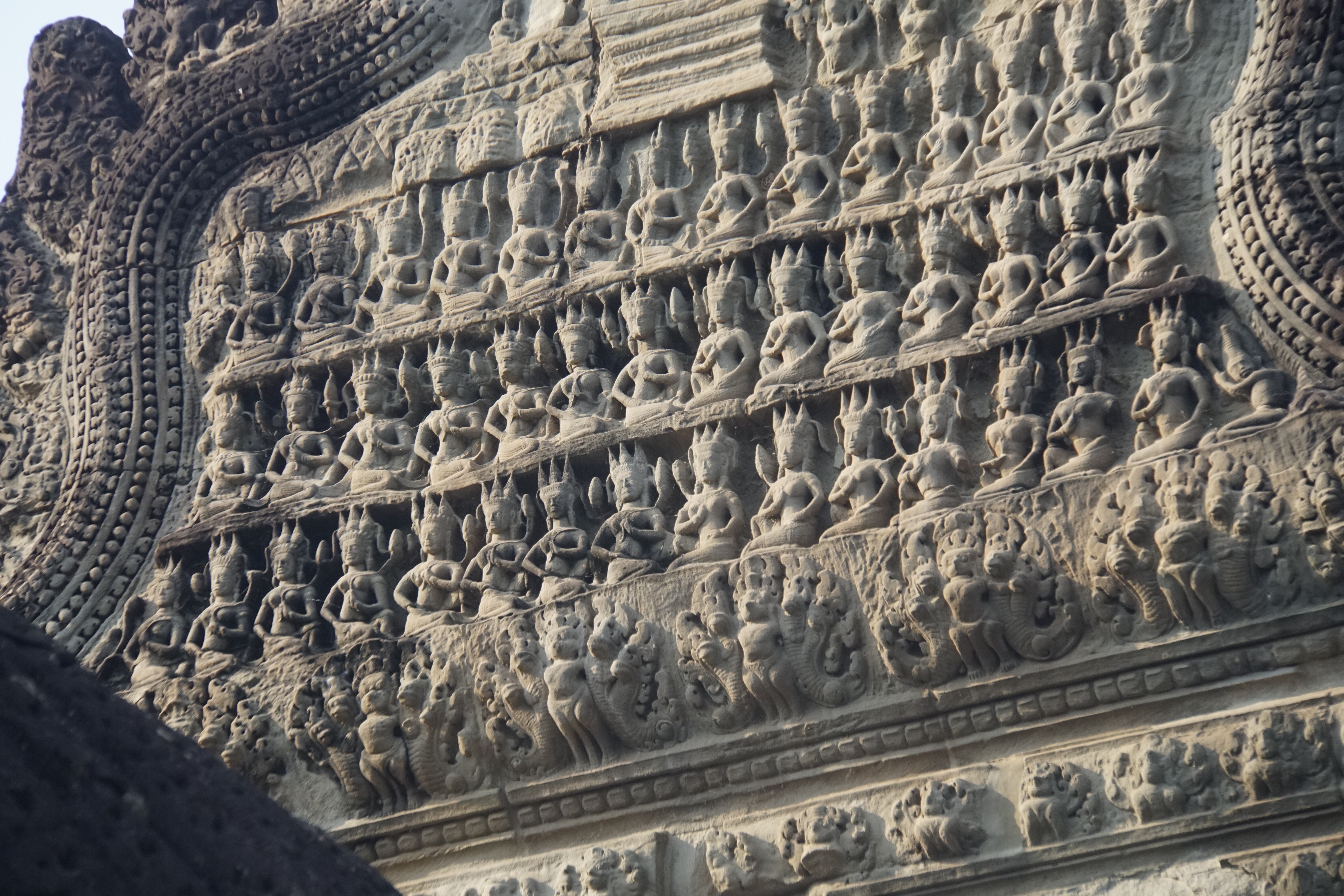 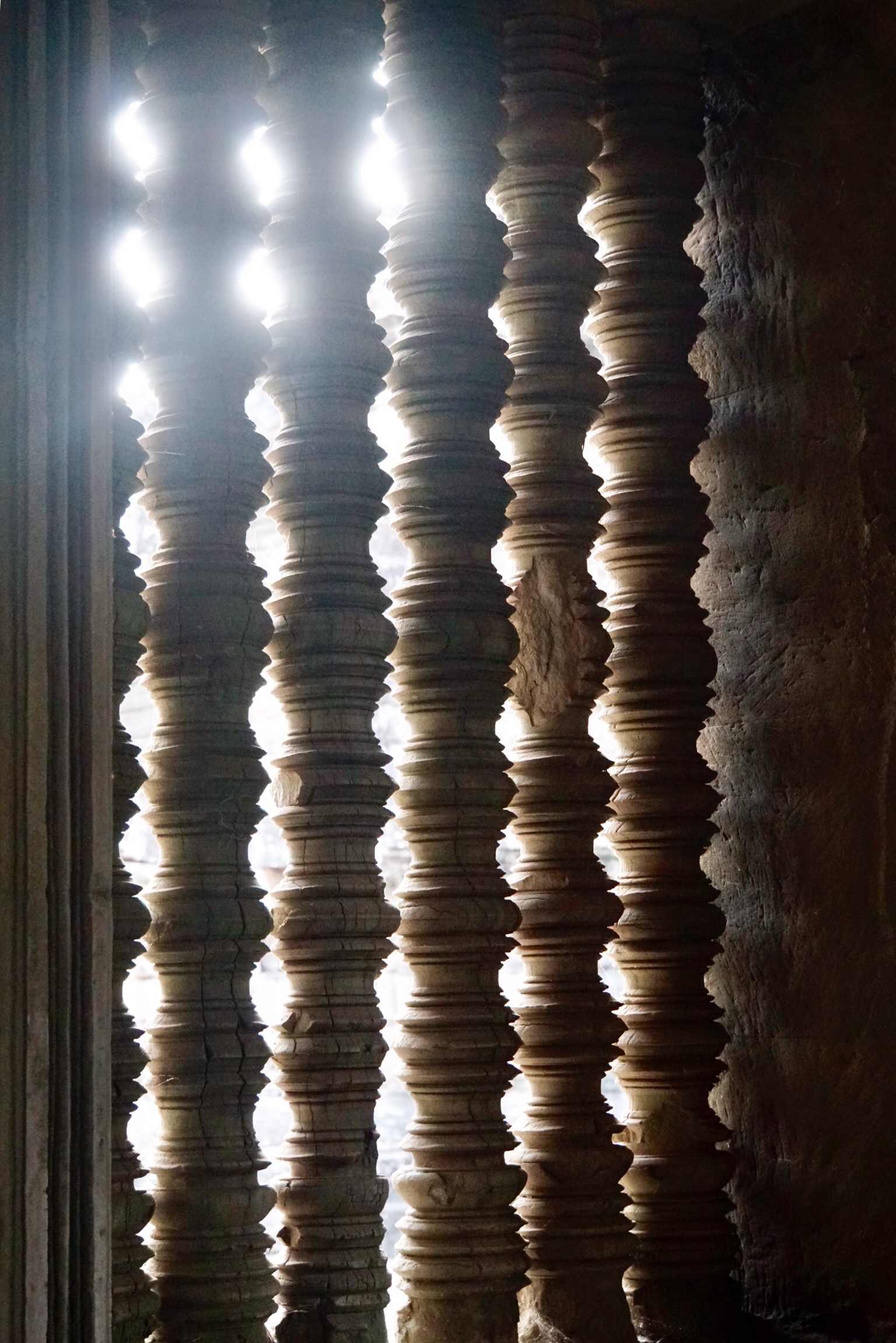 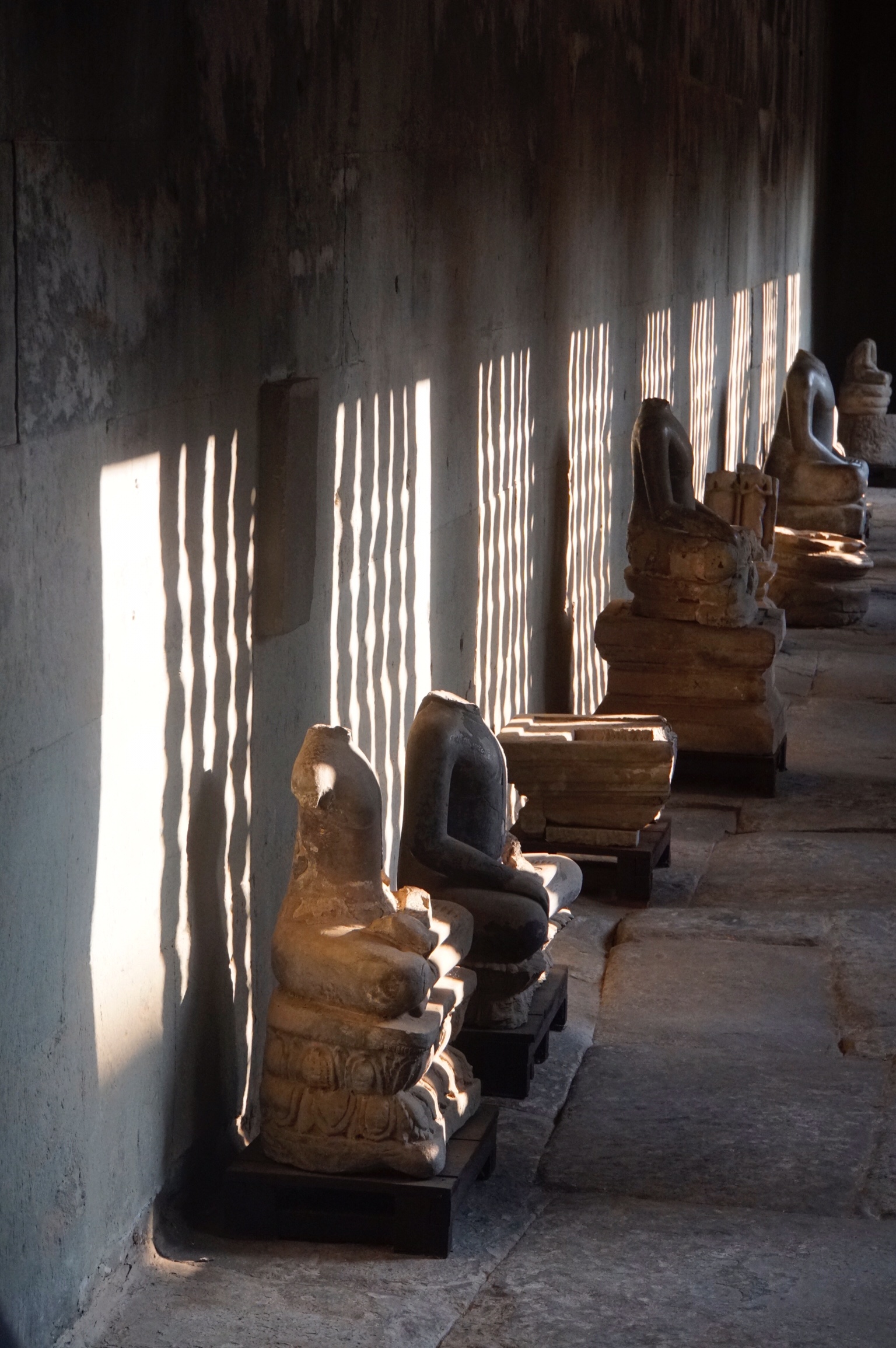 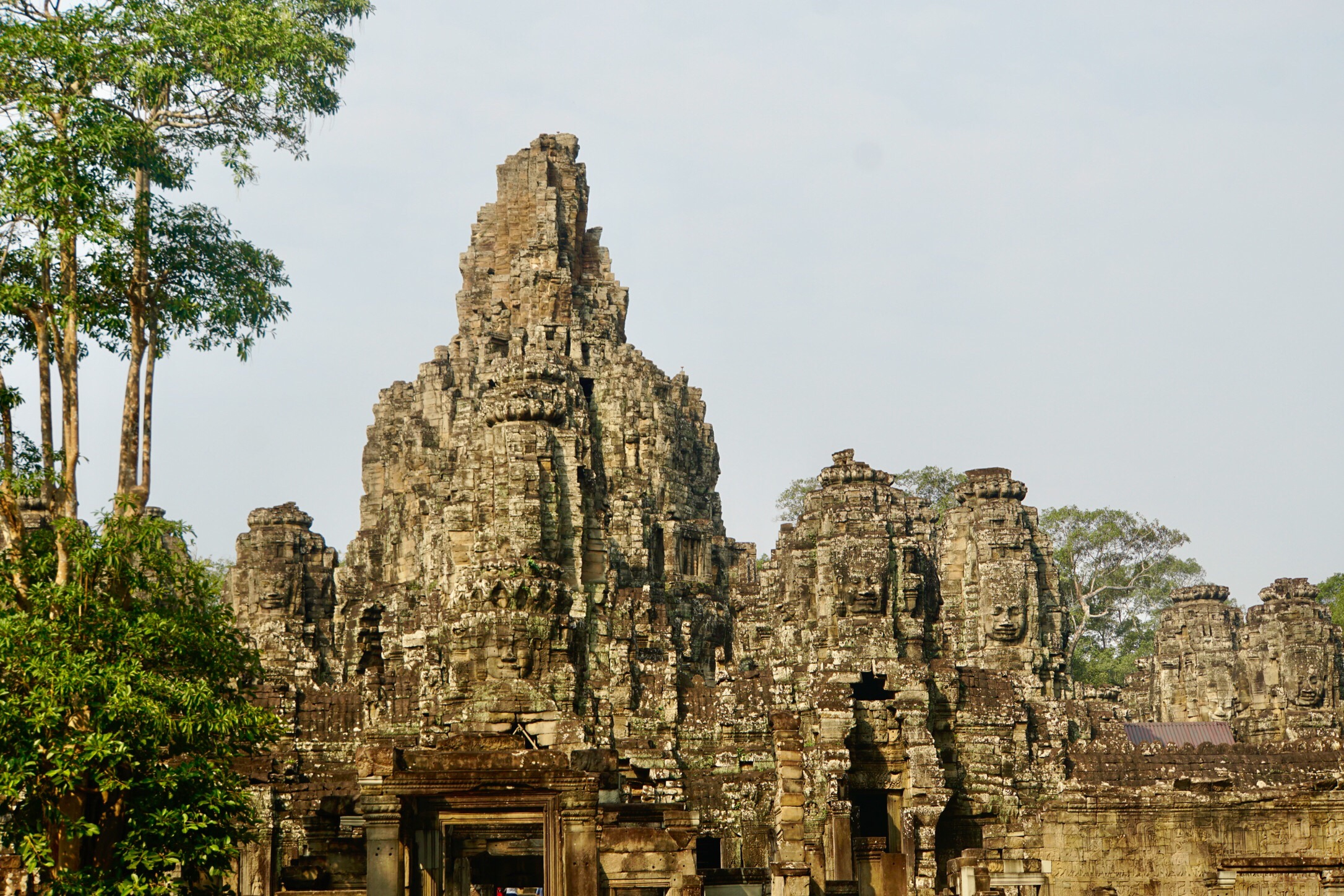 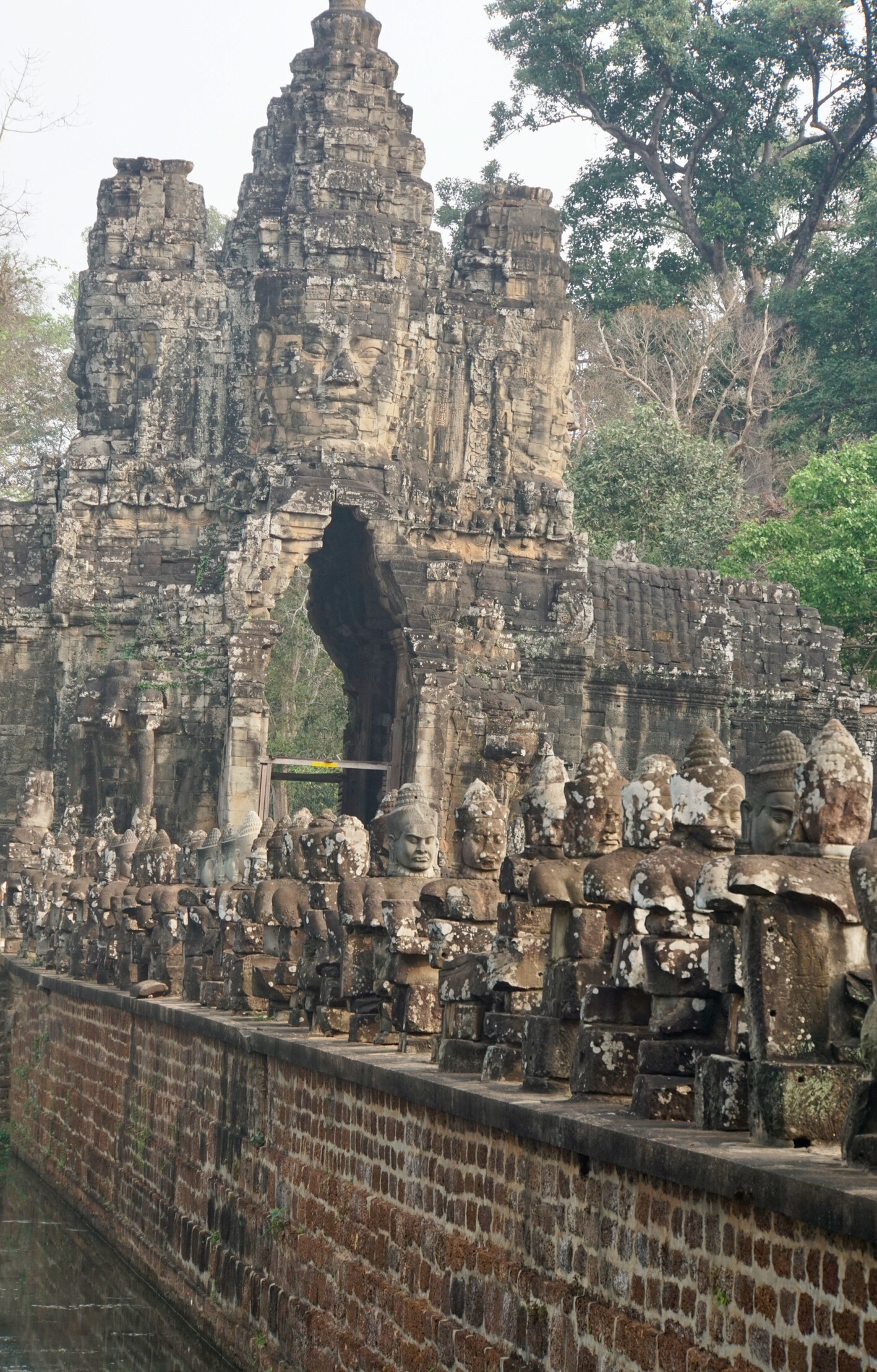 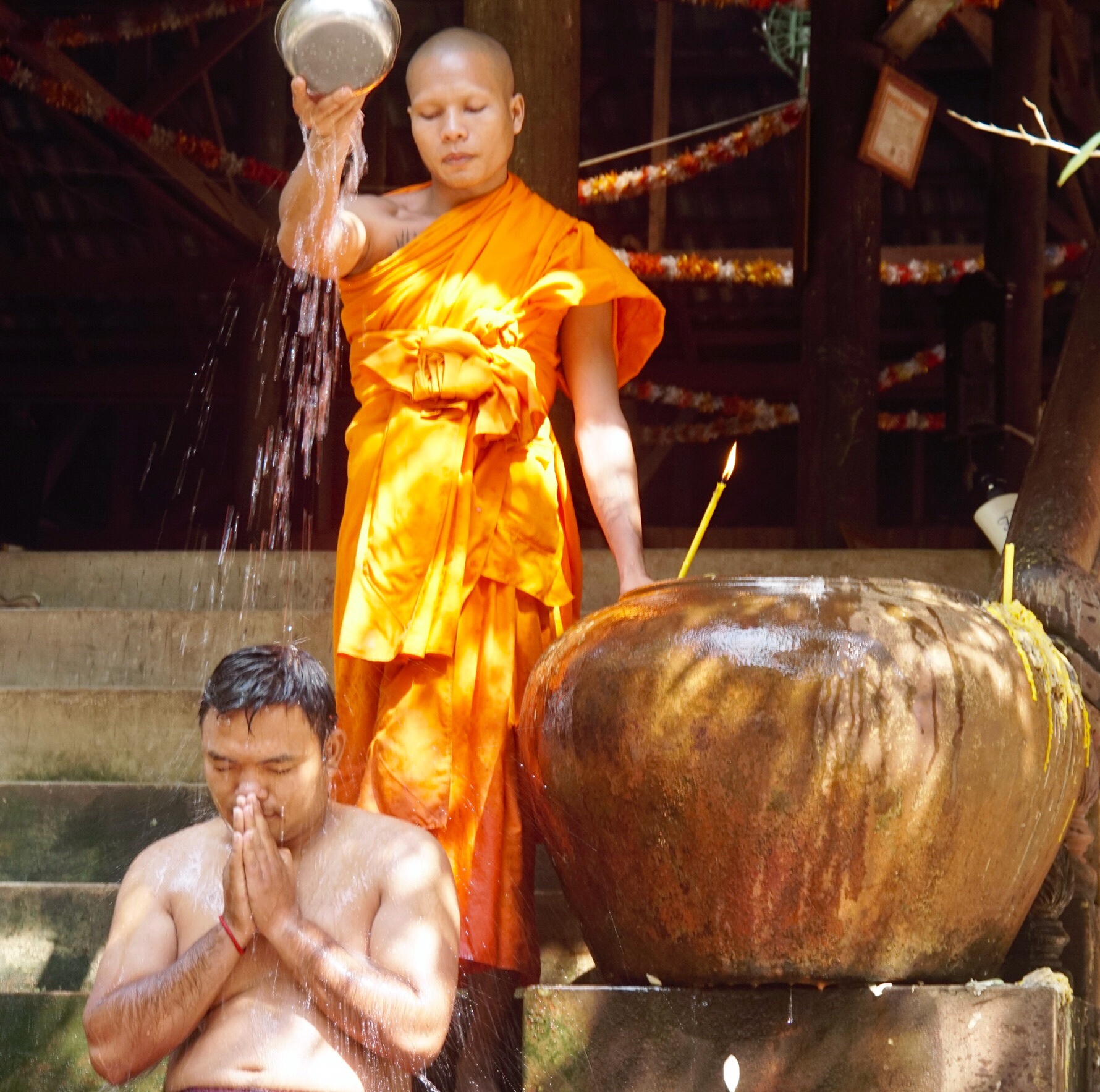 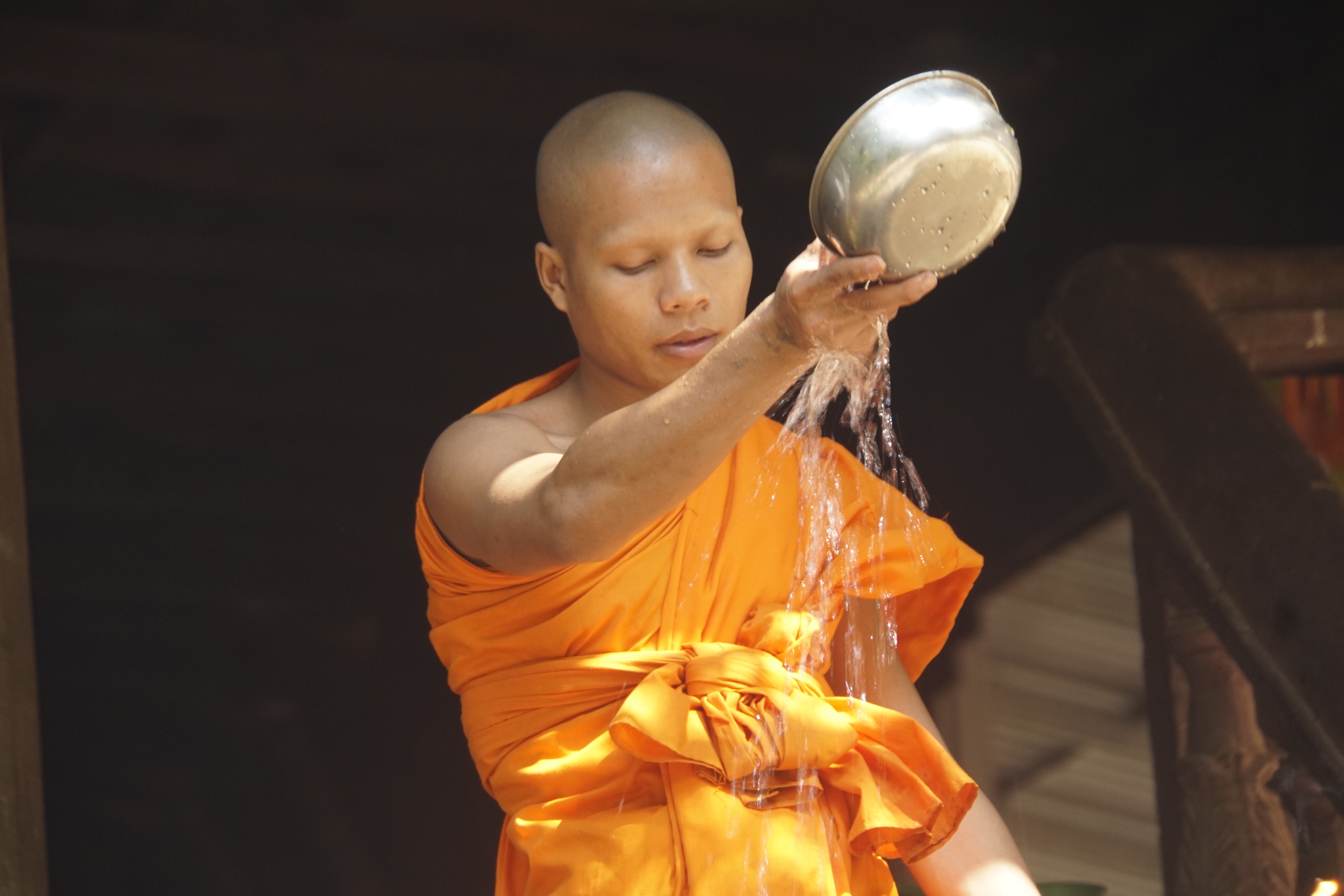 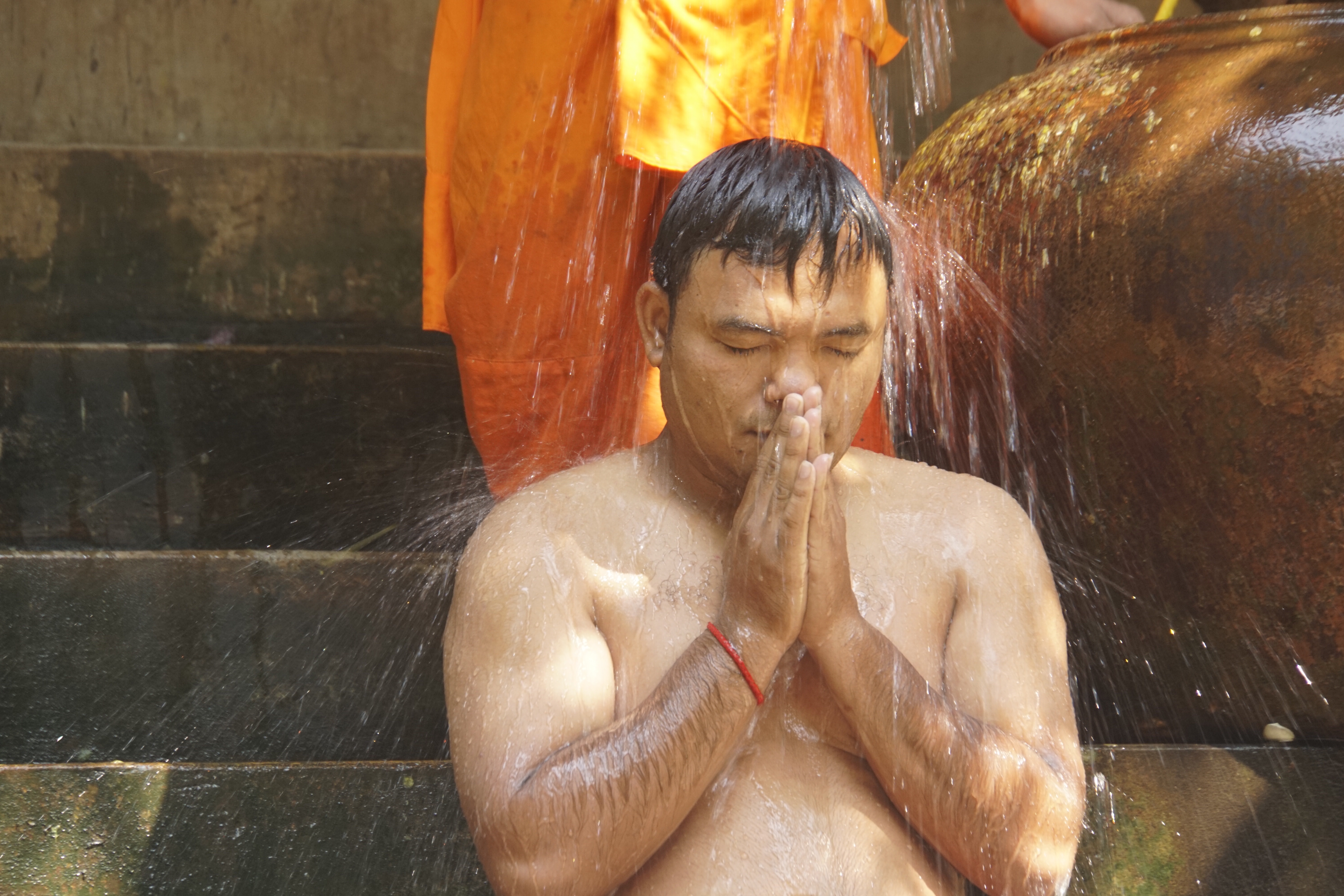 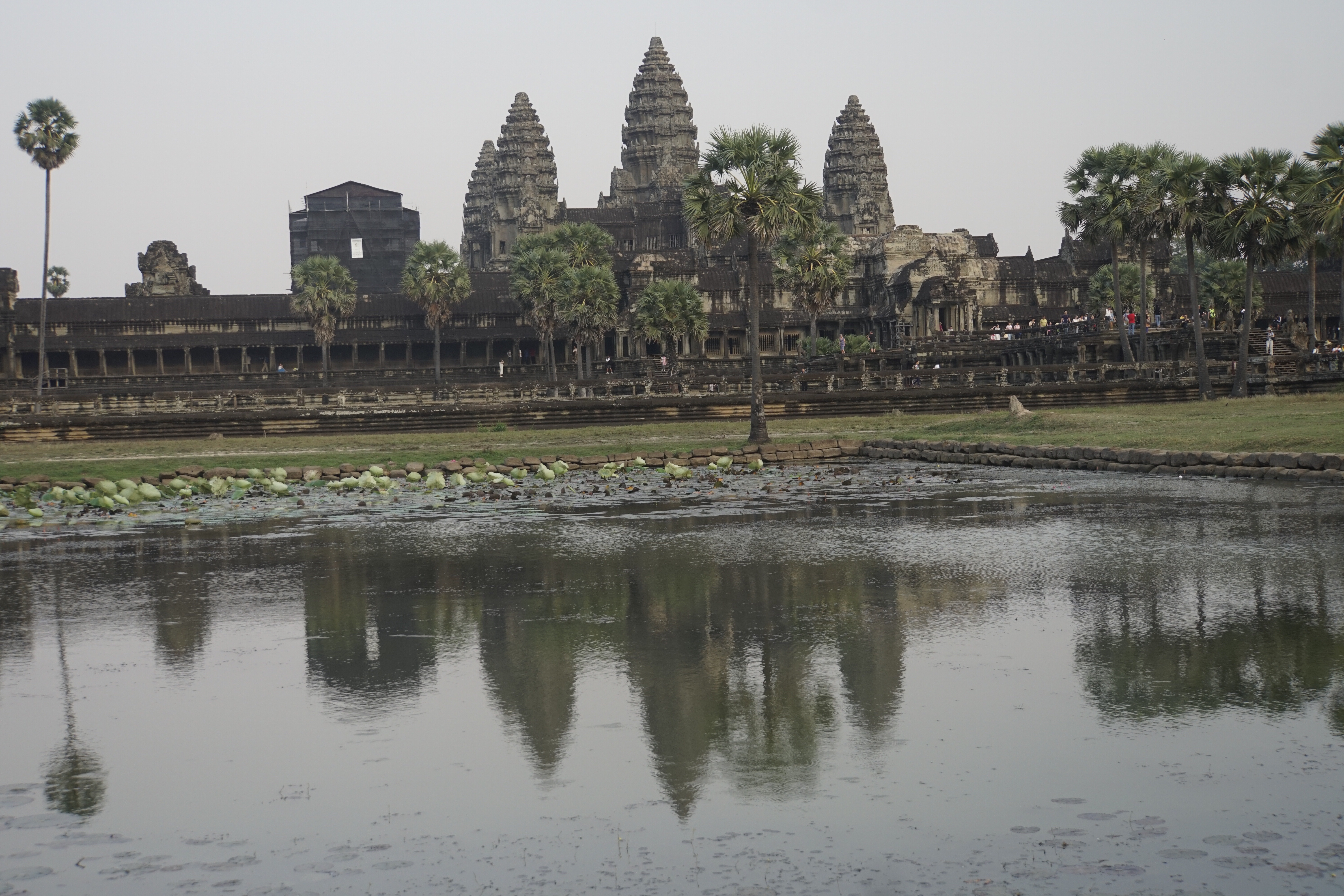 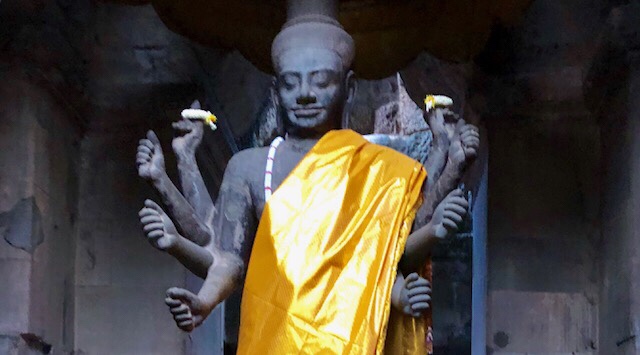 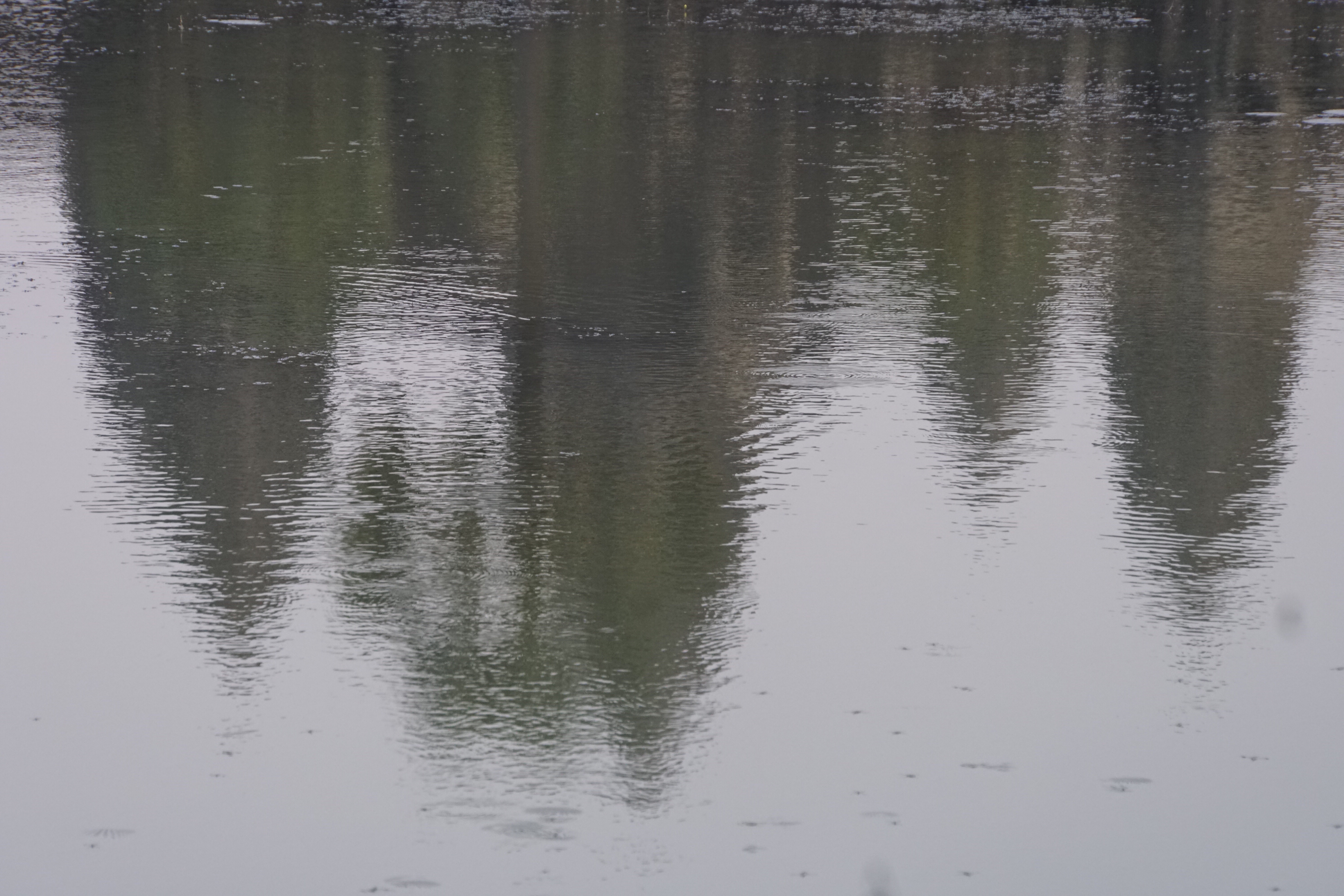
This evening we have a marvelous surprise, going to Karl’s gorgeous modern house, which he designed, meeting his lovely wife and children, eating a delicious meal the cook for us and then seeing a dance performance by young women and men who study at a local school.
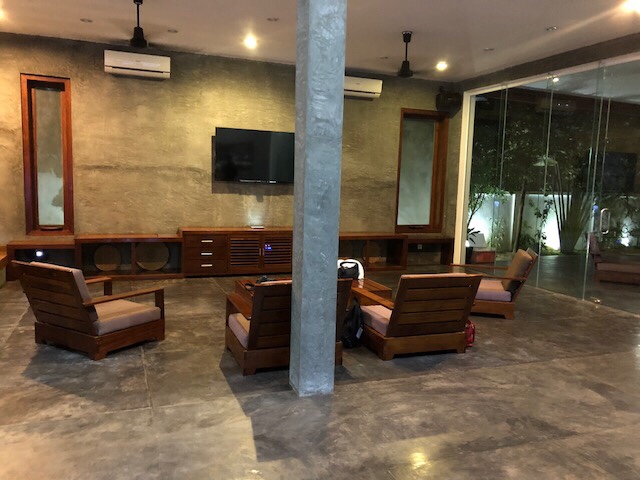  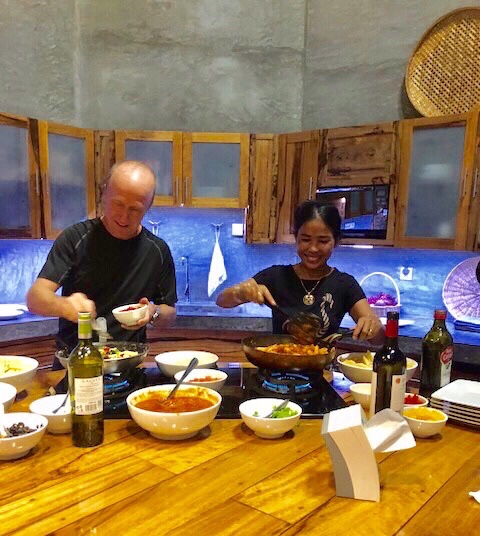 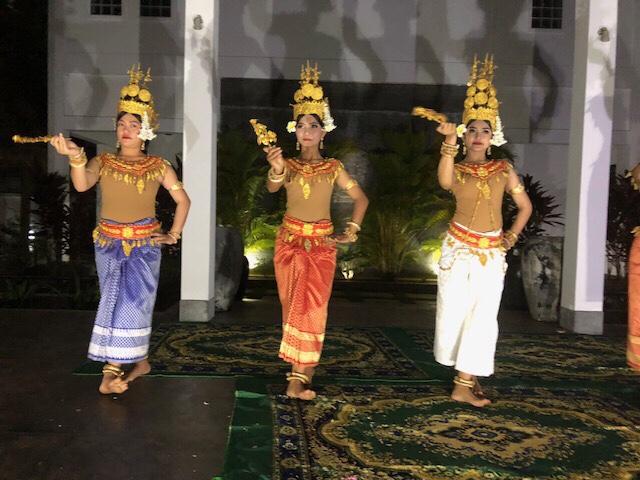 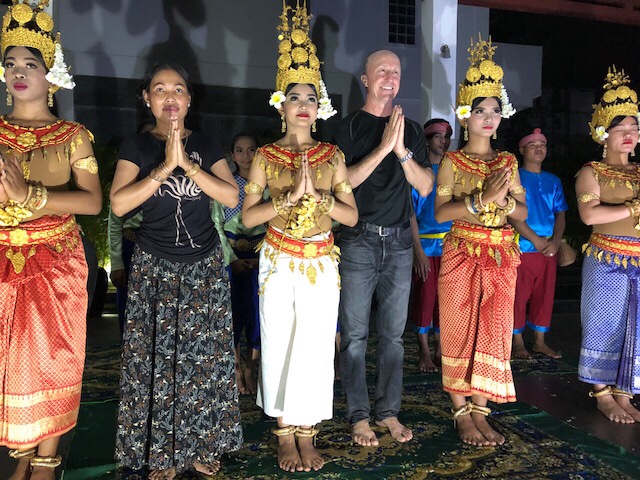 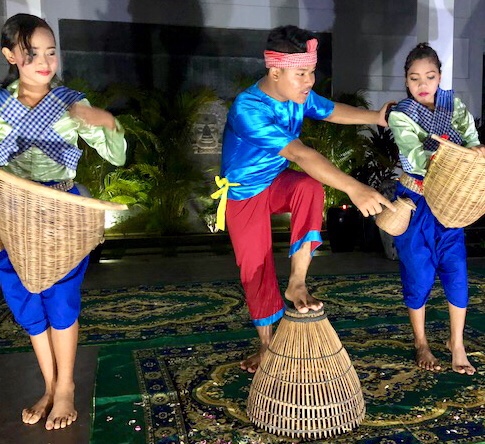
January 31. Phenom Penh is an appealing city. It seems very real, has some character. I’d gladly have spent another day or two here. After another fabulous eggs Benedict breakfast, Carol and I go down by the river to photograph ladies with flowers, kids, people praying, small birds being sold. Quite a scene. 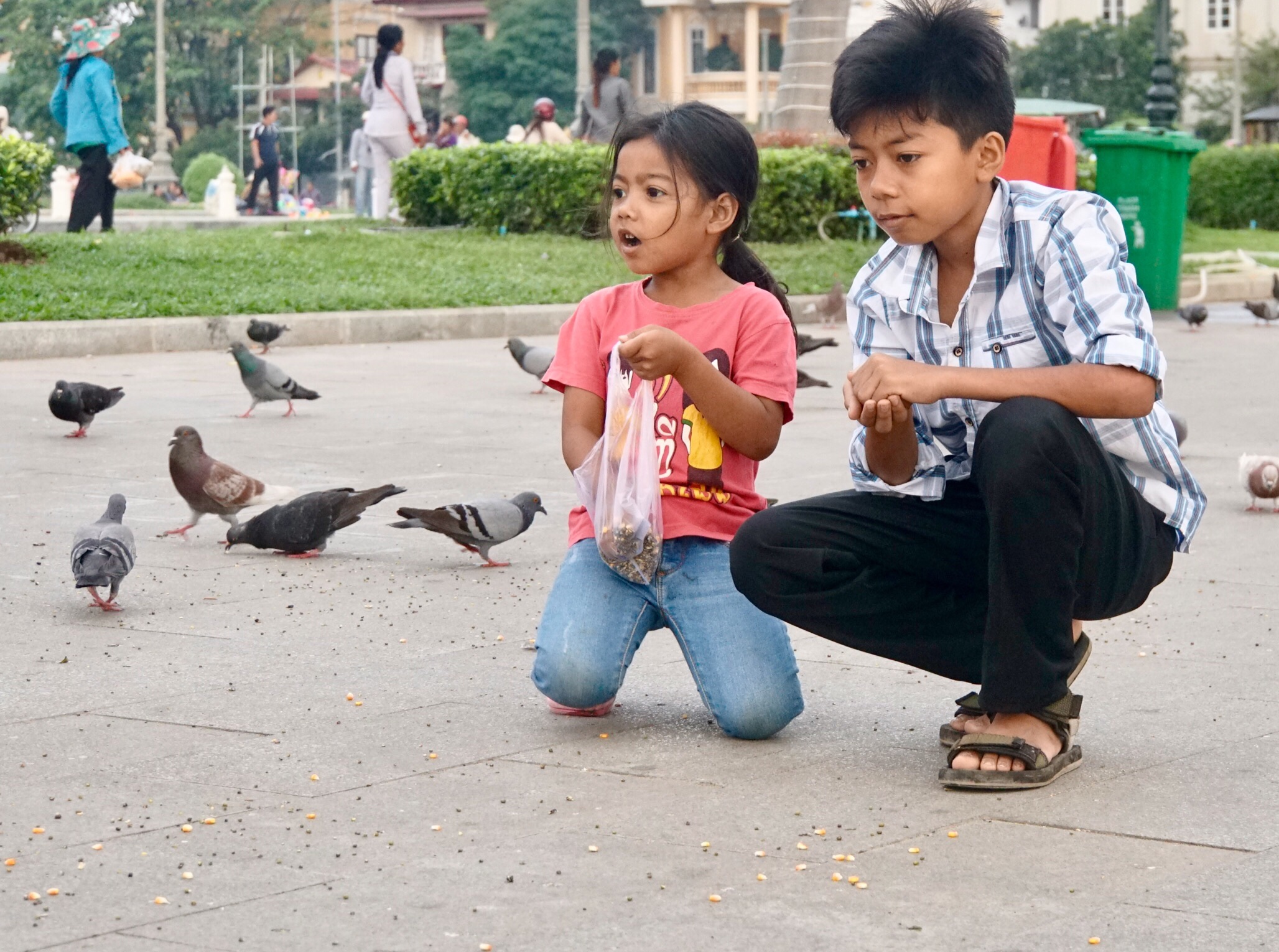 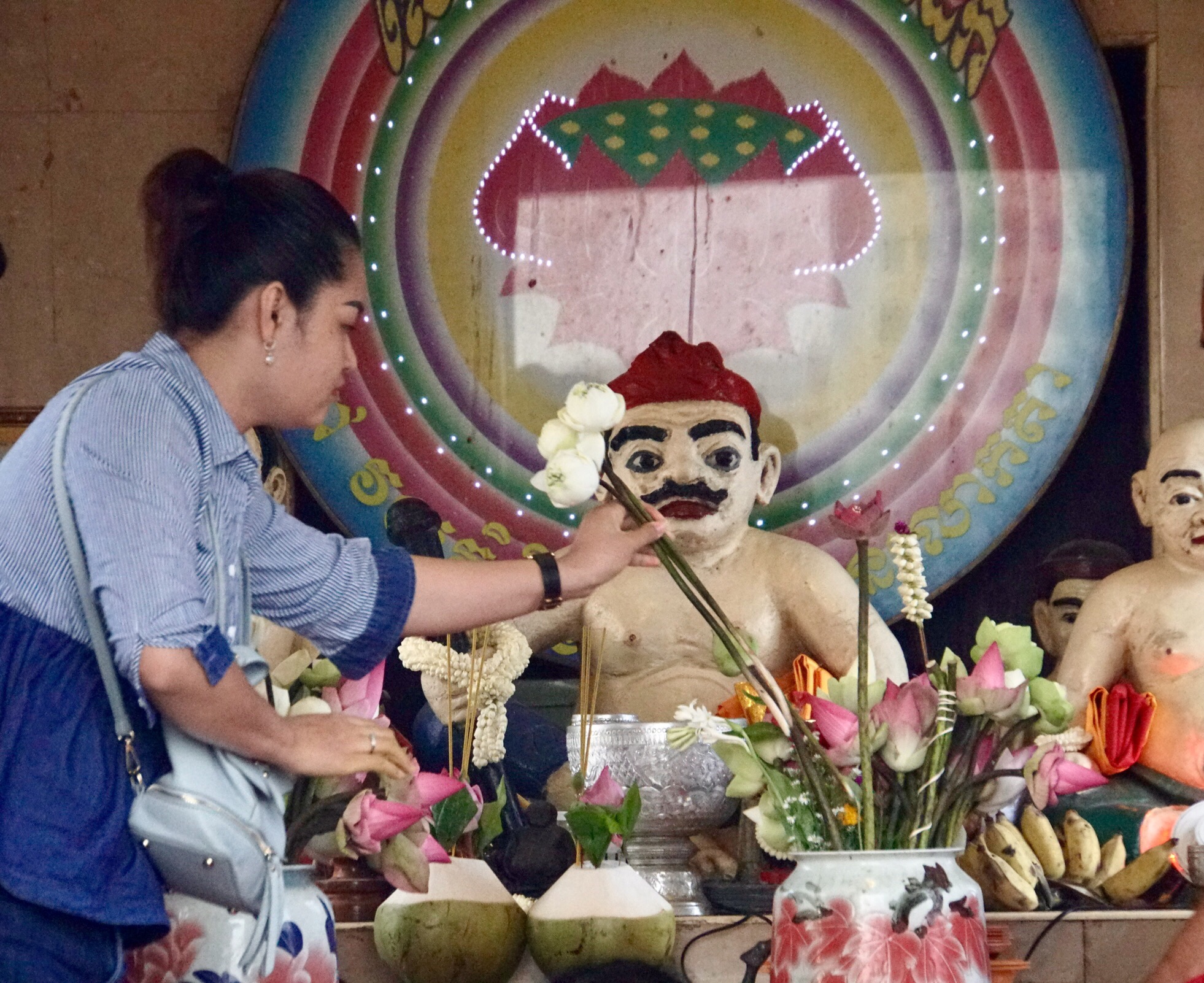 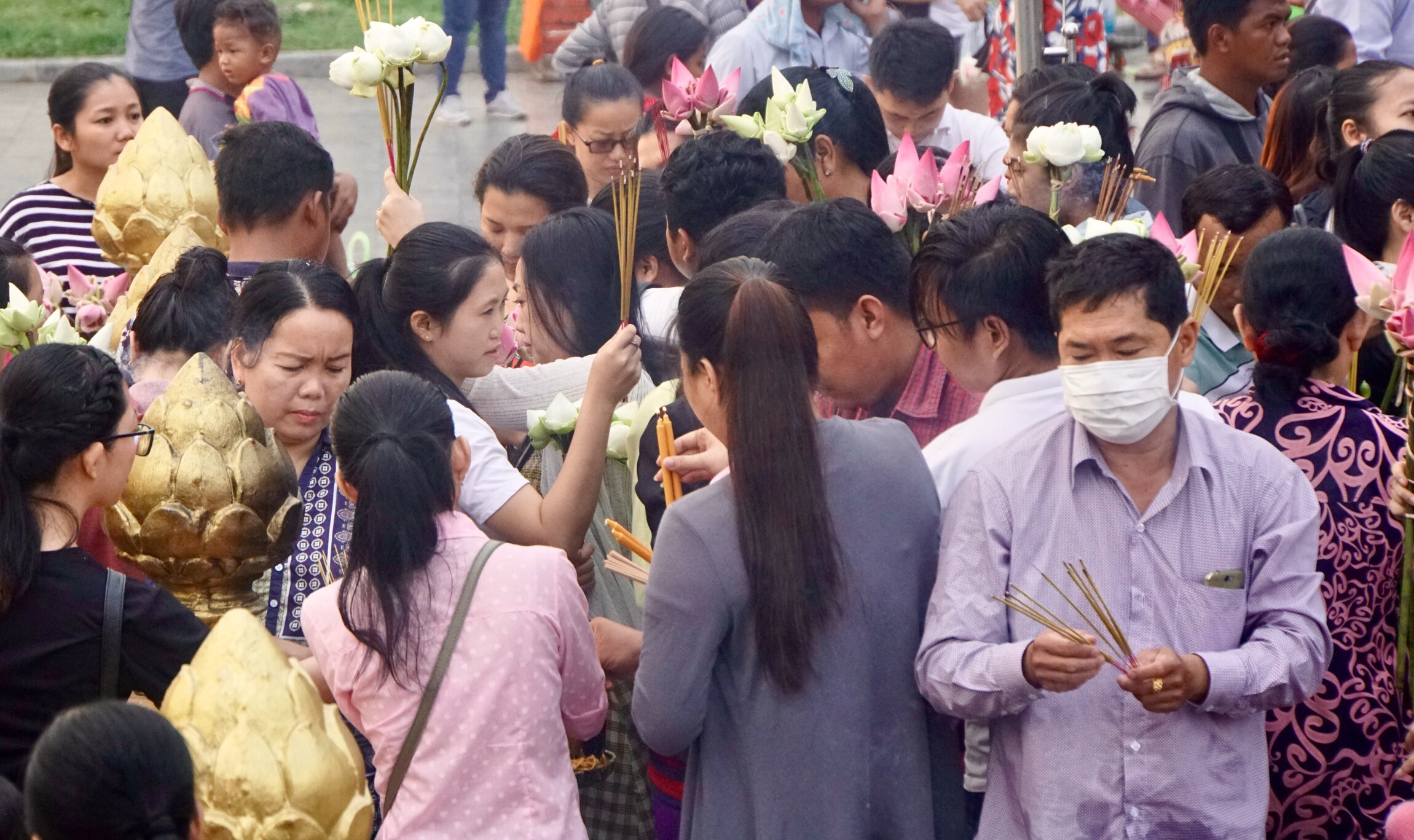   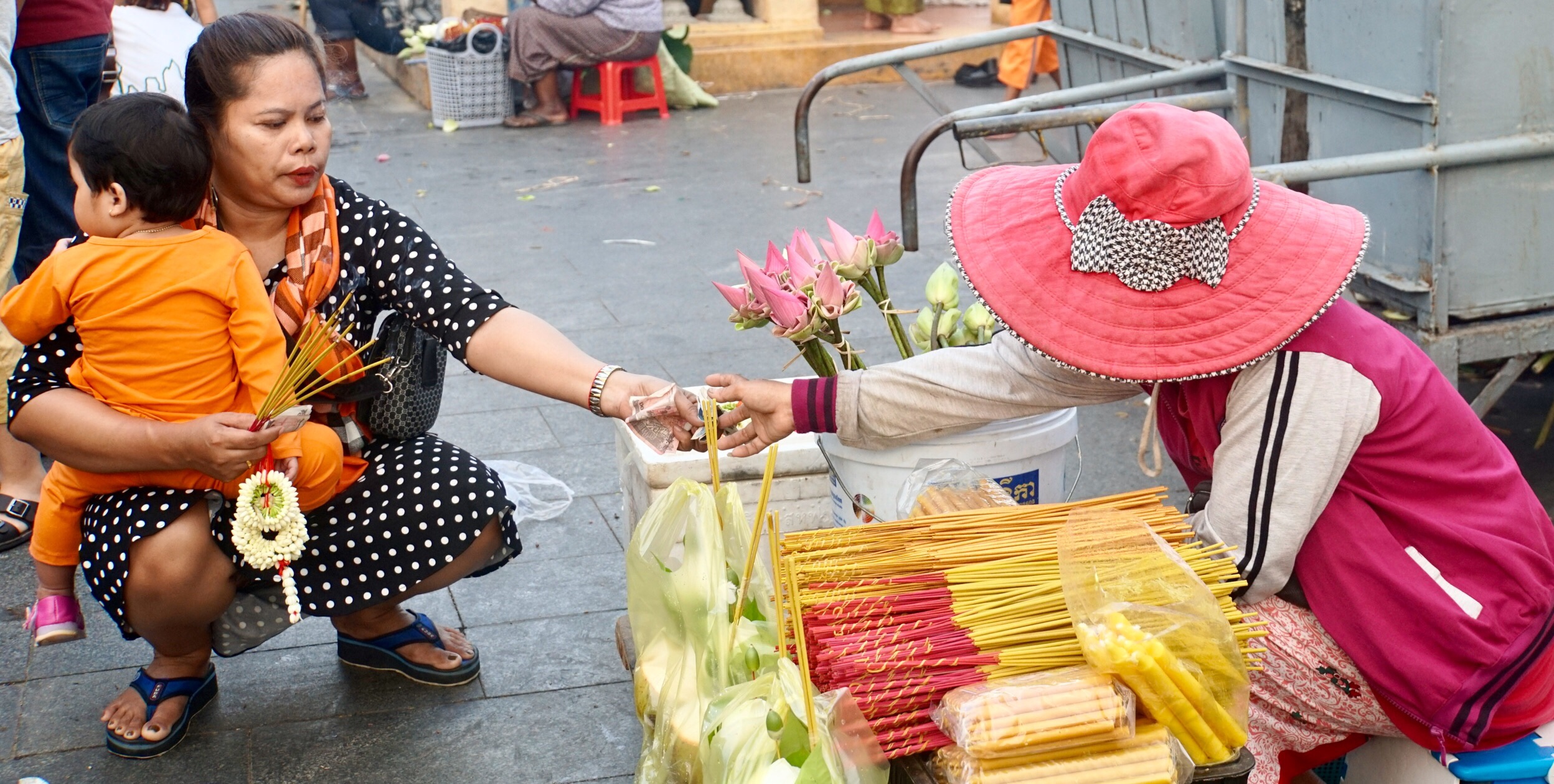 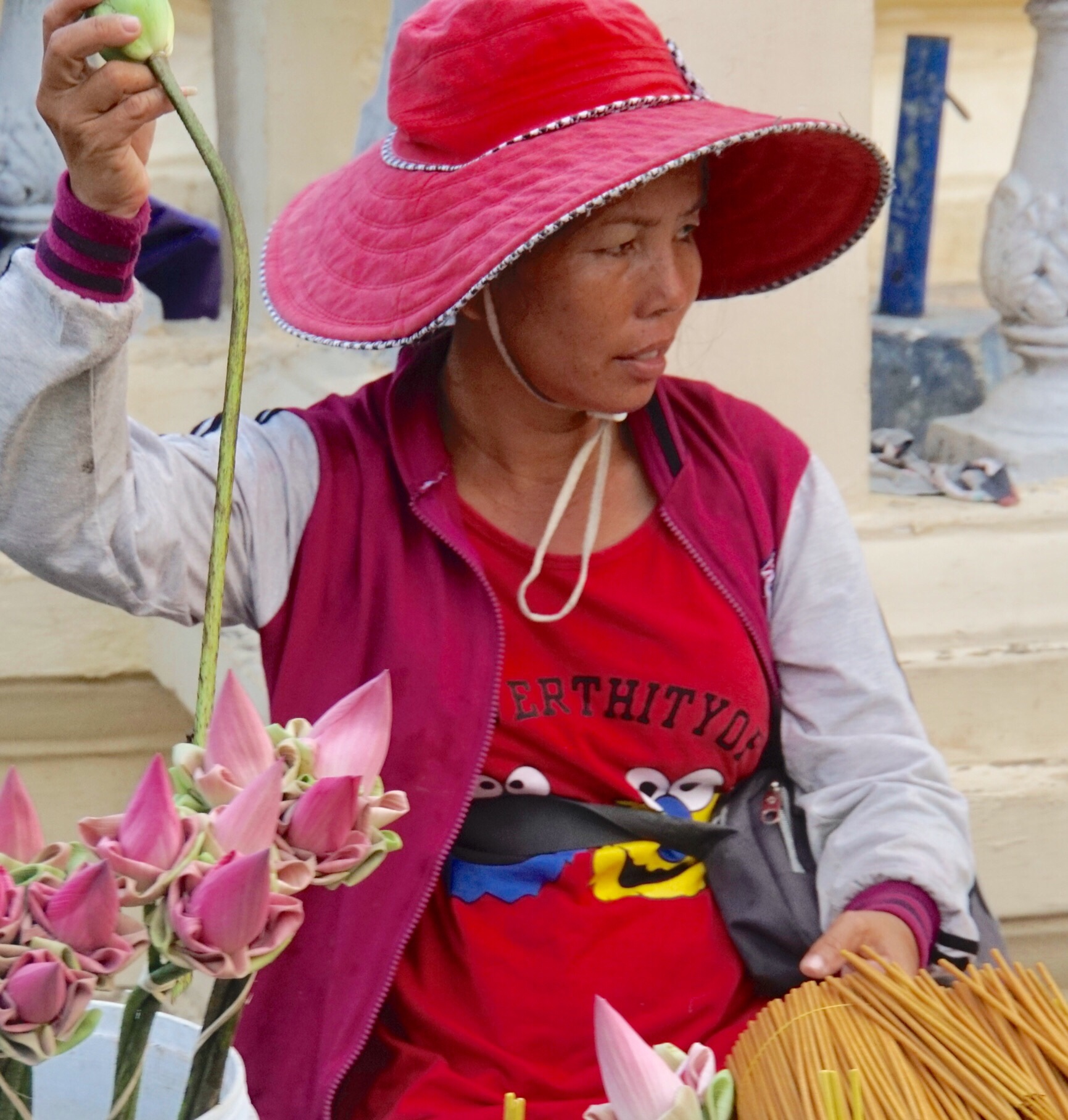
We then board our bus for transport to Siem Reap. Along the way we witness local Cambodian life, rice fields and stop at Skun, a place where tarantulas and other disgusting things are sold and, more importantly, where they have fine urinals.  
We stop for lunch and again to photograph bicycles crossing an old Khmer dirt bridge. 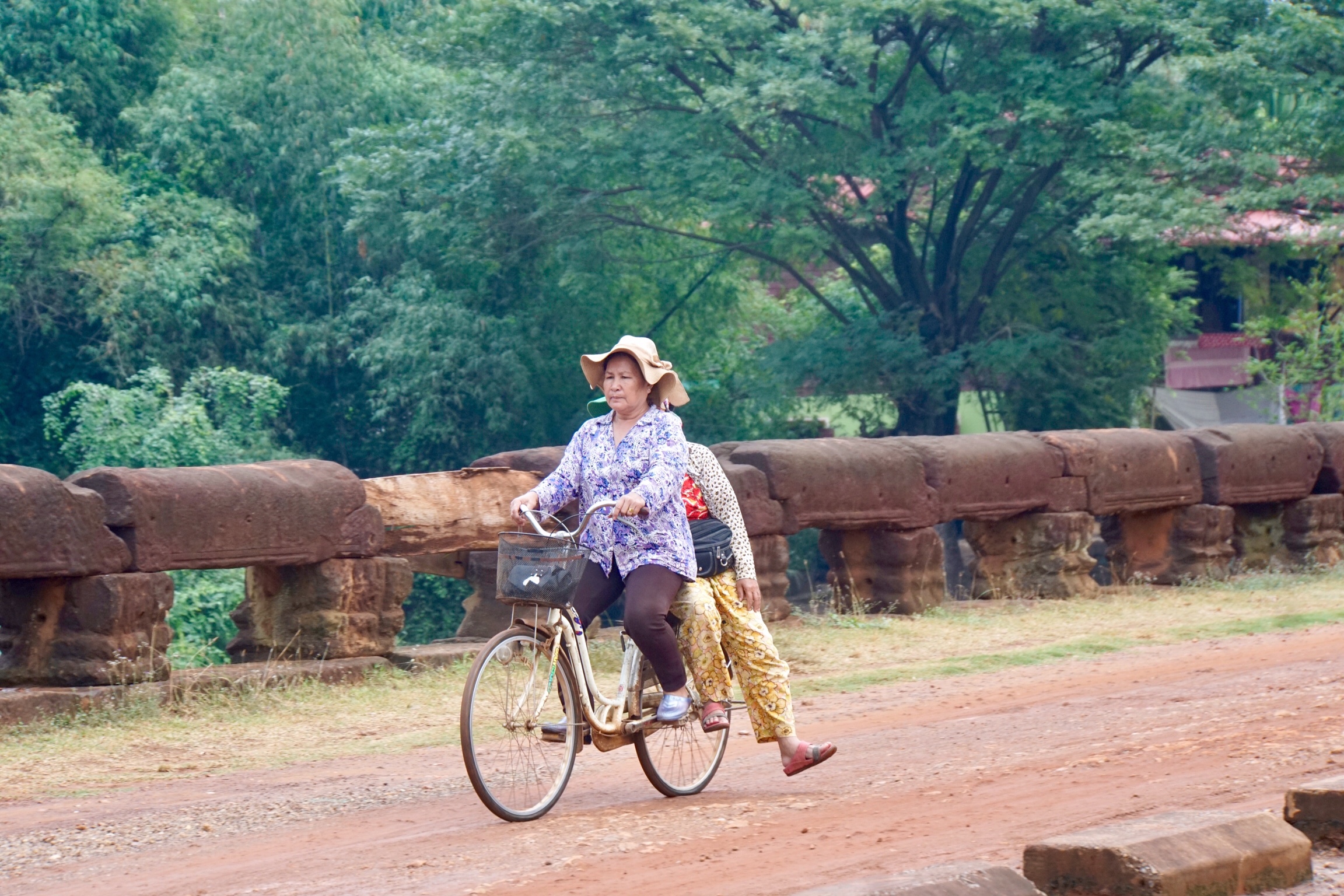 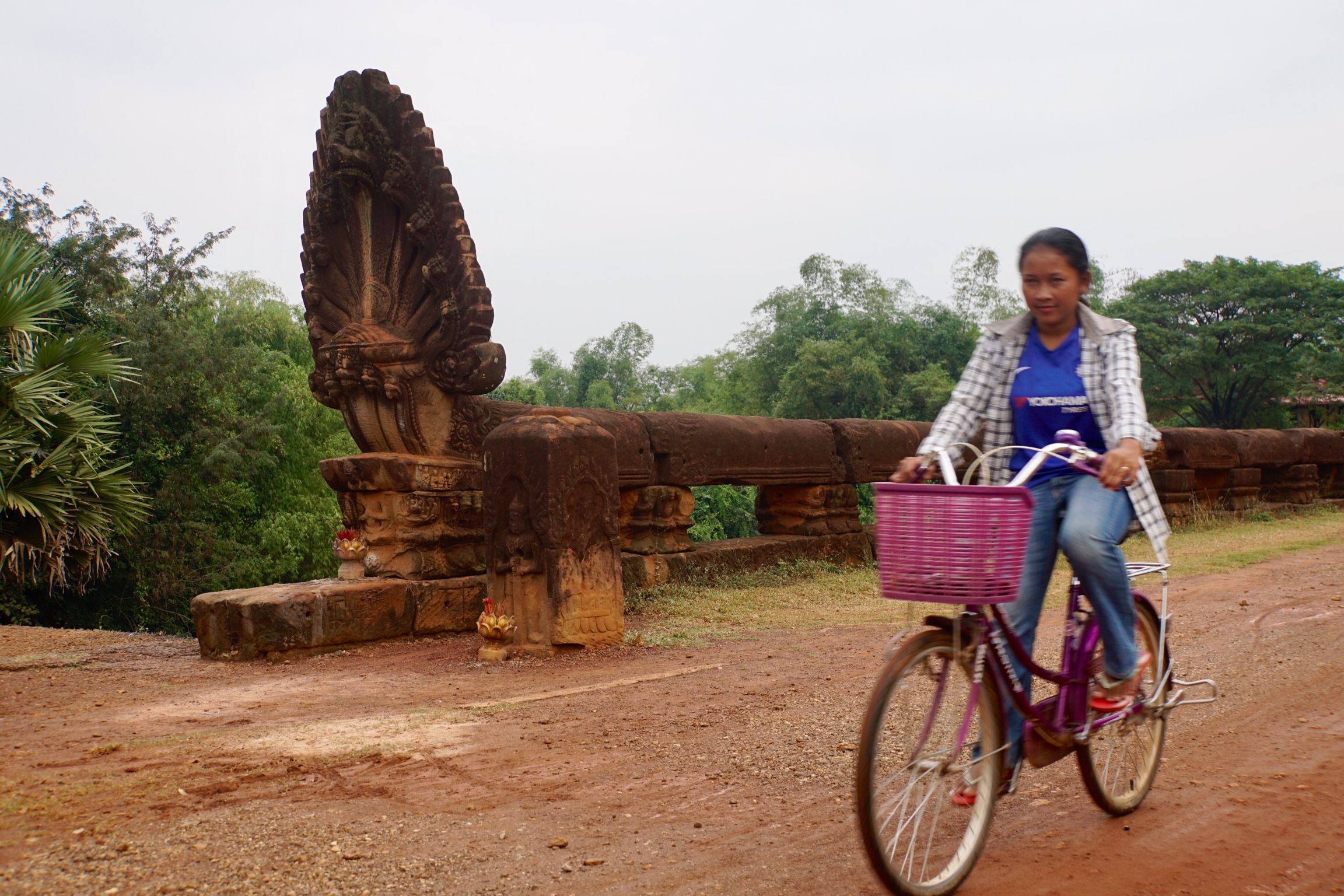 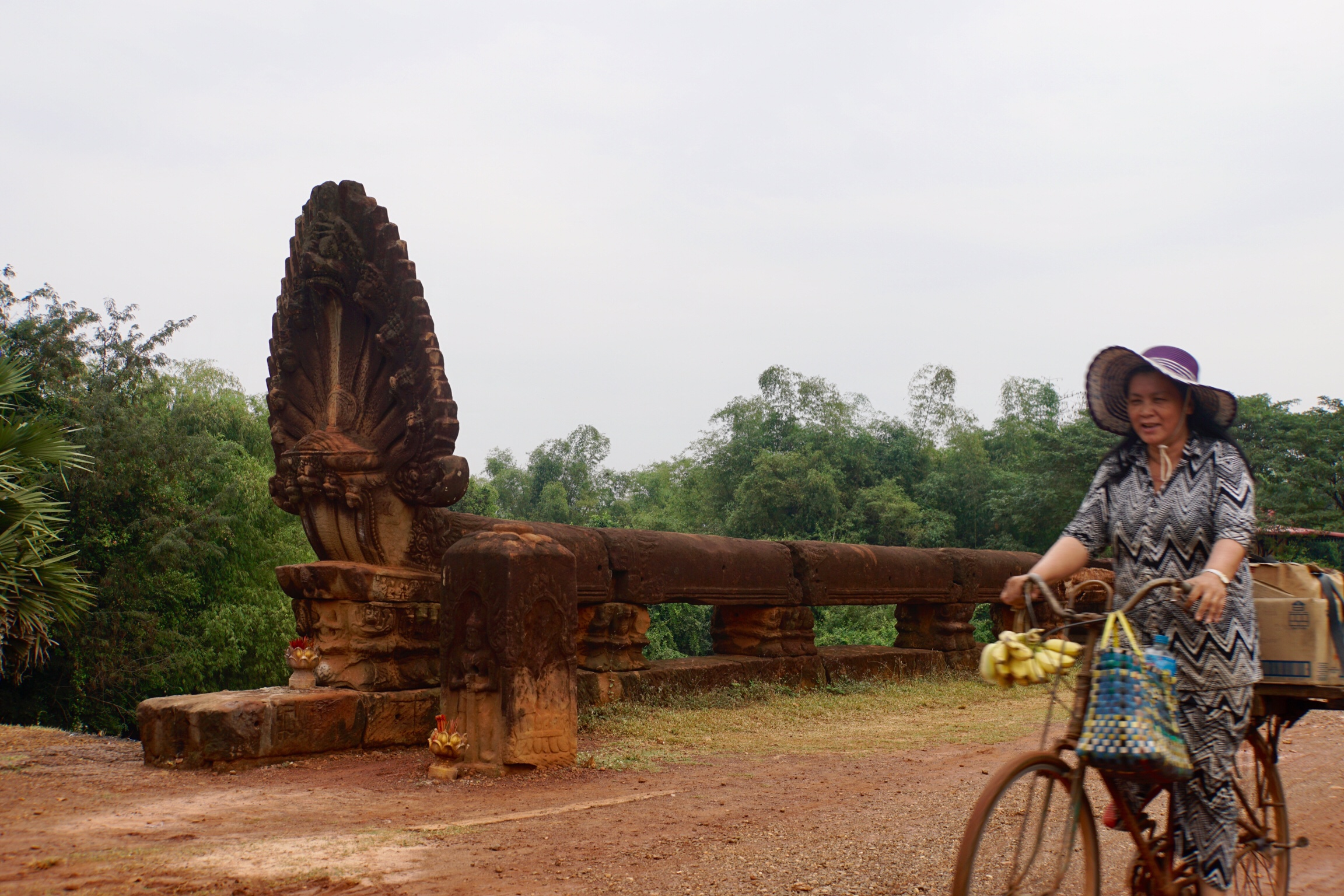
Once we reach Siem Reap, we visit the famous Angkor Wat for orientation and a sunset photo shoot. We are able to see the Victory Gate, walk through the forest along the wall to the Death Gate, all alone, and then drive to a spot where worshiping is being done, associated with a holiday for the new moon. This is all spectacular, clearly the highlight of our trip. So we now have a first taste of why Angkor Wat is on everyone’s bucket list.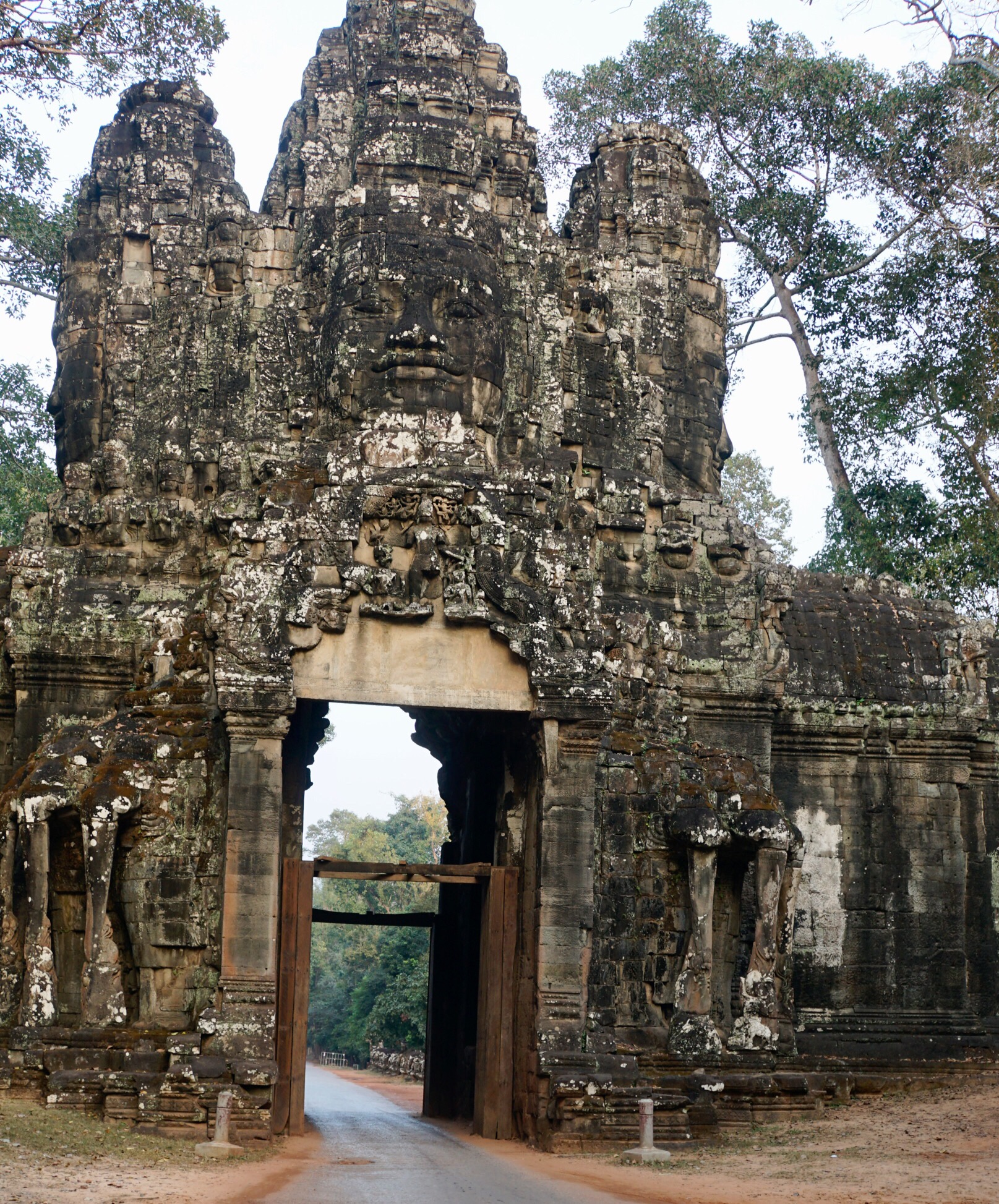 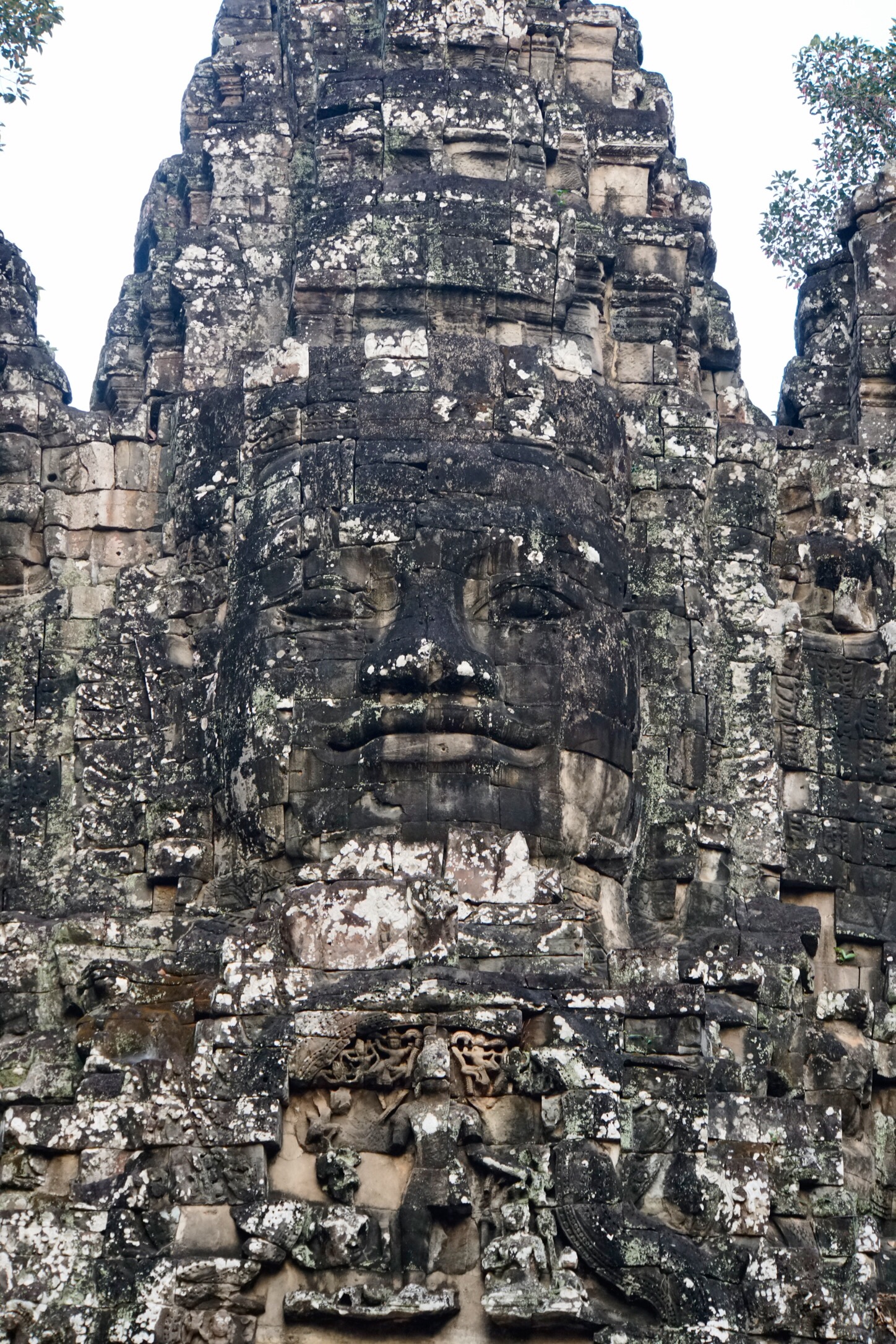 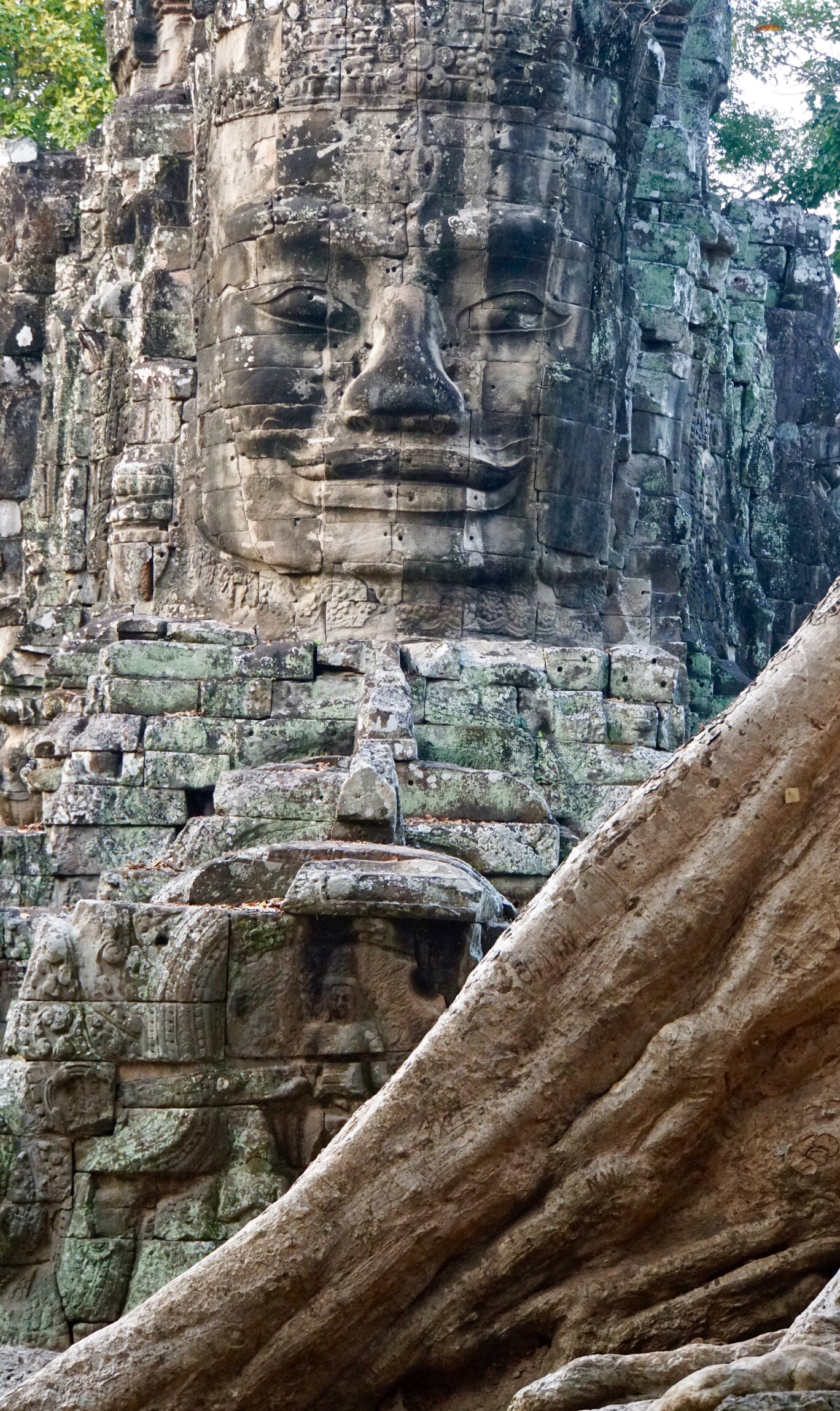 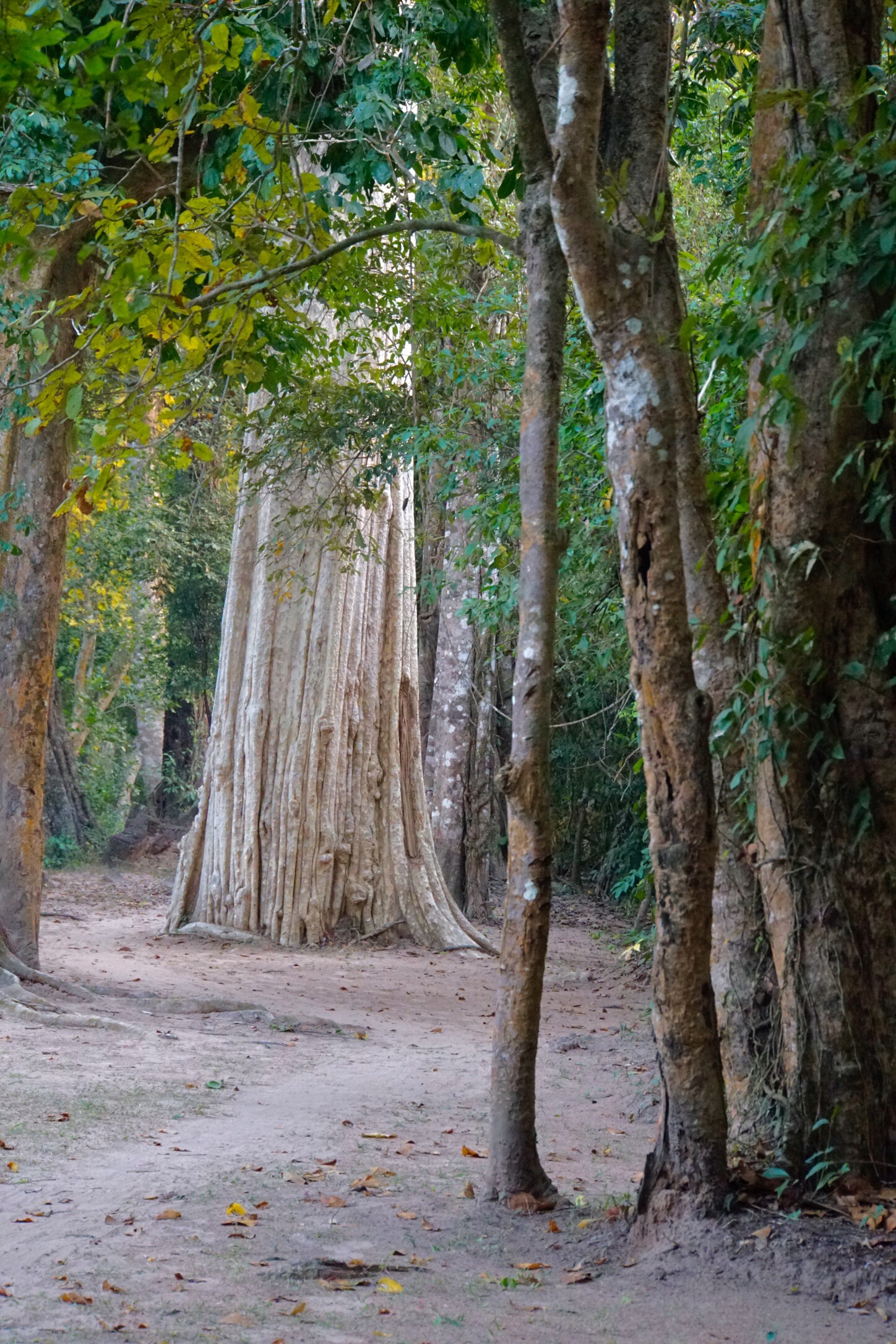 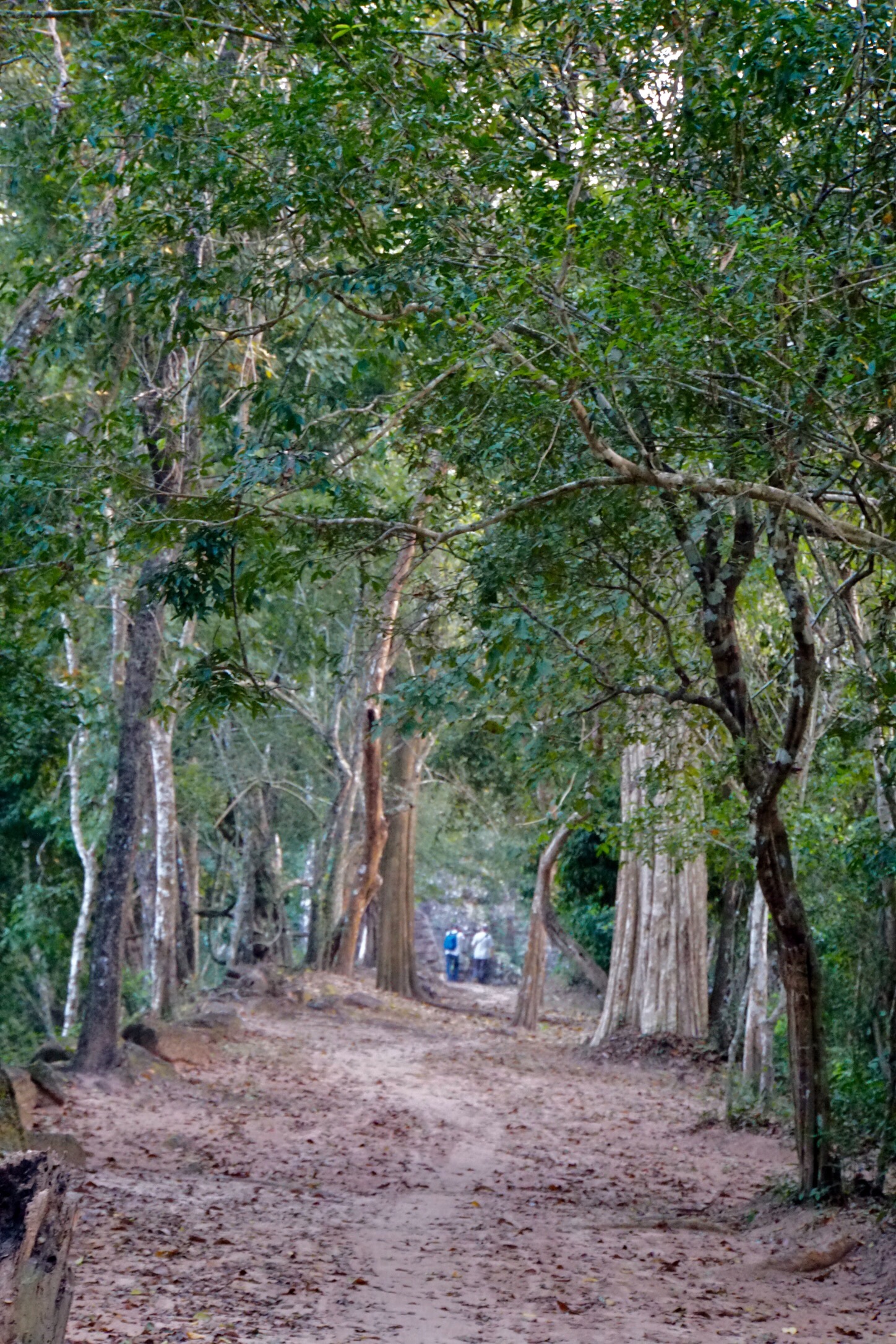 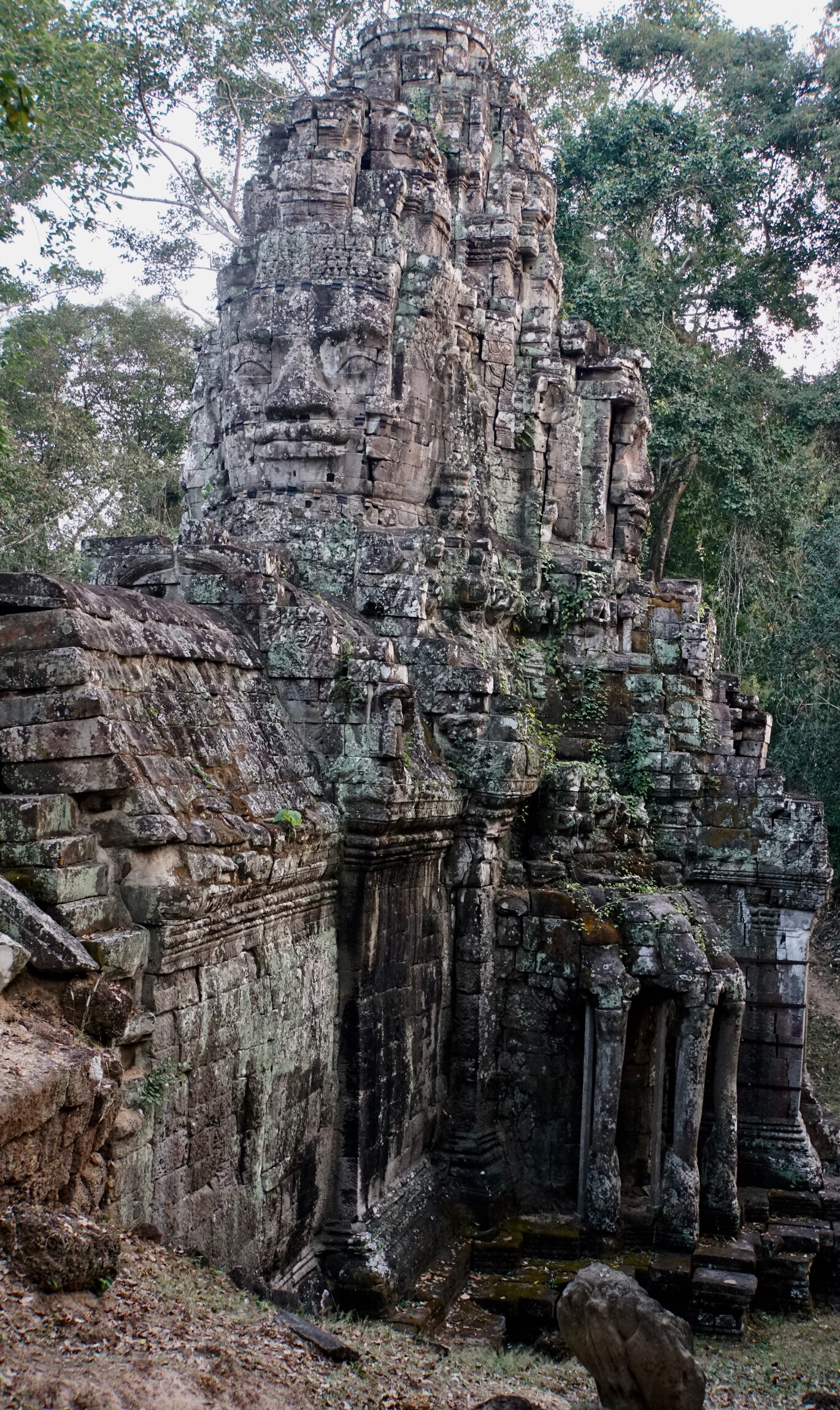 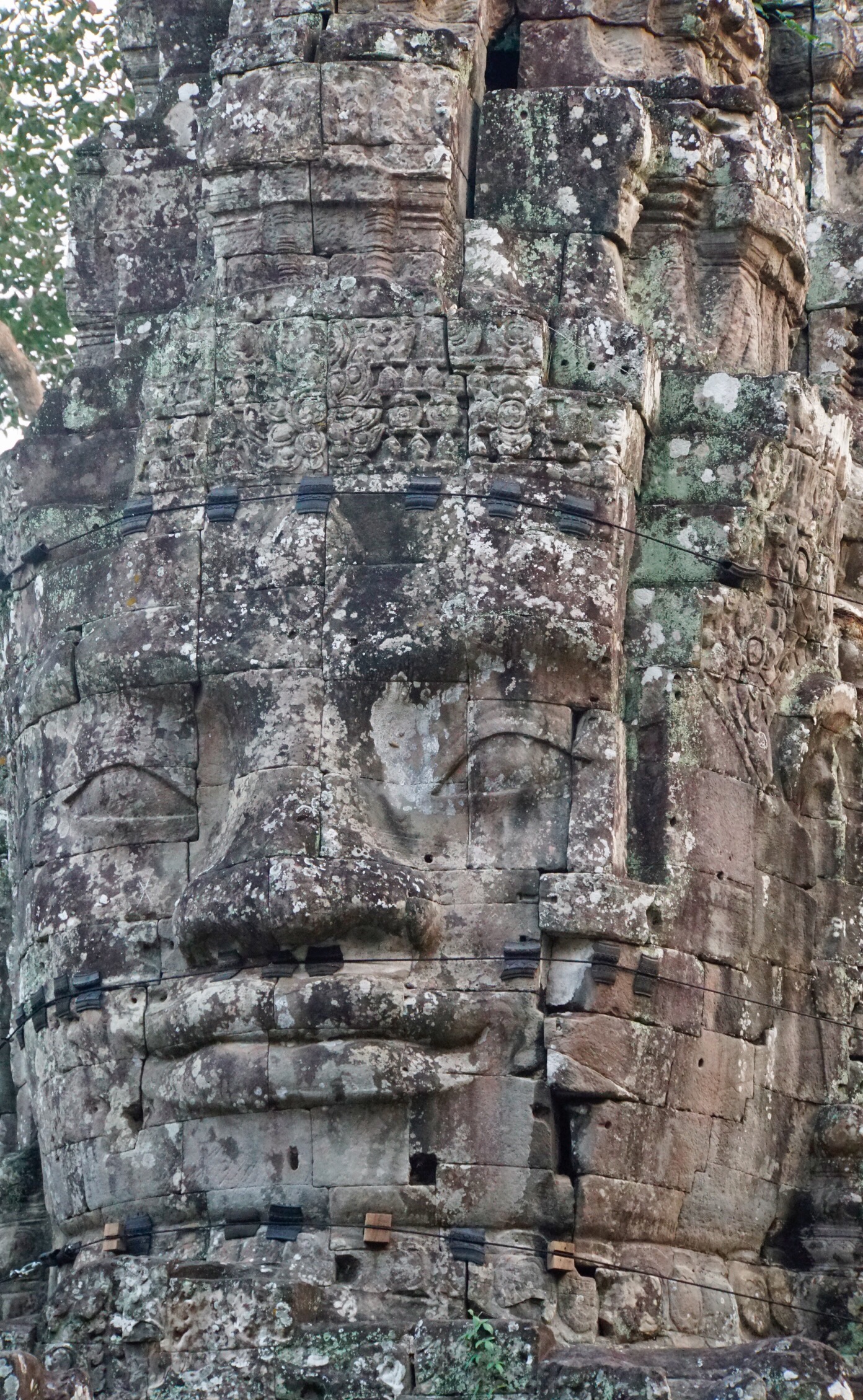 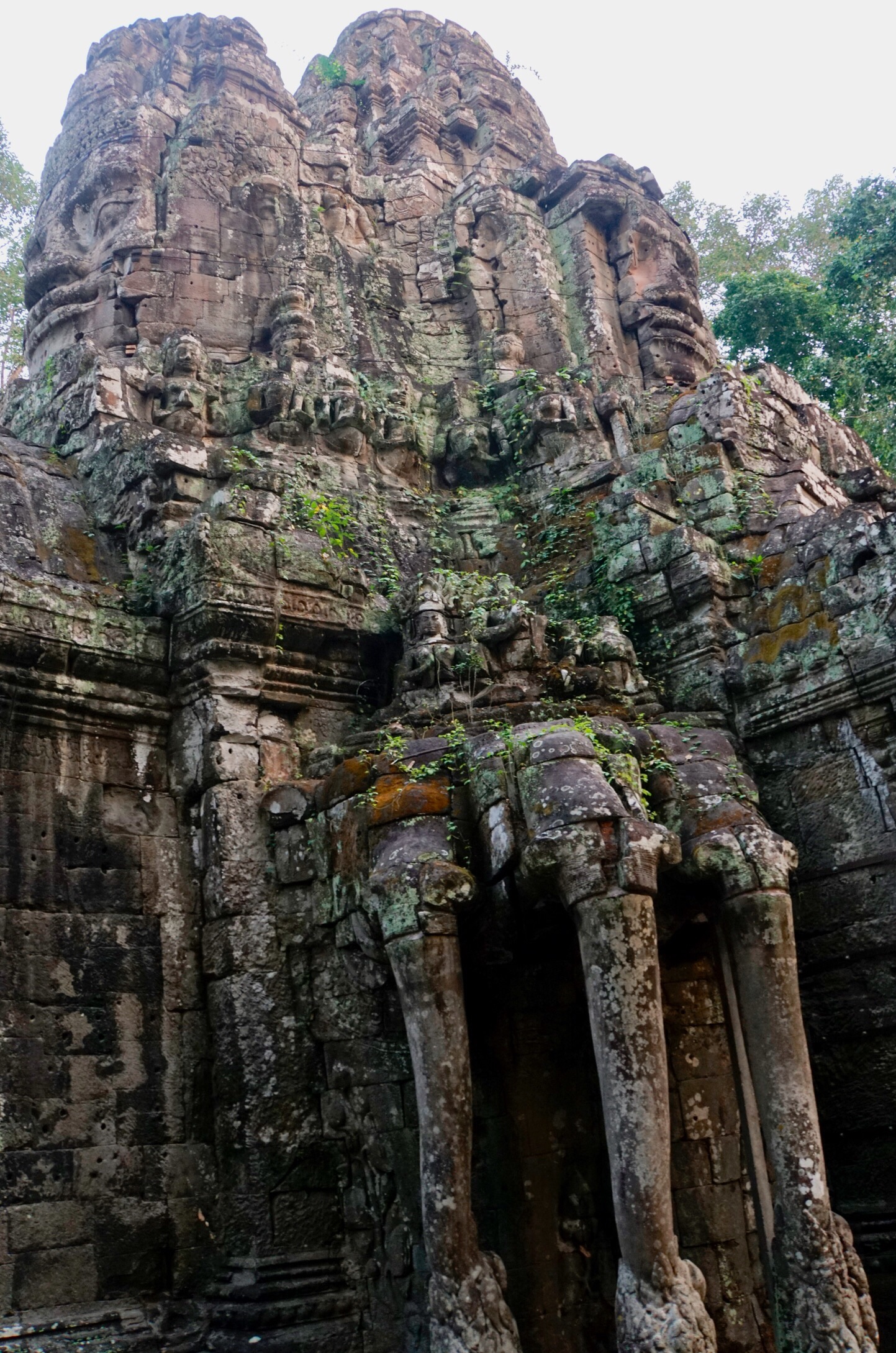 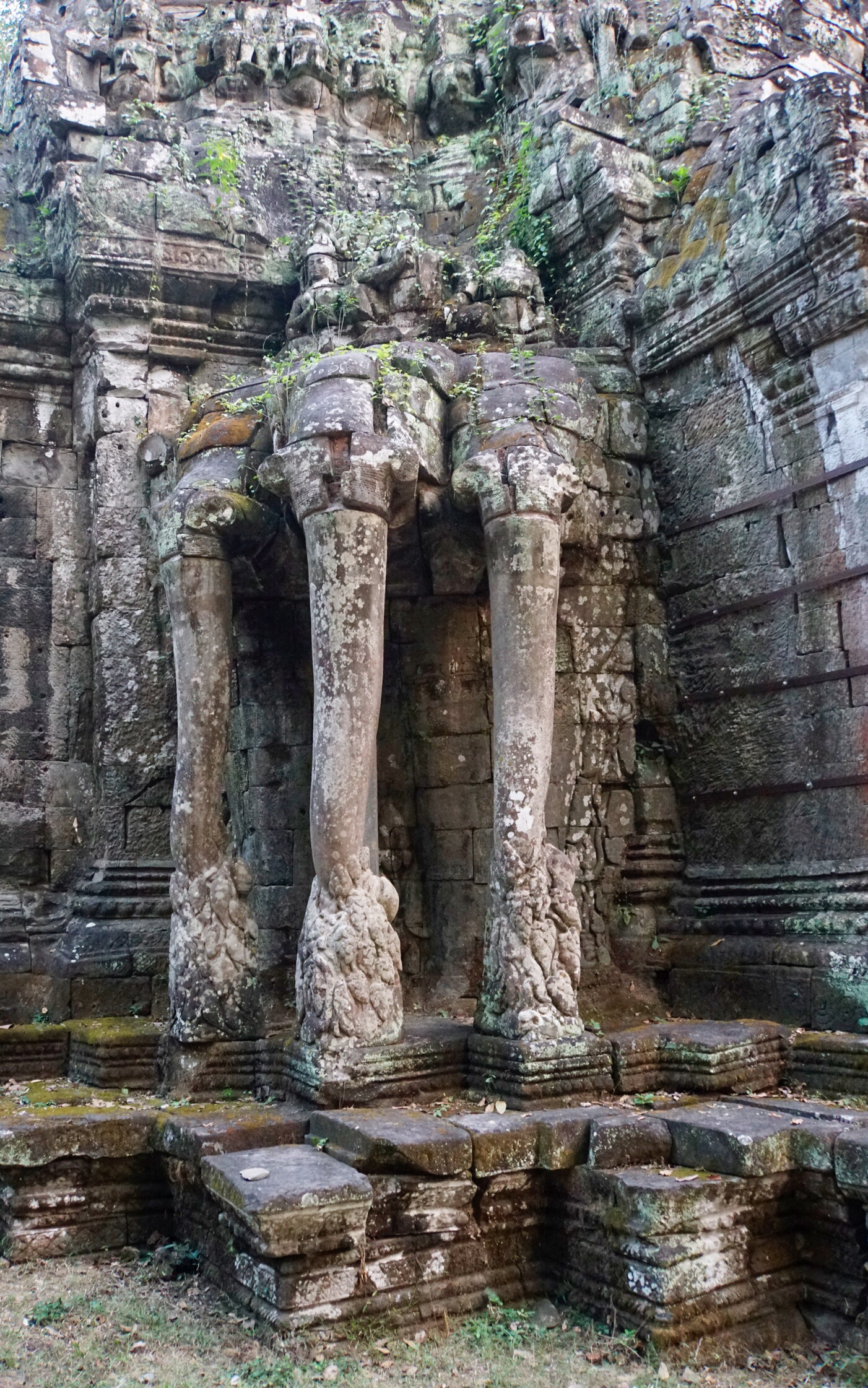 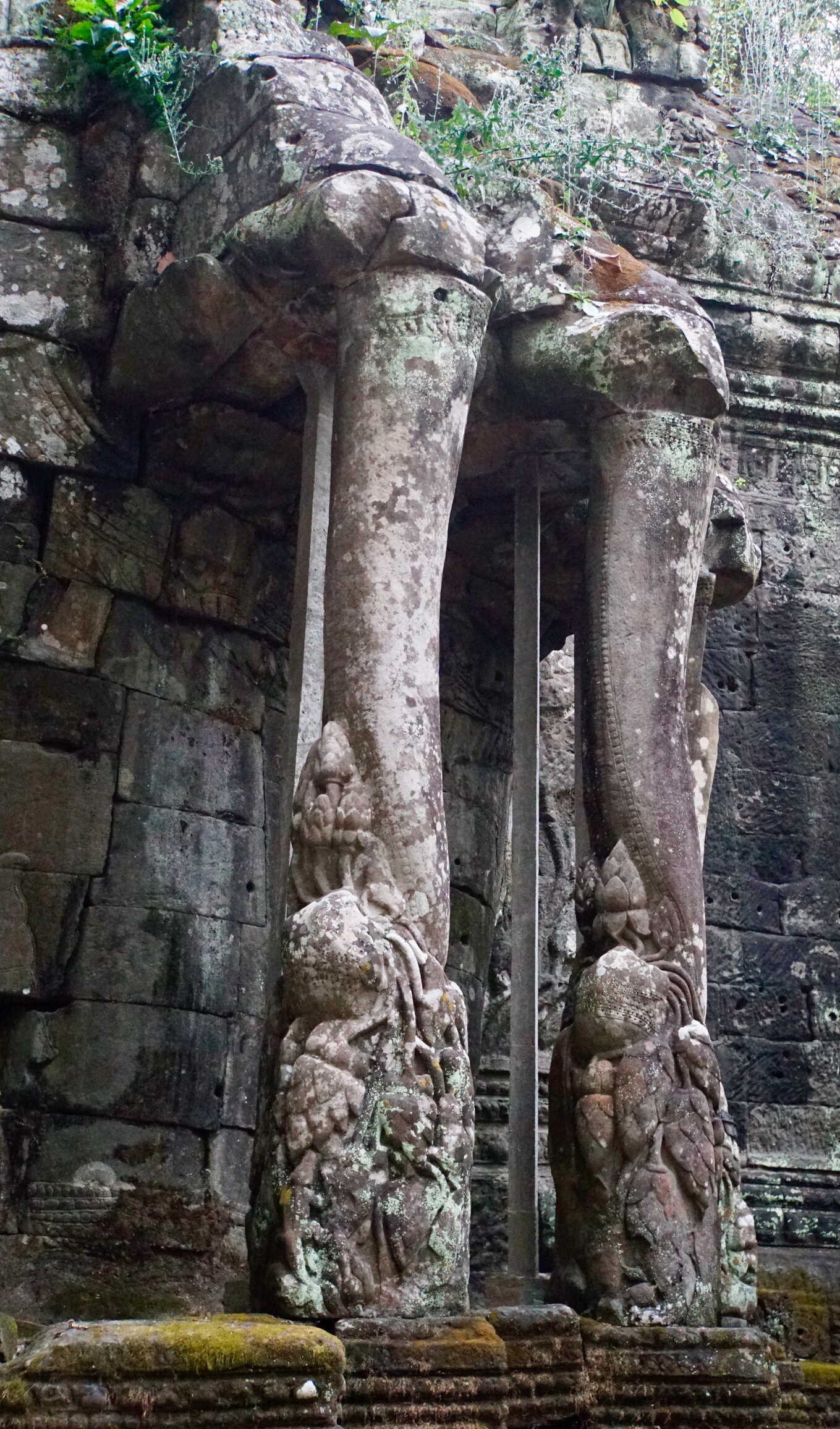 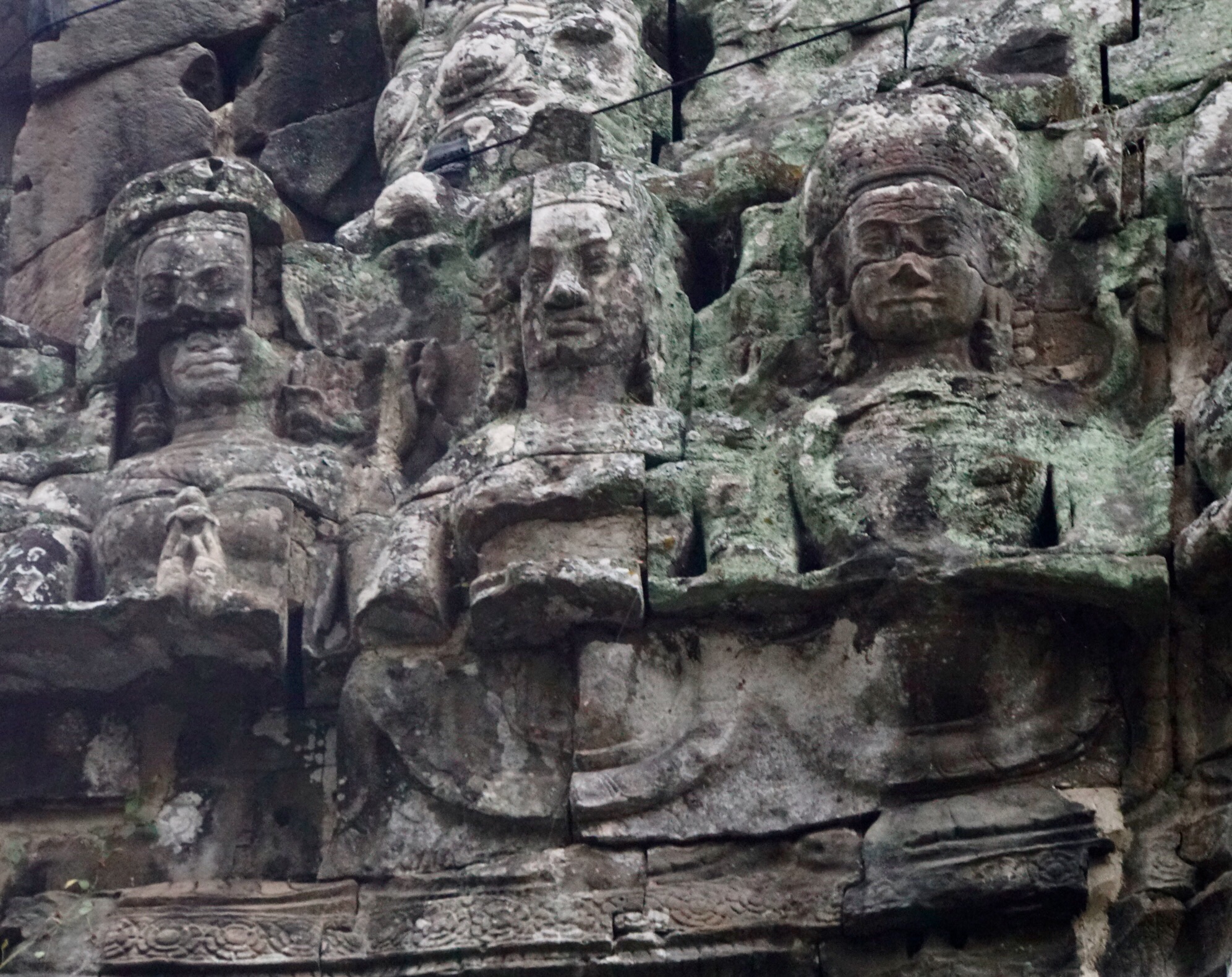 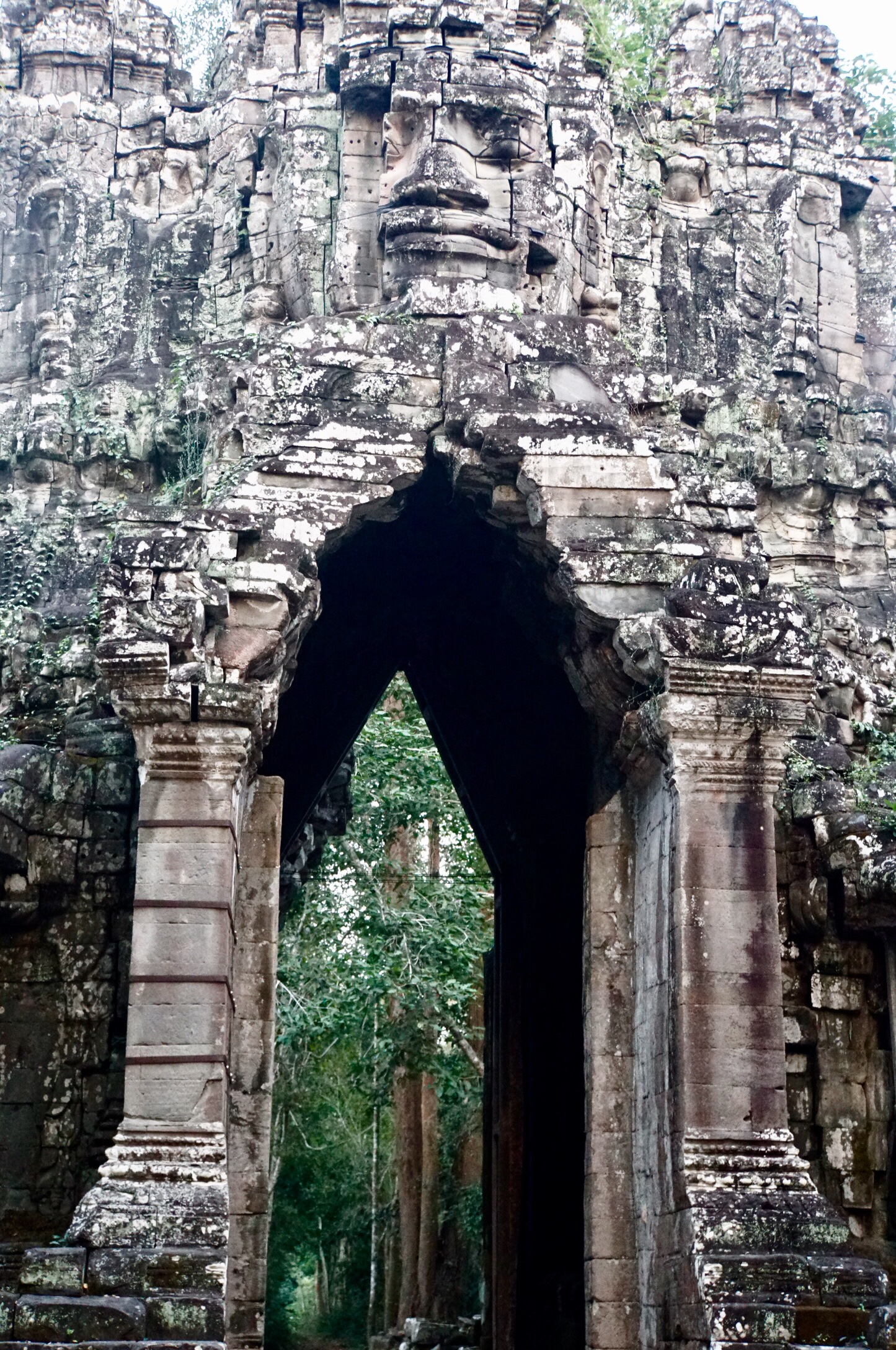 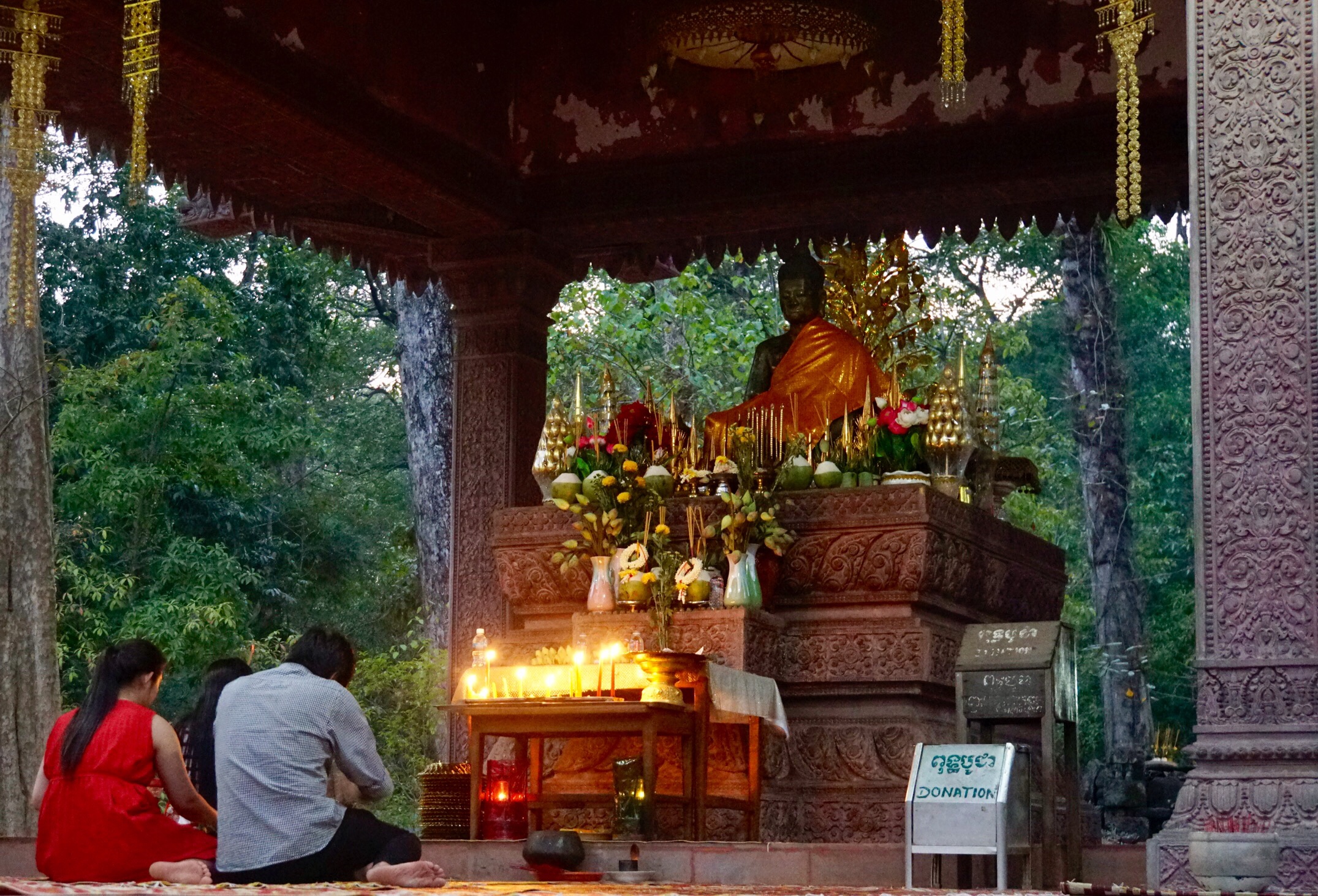 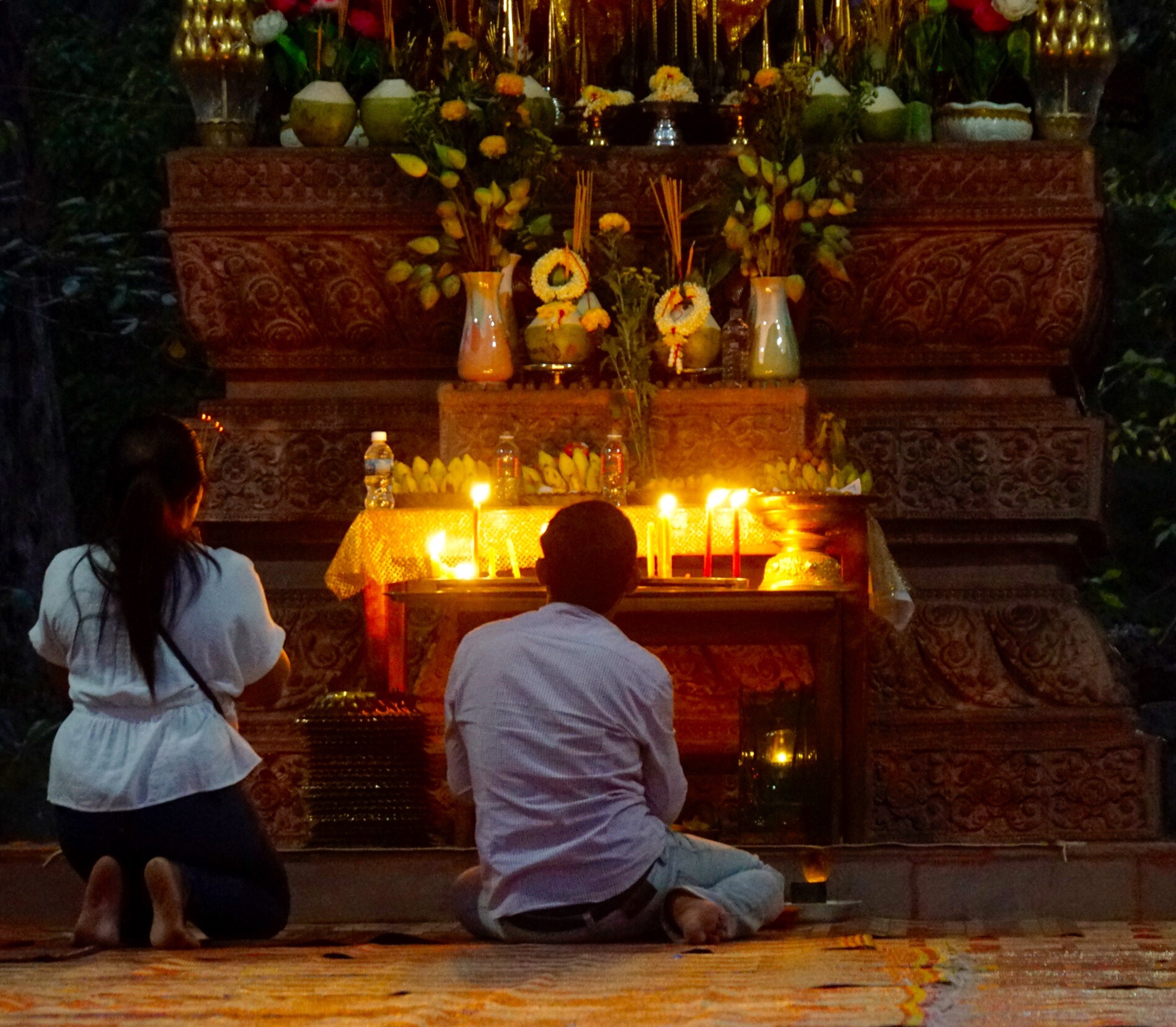
From the Angkor Wat site, we take a tuk-tuk straight to dinner at a restaurant that features Mexican food, and margaritas. Quite exhausted, we head back to the hotel to sleep.
Here is a long, but I think, very interesting description of Angkor Wat (stolen from something called sacredsites.com). Since this is, by far, the single best known place we’re visiting, I’m giving you the full treatment, including a few snide, skeptical comments that I could not resist making.
There are two great complexes of ancient temples in Southeast Asia, one at Bagan in Burma [which Carol and I saw five years ago, and loved], the other at Angkor in Cambodia. The temples of Angkor, built by the Khmer civilization between 802 and 1220 AD, represent one of humankind’s most astonishing and enduring architectural achievements. From Angkor the Khmer kings ruled over a vast domain that reached from Vietnam to China to the Bay of Bengal. The structures one sees at Angkor today, more than 100 stone temples in all, are the surviving remains of a grand religious, social and administrative metropolis whose other buildings – palaces, public buildings, and houses – were built of wood and have long since decayed and disappeared.
Conventional theories presume the lands where Angkor stands were chosen as a settlement site because of their strategic military position and agricultural potential. Alternative scholars, however, believe the geographical location of the Angkor complex and the arrangement of its temples was based on a planet-spanning sacred geography from archaic times. Using computer simulations, it has been shown that the ground plan of the Angkor complex – the terrestrial placement of its principal temples – mirrors the stars in the constellation of Draco at the time of spring equinox in 10,500 BC. While the date of this astronomical alignment is far earlier than any known construction at Angkor, it appears that its purpose was to architecturally mirror the heavens in order to assist in the harmonization of the earth and the stars. [NOTE: aw c’mon, REALLY?] Both the layout of the Angkor temples and the iconographic nature of much its sculpture, particularly the asuras(‘demons’) and devas (‘deities’) are also intended to indicate the celestial phenomenon of the precession of the equinoxes and the slow transition from one astrological age to another.
At the temple of Phnom Bakheng there are 108 surrounding towers. The number 108, considered sacred in both Hindu and Buddhist cosmologies, is the sum of 72 plus 36 (36 being ½ of 72). The number 72 is a primary number in the sequence of numbers linked to the earth’s axial precession, which causes the apparent alteration in the position of the constellations over the period of 25,920 years, or one degree every 72 years. Another mysterious fact about the Angkor complex is its location 72 degrees of longitude east of the Pyramids of Giza. [NOTE: I repeat, REALLY?] The temples of Bakong, Prah Ko and Prei Monli at Roluos, south of the main Angkor complex, are situated in relation to each other in such a way that they mirror the three stars in the Corona Borealis as they appeared at dawn on the spring equinox in 10,500 BC. [well, THAT’S certainly quite somethin, and lots of folks would have totally missed that]. It is interesting to note that the Corona Borealis would not have been visible from these temples during the 10th and 11th centuries when they were constructed.
Angkor Wat, built during the early years of the 12th century by Suryavaram II, honors the Hindu god Vishnu and is a symbolic representation of Hindu cosmology. Consisting of an enormous temple symbolizing the mythic Mt. Meru, its five inter-nested rectangular walls and moats represent chains of mountains and the cosmic ocean. The short dimensions of the vast compound are precisely aligned along a north-south axis, while the east-west axis has been deliberately diverted 0.75 degrees south of east and north of west, seemingly in order to give observers a three day anticipation of the spring equinox.
Unlike other temples at Angkor, Ta Prohm has been left as it was found, preserved as an example of what a tropical forest will do to an architectural monument when the protective hands of humans are withdrawn. Ta Prohm’s walls, roofs, chambers and courtyards have been sufficiently repaired to stop further deterioration, and the inner sanctuary has been cleared of bushes and thick undergrowth, but the temple has been left in the stranglehold of trees. Having planted themselves centuries ago, the tree’s serpentine roots pry apart the ancient stones and their immense trunks straddle the once bustling Buddhist temple. Built in the later part of the 12th century by Jayavarman VII, Ta Prohm is the terrestrial counterpart of the star Eta Draconis the Draco constellation.
During half-millennia of Khmer occupation, the city of Angkor became a pilgrimage destination of importance throughout Southeastern Asia. Sacked by the Thais in 1431 and abandoned in 1432, Angkor was forgotten for a few centuries. Wandering Buddhist monks, passing through the dense jungles, occasionally came upon the awesome ruins. Recognizing the sacred nature of the temples but ignorant of their origins, they invented fables about the mysterious sanctuaries, saying they had been built by the gods in a far ancient time. Centuries passed, these fables became legends, and pilgrims from the distant reaches of Asia sought out the mystic city of the gods. A few adventurous European travelers knew of the ruins and stories circulated in antiquarian circles of a strange city lost in the jungles. Most people believed the stories to be nothing more than legend, however, until the French explorer Henri Mouhot brought Angkor to the world’s attention in 1860. The French people were enchanted with the ancient city and beginning in 1908 funded and superbly managed an extensive restoration project. The restoration has continued to the present day, excepting periods in the 70’s and 80’s when military fighting prevented archaeologists from living near the ruins.
Orthodox archaeologists sometimes interpret the temples of the Angkor complex as tombs of megalomaniacal kings yet in reality those kings designed and constructed the temples as a form of service to both god and their own subjects. The temples were places not for the worship of the kings but rather for the worship of god. Precisely aligned with the stars, constructed as vast three dimensional yantras and adorned with stunningly beautiful religious art, the Angkor temples were instruments for assisting humans in their realization of the divine.
Jayavaram VII, spoke of his intentions in erecting temples as being:
“full of deep sympathy for the good of the world, so as to bestow on men the ambrosia of remedies to win them immortality….By virtue of these good works would that I might rescue all those who are struggling in the ocean of existence.”
January 30. Fabulous eggs Benedict at FCC hotel restaurant (bar pictured below).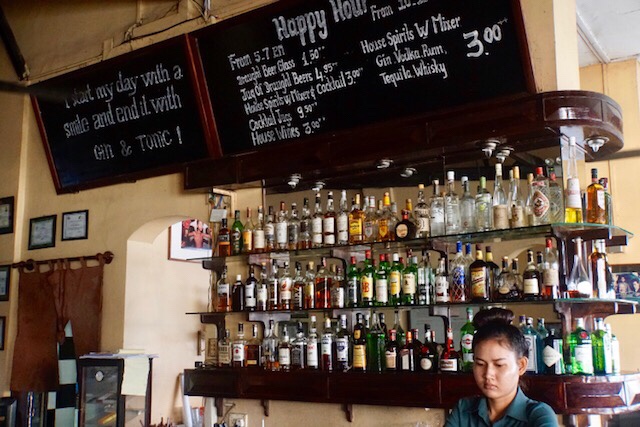
Off to two markets, the first the central market, an ornate yellow%domed covered market that sells many jewels. Supposedly arty shot of windows reflected in jewelry case not very successful. Oh, well.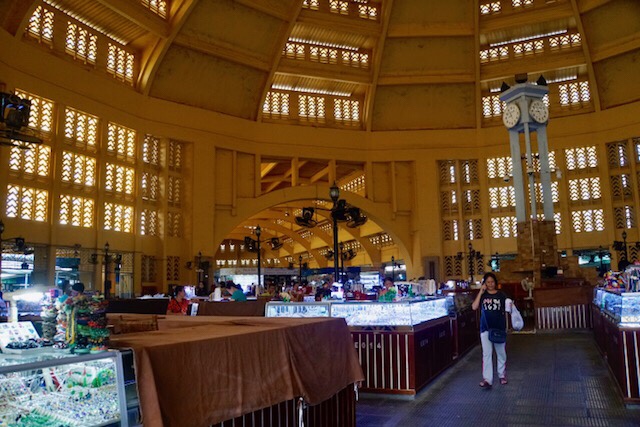 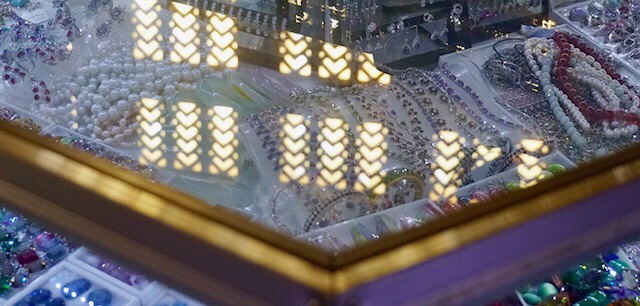
Second is a great local market, which is photographically interesting, despite all the markets I’ve seen around the world.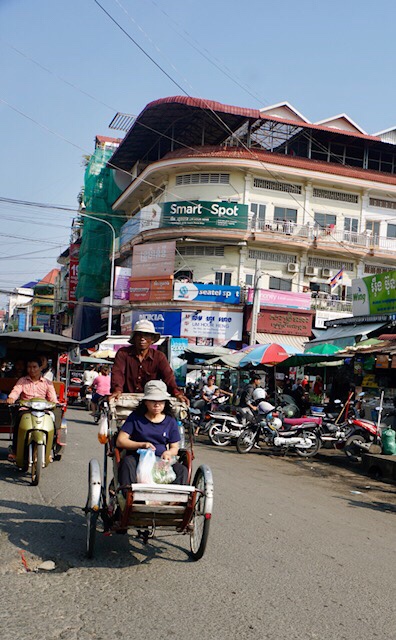 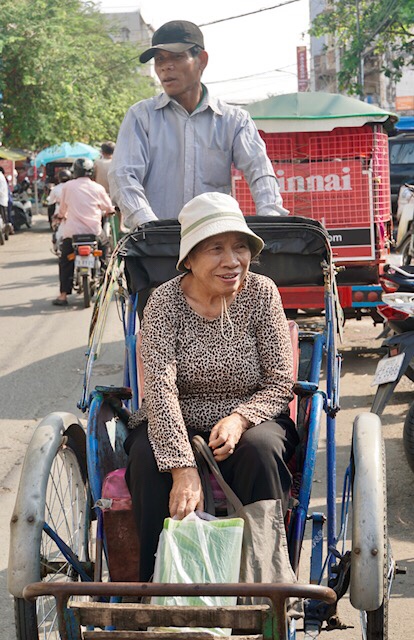 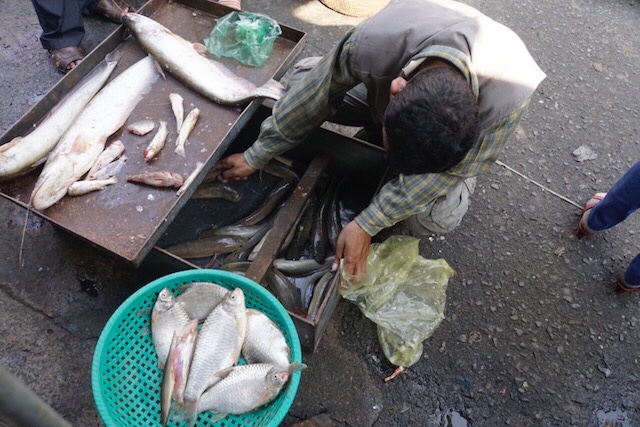 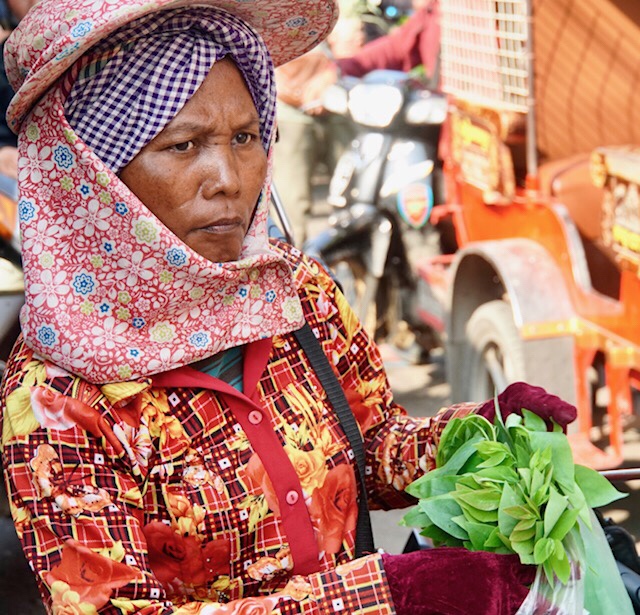 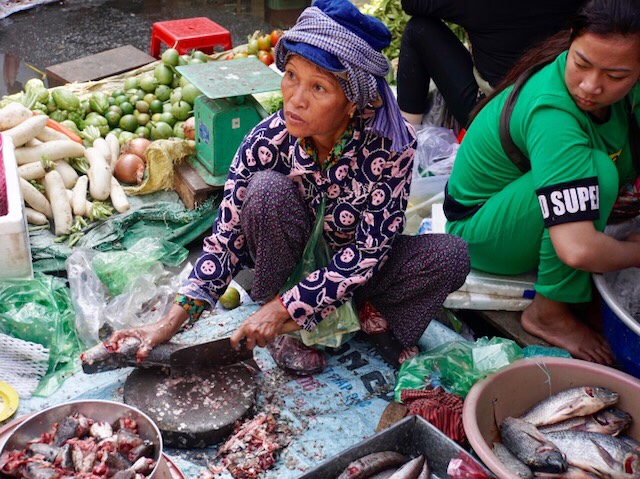 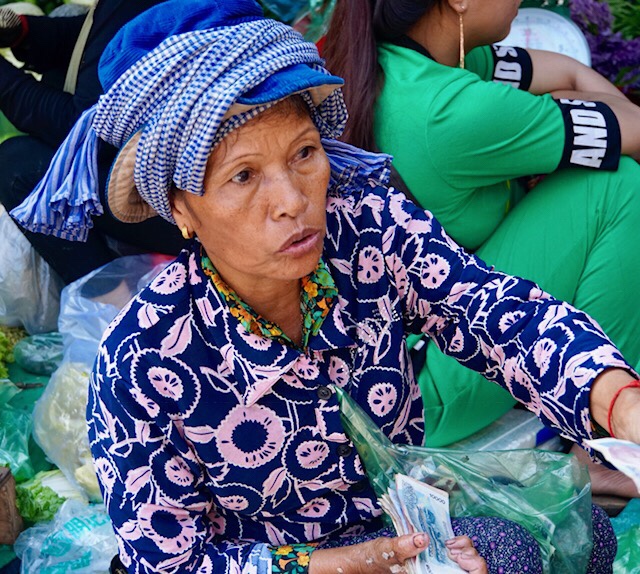
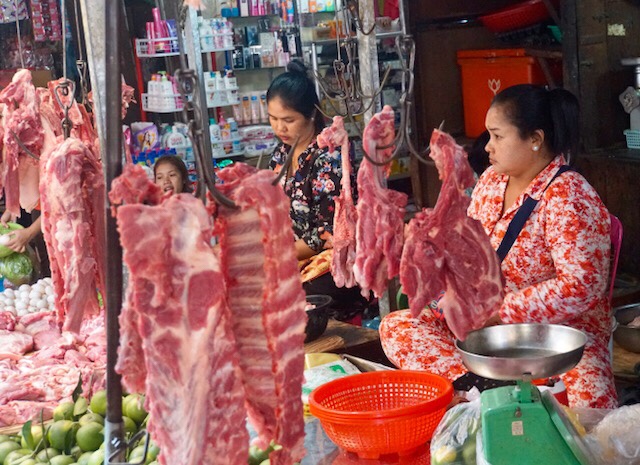 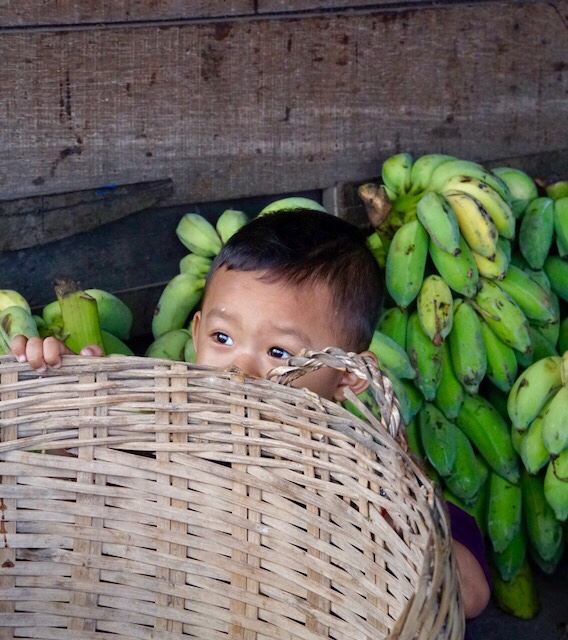 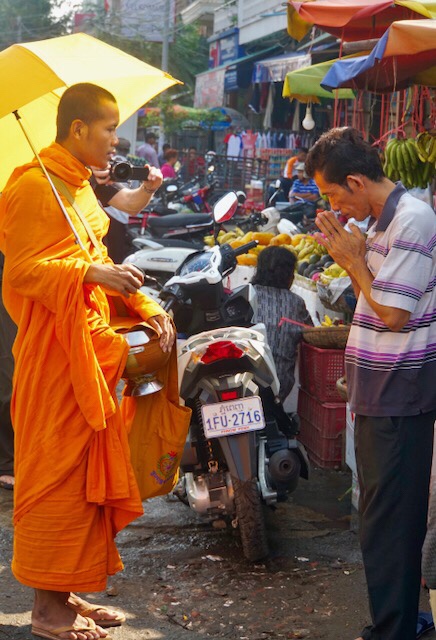
From there, we visit grim Tuol Sleng Genocide Museum, also called S21, the former School converted to a jail and place of torture for prisoners who were later transported to the Killing Fields to be murdered. We have an excellent guide, who speaks very good English and has traveled to the US to visit the Holocaust museum in DC, Alabama (to learn about civil rights) and Stanford University. We see the prison and torture cells, see photographs of all the prisoners and learn more about the horrid details. And are even spoken to by one of two survivors of the prison.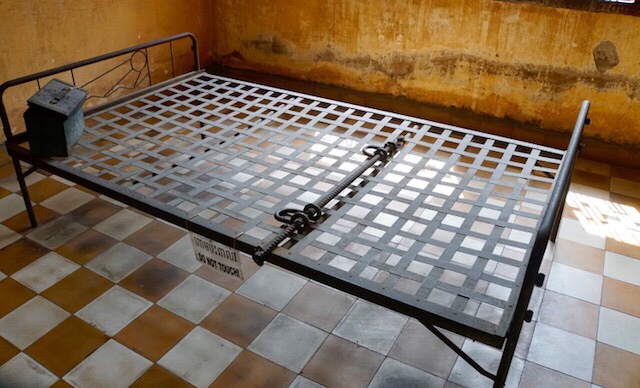 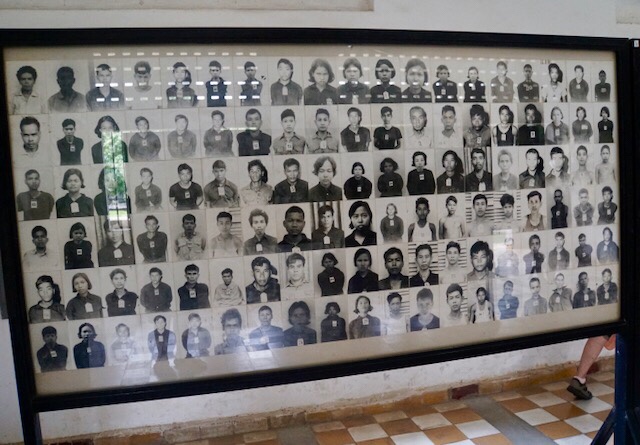 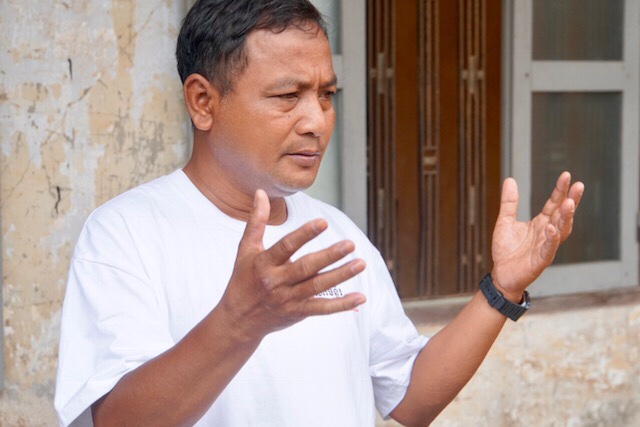
From there we drive to the Killing Fields (All driving is done in tuk-tuks today) and see the memorial there and walk around in high heat and humidity and listen to a tape of what we are seeing, which includes a tree against which babies were killed. Not fun, but important to witness.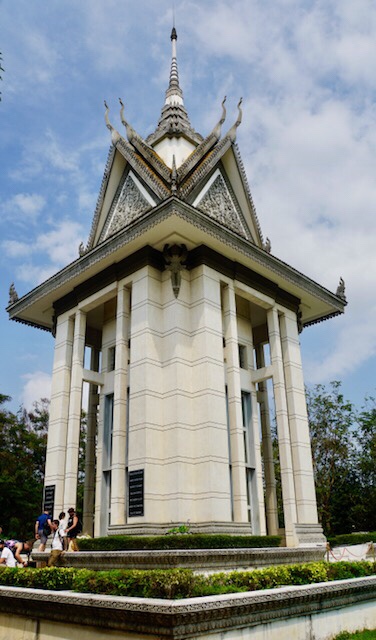 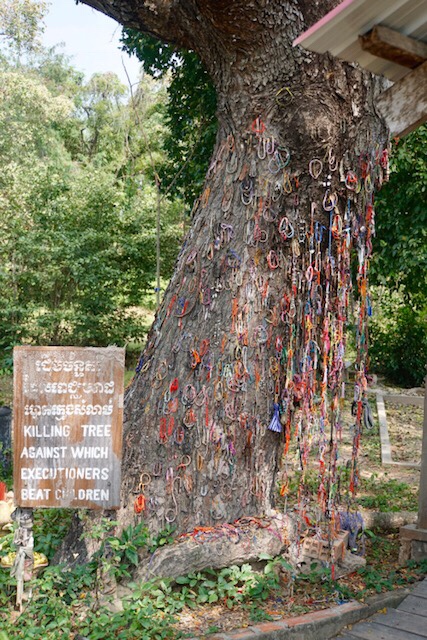
We drive back to the hotel, and Carol and I go to the National Museum, which houses a wonderful collection of old sculpture. We are too tired and had inadequate time and exposure fully to appreciate it, but we were still glad to have seen it.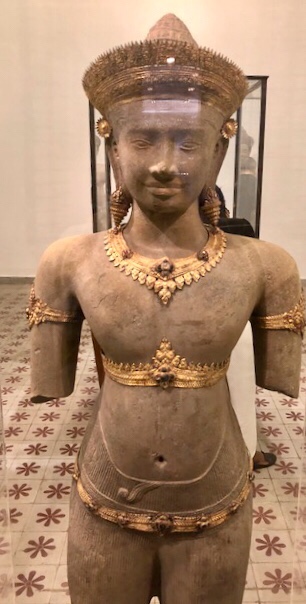 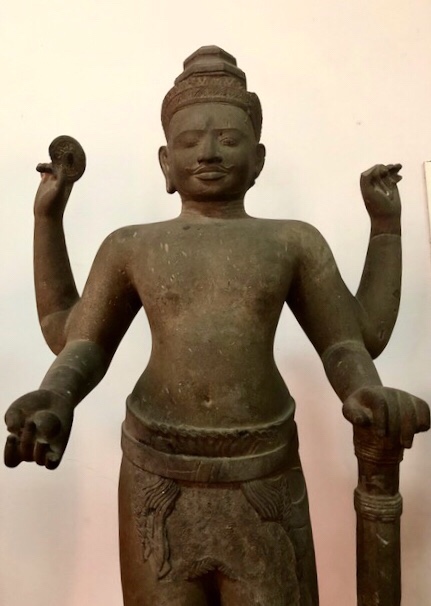 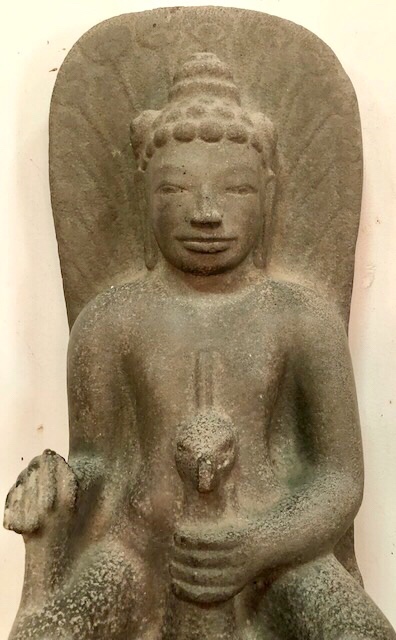
We run into Robert there, and walk to have cold drinks at a café across from the Mekong River. Carol (the whimp) goes back to the hotel to rest, but I walk by the river photographing monks, people selling flowers and cute kids, a great antidote to a rather dreary day. I’ve included too many photos here.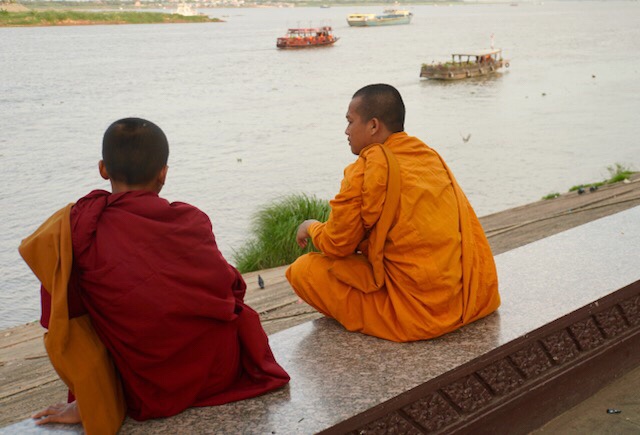 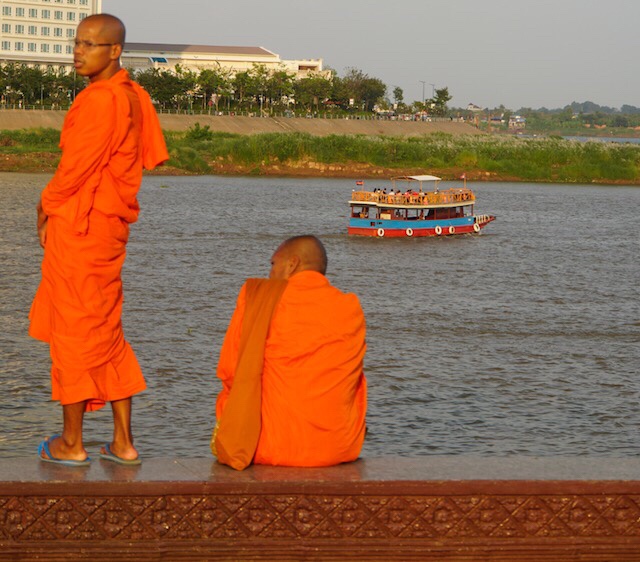 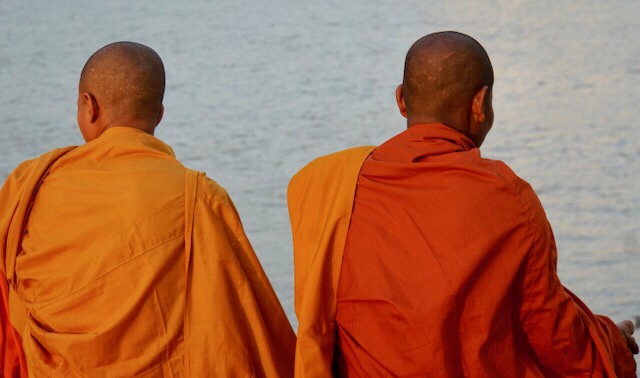 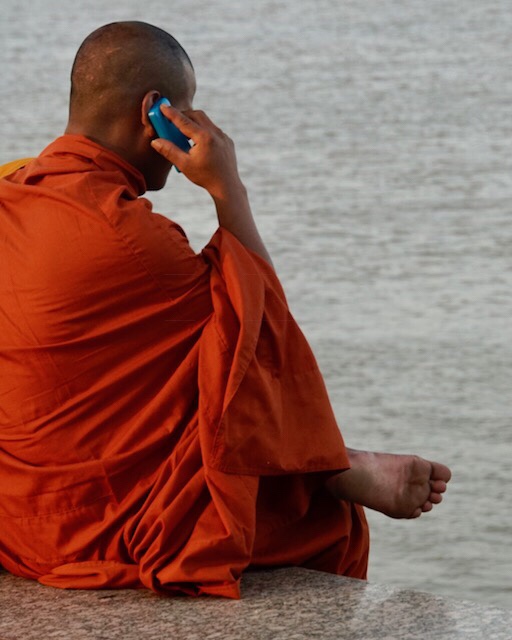
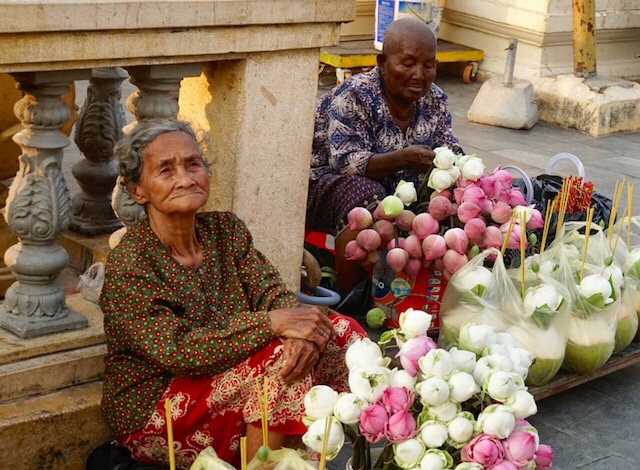 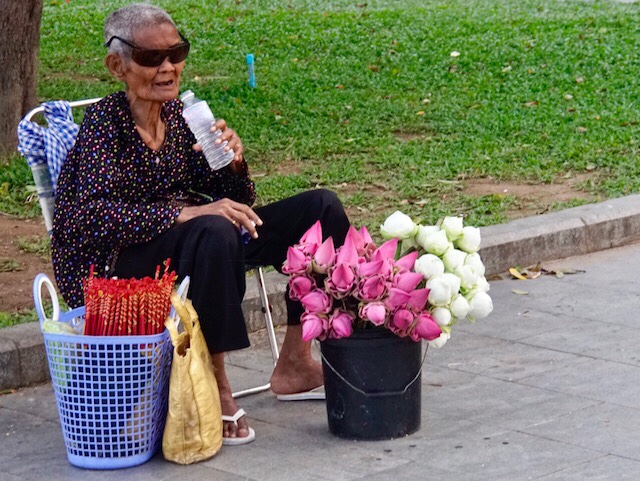 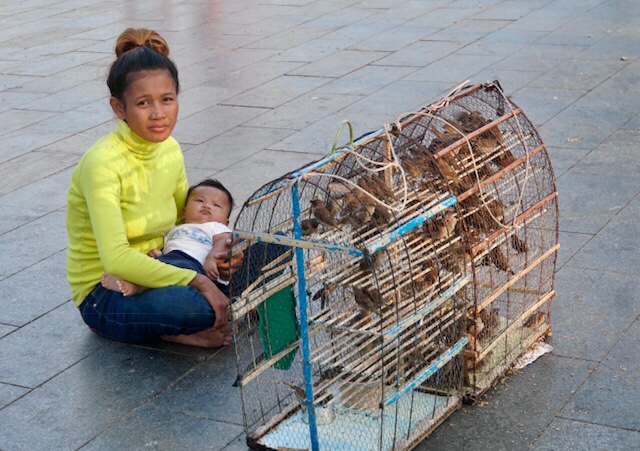 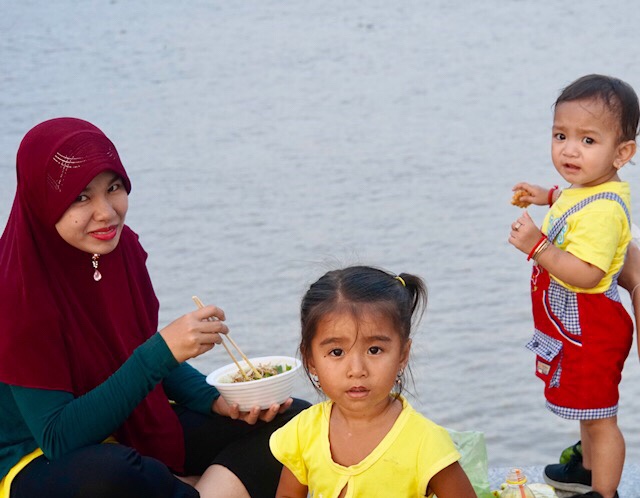 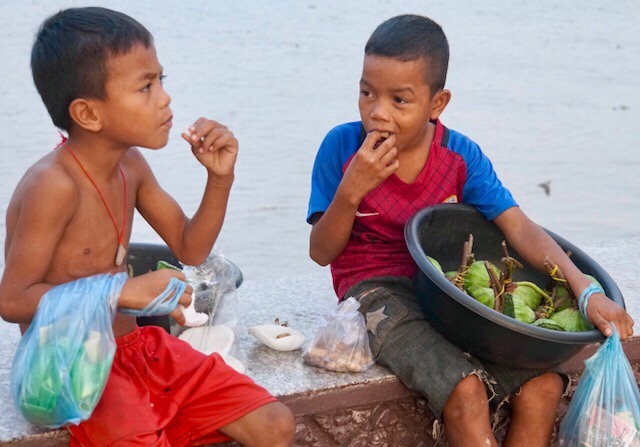  Rather than go straight to dinner, as I’d attended, I have mercy on my dinner companions and run up to the hotel to shower and change. We all the tuk-tuk to a very top Phenom Penh Restaurant, Bistro Langka, for an excellent dinner (the highlight, for me, being a slow-cooked egg appetizer with a delicious sauce). I don’t expect to have trouble sleeping after finishing this damn blog. Rather than go straight to dinner, as I’d attended, I have mercy on my dinner companions and run up to the hotel to shower and change. We all the tuk-tuk to a very top Phenom Penh Restaurant, Bistro Langka, for an excellent dinner (the highlight, for me, being a slow-cooked egg appetizer with a delicious sauce). I don’t expect to have trouble sleeping after finishing this damn blog.
January 29
Travel day, so not too much to report. Up early for more monk shooting. Still don’t know what I’m doing.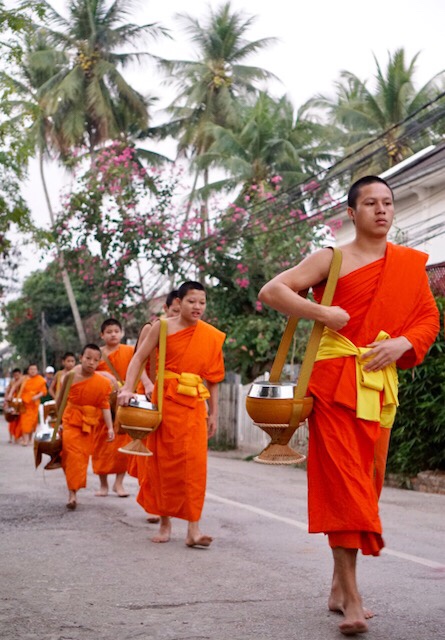 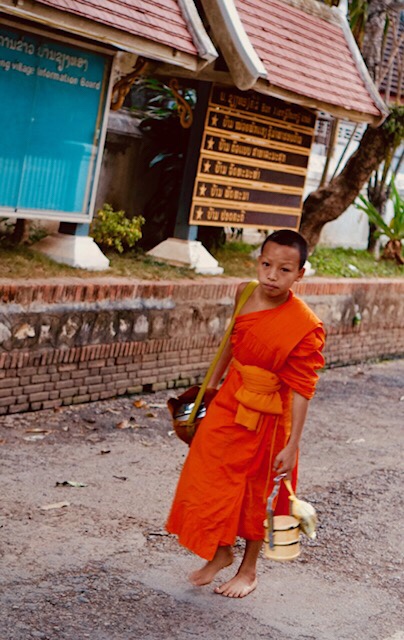 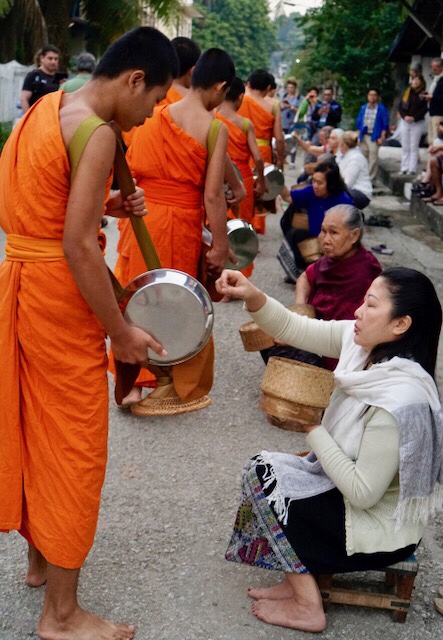 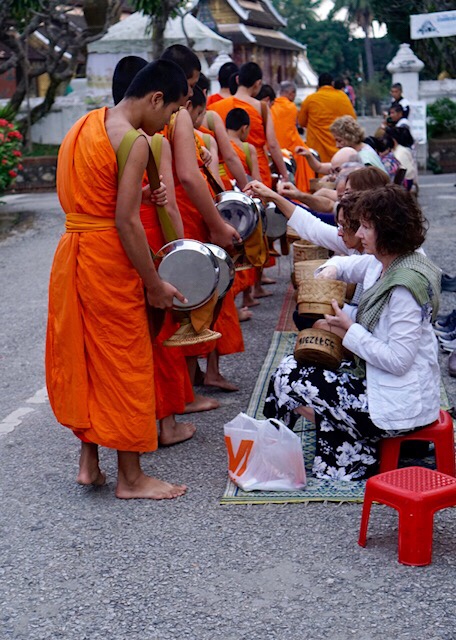 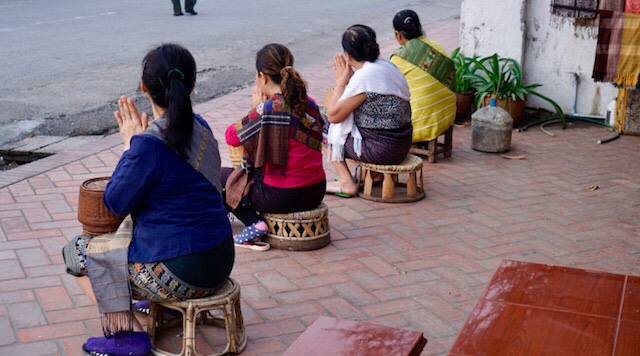 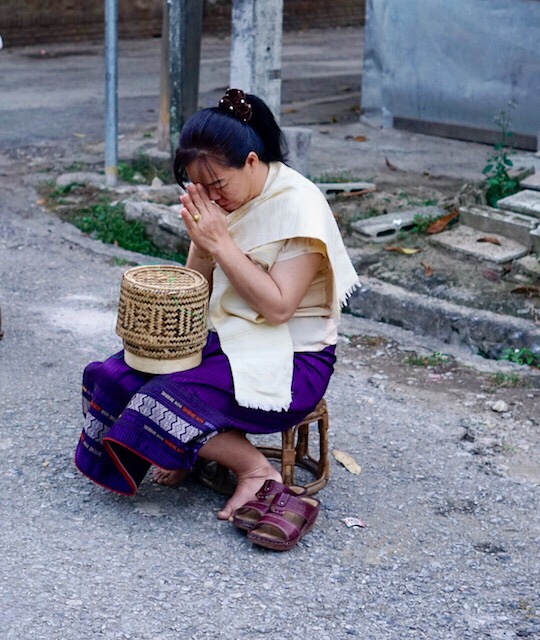 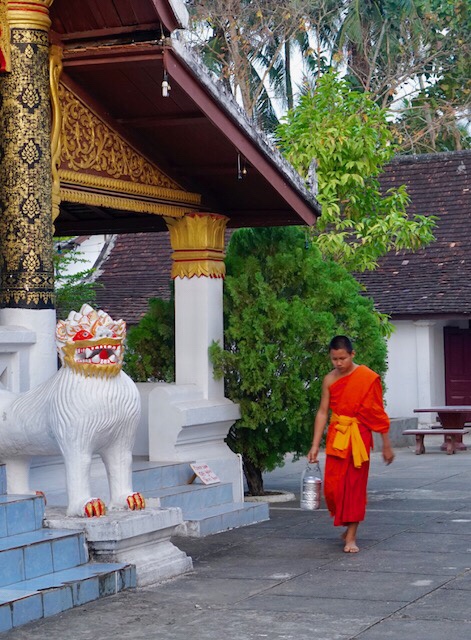 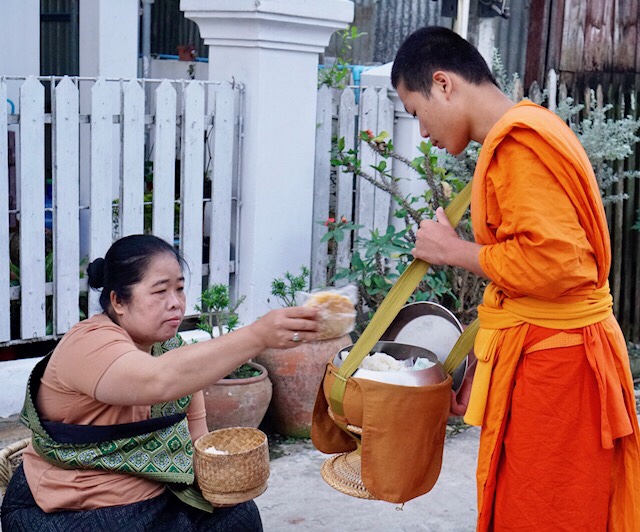
Drive to airport for flight to Bangkok, three hour layover, then on to Phnom Penh. A long day of travel. For the first time since our accident, I’m able to walk without difficulty.
We are staying at the FCC, the Foreign Correspondents Club, a historical building where journalists covering the Vietnam War and other as pets of Cambodia history and politics. It reeks of character and tradition. I’ll take some photos tomorrow. We have dinner on the second floor of the Club, with an overhead fan making the temperature comfortable. A very cool setting. Retire st a reasonable hour to prepare for a full day of markets and Cambodian history tomorrow.
Our friend and neighbor, Ed Bachrach, has been very actively engaged in charitable activities on Cambodia for over fifteen years. He kindly met with us to give us some background on Cambodia and made some suggestions that our tour guide, Karl Grobl, is incorporating into our itinerary.
If you are curious about what it means to really engage with a country, take a look at Ed’s website, www.buildcambodia.org. The historical information below is taken from reports Ed wrote on trips between 2002-04, so they are not current. Still, they provide a personal approach and style missing from other sources.
Ed described Cambodia back in 2002, when he first started going there, as a small nation of just over 10 million unfortunate souls situated between a prosperous Thailand of 61 million and a powerful Vietnam of 79 million. He says that back in 1968 Cambodia was a peaceful little kingdom trying hard to maintain her neutrality. She wanted to become the Switzerland of Southeast Asia.
The fabric of the Cambodian society caught its first snag when the United States began secret bombings in 1969 to destroy Vietnamese supply routes from North Vietnam supporting the assault on Saigon in the south. The king’s failure to respond to these bombings demonstrated his ineffectiveness and undermined his policy of neutrality. In 1970 the Cambodian military took over the country, ousted the king, and ruled corruptly and ineffectually for five years. The military regime of Lon Nol fought the communist Khmer Rouge movement, banishing them to the countryside where they gained sympathy from the peasantry and grew from a small band of rebels to a major insurgency. The relief that Cambodians anticipated when the popular Khmer Rouge liberated the people from the military regime quickly turned into the darkest hell imaginable. In three years from 1975 to 1979, two million Cambodians, a fourth of the population, perished from execution, torture, starvation and disease.
[Here is a bit more about the Khmer Rouge, from another source. In 1975 a horrific and tragic era of Cambodian history began in the reign of the Khmer Rouge. They were led by Pol Pot (or Saloth Sar) also known as ‘Brother Number One’. How many people were killed by Pol Pot and the Khmer Rouge is not known for certain but it was probably at least 1.5 million and it may have been as many as 3 million. Pol Pot declared that history would begin again in Cambodia. The first year of revolution was now the first year of history.
In 1975 Cambodia was a mainly agricultural country. Pol Pot decided it should be completely agricultural. This meant all the people from the towns and cities were forced to move to the countryside. Pol Pot also decided that agricultural output should double in 4 years (a totally unrealistic target). Private property was banned and collective farms were formed. They were supposed to grow 3 tonnes of rice per hectare (again a completely unrealistic target). People were made to work very long hours to try and grow the extra rice. They were given insufficient food and many fell ill and died from a combination of exhaustion and malnutrition.
That was not all. Religion was banned in Cambodia (people caught practicing Buddhism were executed). Family relationships were banned (on the grounds that parents exploited their children). Furthermore the smallest infringement of the rules resulted in execution. Although they were half starved people caught foraging for food were executed. People were also executed for being lazy. Needless to say anyone who complained was executed.
Furthermore the Khmer Rouge murdered intellectuals. Soon people who could speak a foreign language or who wore glasses were executed. This nightmarish situation was only ended by a war with Vietnam. The Vietnamese invaded Cambodia in December 1978 and quickly prevailed. Unfortunately Pol Pot escaped and he did not die until 1998.]
Cambodia was “liberated” again in 1978 when the Vietnamese invaded and drove the Khmers into the wilderness. The puppet regime installed by the Vietnamese fought a civil war with the Khmer Rouge for 14 years. In 1993 the United Nations attempted to conduct elections and resolve the conflict but the U. N.’s farce of an effort sowed more social disintegration and continued warfare.
Finally in 1998 those remaining in the Khmer Rouge were exhausted and began defecting to the government as credible elections were held. The fighting was over. Most Cambodians alive in 1998 had never known peace and so the slow process of reforming a society got its tentative beginning.
Next to sympathy for Cambodians, tourism is the country’s largest export commodity and this industry has just begun to gain momentum in the last two years. The crown jewels of the tourist industry are the spectacular ruins around the northern city of Siem Reap, including the famous Angkor Wat. It is a great irony that the miserable modern day Cambodia contains the majestic monument to one of the most powerful and prosperous empires in human history.
The Vietnamese have certainly known their share of hardship and their 30 year struggle for independence cost millions of lives. But the enemy was always a foreigner and the fighting ended in 1975. The fabric of Vietnamese society was left relatively intact. The Vietnam we experienced was filled with lush fields, robust irrigation canals, industrious people and cities booming with growth and energy.
Cambodia, by contrast, was exhausted. Pale, dried rice stalks sparsely covered the bleached, chalky soil. Small irregular fields were separated by neglected little berms. An occasional bony cow grazed on scrub in the fallow fields. Rivers and canals were dried up and children played and bathed in the muddy stagnant pools filled with trash.
The people of Cambodia are exhausted too. One out of every 300 Cambodians is missing an arm or leg from the million and a half land mines deployed in the civil war. Millions of mines remain in the countryside and injure hundreds of people each year. Everywhere we went we were rarely out of sight of an amputee. People moved slowly in the oppressive heat and filled their days with idle survival going long distances for a little food, a little water, or health care.
The following comes from Brittanica:
Cambodia since 2000
Cambodia continued to face enormous problems: a runaway birth rate, a serious AIDS epidemic, a stagnant economy, widespread deforestation, a climate of violence exacerbated by the ruling party’s unwillingness to abide by the rule of law, impatience among donors at the government’s slowness in introducing reforms, and human rights abuses often traceable to members of the ruling party. By the start of the 21st century, however, the country had begun to stabilize. Cambodia was officially admitted into ASEAN in 1999, which meant that it was constructively linked, perhaps for the first time in its history, to the rest of Southeast Asia.
In 2004 Cambodia joined the WTO, signaling greater integration into the international community. The country also began to bring its AIDS epidemic under control and reined in its birth rate to approach the world average. Cambodia also began to reduce its dependence on logging and to realize the economic benefits of strong garment-manufacturing and tourist sectors. In so doing, it regained the confidence of foreign investors and aid organizations.
The CPP again prevailed in parliamentary elections held in July 2003, gaining more seats in the National Assembly than it had in 1998 but still needing to form a coalition. Negotiations between the CCP and Funcinpec—as well as with the Sam Rainsy Party (SRP), another opposition party that had won nearly as many seats as Funcinpec in the elections—dragged into 2004, however, and were resolved only by midyear. In October 2004 Sihanouk resigned as king, and his youngest son, Norodom Sihamoni, succeeded him. Sihanouk continued to be an influential national figure until his death in October 2012.
The SRP had been a rising player in Cambodian politics since its founding in the 1990s by former Funcinpec member Sam Rainsy. The party experienced a setback in 2005 when Rainsy fled the country before being convicted of criminal defamation against Hun Sen and Prince Ranariddh. Rainsy returned to Cambodia the following year after receiving a royal pardon. Meanwhile, the electoral law was changed in 2006 so that a party needed to win only a simple majority of seats in the National Assembly to form a government. The CPP subsequently ended its coalition with Funcinpec, and the latter party, which was also beset by internal dissension, ceased to be a player in national politics.
The CPP had a strong showing in the 2008 National Assembly elections, winning three-fourths of the seats, while the SRP accounted for one-fifth of the total. In 2010, however, Rainsy had to flee the country for a second time, faced with convictions on what he called politically motivated charges. Meanwhile, in 2012 the SRP joined forces with another party to form the Cambodia National Rescue Party (CNRP) in advance of the 2013 legislative elections. Rainsy was again pardoned and returned to Cambodia to vigorously campaign just before polling took place. The CPP was able to secure only a basic majority of seats, and although the remainder were won by the CNRP, that party rejected the results of the election and boycotted the convening of the legislature. Mass antigovernment demonstrations and labour disputes ensued in Phomn Penh for the remainder of the year. The protests were broken up forcefully in early January 2014 when police fired on demonstrators, killing several and wounding dozens. The political deadlock was finally broken in mid-2014, when all legislators took their seats.
On July 10, 2016, Kem Ley, an activist and political analyst critical of the government of Prime Minister Hun Sen, was shot dead while stopping for coffee at a gas station in Phnom Penh, Cambodia. A suspect was arrested near the scene, and within hours a leaked video showed him confessing to police, saying that the reason for the murder was a dispute over money.
Opposition leaders dismissed the video, saying that the killing fit a pattern of violence against critics of the government. Just days before his death, Kem Ley had given an interview in which he called for greater transparency concerning the business interests of members of Hun Sen’s family.
In 2009, after years of delay, the first trial of the Khmer Rouge Tribunal (officially the Extraordinary Chambers in the Courts of Cambodia) got under way in Phnom Penh. The first defendant, Kaing Guek Eav (better known as Duch), who had been in custody for some 10 years, had been in charge of the notorious S-21 prison during the Khmer Rouge regime. He was convicted in 2010 and sentenced to an additional 19 years of imprisonment. Two more former high-ranking Khmer Rough officials, Khieu Samphan and Nuon Chea, were convicted in 2014 and received life sentences. Another defendant, Ieng Sary, died in 2013 before a verdict could be reached.
|
|




























































































 Rather than go straight to dinner, as I’d attended, I have mercy on my dinner companions and run up to the hotel to shower and change. We all the tuk-tuk to a very top Phenom Penh Restaurant, Bistro Langka, for an excellent dinner (the highlight, for me, being a slow-cooked egg appetizer with a delicious sauce). I don’t expect to have trouble sleeping after finishing this damn blog.
Rather than go straight to dinner, as I’d attended, I have mercy on my dinner companions and run up to the hotel to shower and change. We all the tuk-tuk to a very top Phenom Penh Restaurant, Bistro Langka, for an excellent dinner (the highlight, for me, being a slow-cooked egg appetizer with a delicious sauce). I don’t expect to have trouble sleeping after finishing this damn blog.







